#I really wanted to do “2000 weird cartoon style�� in second one
Explore tagged Tumblr posts
Text
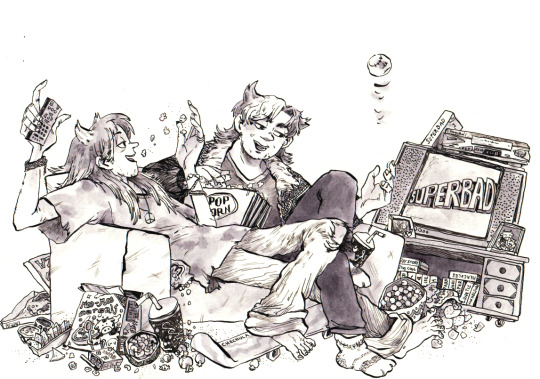
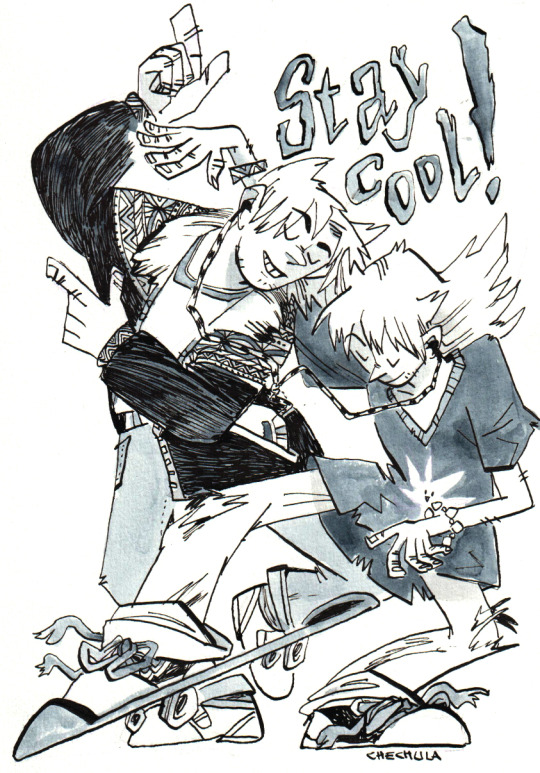
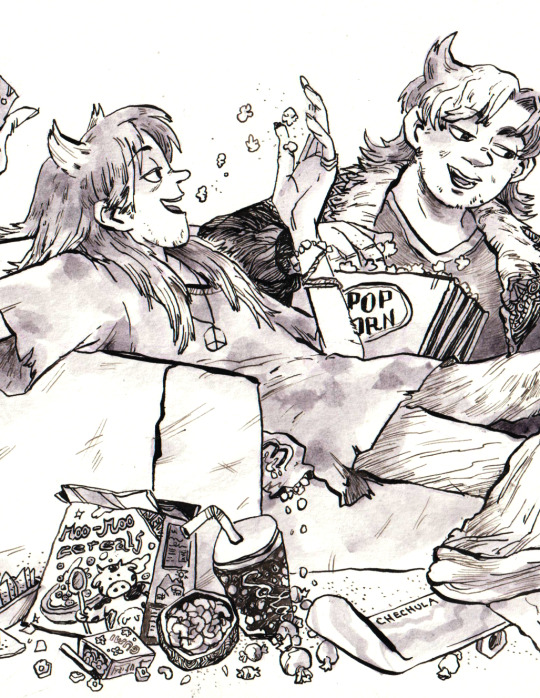
Two very cool guys from @kezokinos and @bluefbread ♥ I had so much fun drawing these, thank you for this commission ♥
(commissions are still open )
#staycool#gred#forge#superbad#I really wanted to do “2000 weird cartoon style” in second one#I hope it works
224 notes
·
View notes
Note
Before we get to Disney, I'm gonna make a little detour with Total Drama. Since you talked about Island 2007 and Action in the late 2000s Cartoon Network shows ask, may as well try for the other seasons (not including the two reboot seasons since you haven't seen them yet). Who is your favorite character from each of these later seasons/spin offs: World Tour, Revenge of the Island, All Stars, Pahkitew Island, Ridonculous Race, and DramaRama? And as a bonus, I'll also throw in 6teen as well since it shared a lot of staff with Total Drama and it's implied to be in the same universe as Total Drama (plus Jude being a main character on DramaRama, with Nikki getting a cameo and mention in one episode of that show as well).
Oh i've seen most of the first reboot season just not the second yet (I'm waiting till we get a us airdate. I might still binge it , but I want to have it synch up with the us airdate to put it on my best of list. ) So it's included. Also big thanks for including 6teen 6teen: Used to be jude but I think it might be Jonesy.. while he coudl be an ass, he was an entertaining ass who had a lot of style and his realtionship with Nikki was just.. pure greatness. The best. The show itself is great and one I need to watch again, a nice slice of life that uses the mall setting well. Honestly wouldn't mind a revivial just maybe update it to a more modern outdoor mall or have the mall not doing great. It also had a stand in for christopher walken so that's always good. A funny, fun down to earth slice of life show.
Stoked: Dont' really have a faviorite character but since you included 6teen why not. I never quite vibed on this one. I have friends who did and I like the CONCPET, teens working at a fancy resort ala that one arc of saved by the bell.. but the cast felt mostly like copies of the 6teen cast just transplanted to a surf setting. The oppistes attract couple, the chill as hell guy, the sporty girl, the heriess forced to work.... it felt like a weak rehash and that they could've done way better.
World Tour: Noah and Tyler. I was going to say noah with tyler as a tie but.. fuck it they both get the gold as World Tour took two fan faviorites who had a good moment or two in island, but not much else : Noah left very early and tyler was primarily there to cause tension between heather and lindsay that never really payed off as while Island is still excellent it does have a habit of setting up things that never go anwhere (See the whole idea of a tribal council type thing during brunch of disgustingness.
Noah was great, getting to be sarcastic surrounded by mostly idiots, and getting a fun odd couple friendship with Owen. Action hadn't been exactly kind to owen, having him stay around way too long only to come back for boring subplot that didn't really pay off, only serving to get best boy harold eliminated when Duncan and Harold made the most sense for the final two. So instead we got Owen being stupid, and Noah reacting to it while still being supportive of his pal, a perfect foil for Tyler's dumbassery and dj's weird runner, and overall a character who should've stuck around a bit longer.
Tyler meanwhile was just adorable. The running gag with lindsay was great, but also got a truly heartwarming payoff, while his tendencies to fall on his face got nicely exagerated making him nature's perfect butt monkey.
As for world tour itself it's a decent season and one of the franchises best... but is a bit overhyped in hindsight. The first half DOES live up to said hype: a good cast, the series best antagonist, Heather in a fresh roll stuck on a team that dosen't want her while combatting a villian she has both great chemistry with and who is running circles around everyone. It has some stupidity like Leshawnas and Bridget's cheating on their partners, but it largely works. The second half, while having a great finish and some good songs.. is a step down. The gwen and duncan and courtney drama drags on WAY too long and elemnates gwen for so reason as with Blanely getting added post merge, we didn't need three antagonists and without the gwen friendship she was firmly back in that roll. Cody dosen't really get any devleopment despite the clear room for it, Sierra is one of the worst contestants in the shows history and her one gag is awful, and that gets only worse as the show goes on and there's less people to protect cody from harassment. It's still a solid season, the songs are great and even the second half has some good jokes, but it's one that looses steam as it goes. It's still one of total drama's best, a solid fourth place for me and third beofre the reboot aired... but it's still a tad weak like action, if still an improvment over it.
Revenge of the Island: Is excellent. It's not perfect, a cast member or two dosen't work (looking at you sam and ann maria), the depection of DID with mike is messy as all hell (though I still LIKE mike DID should not be a throaway joke or quirk) and the Ezikel thing continues to be dumb.. but it's flaws.. don't overshadow a great season. It's challenges may be forgetable, but it's cast is fantastic, with Scott being an easy second faviorite antagaonist as his team killing strategy is unique and fun, standouts like Dawn, Cameron, Brick and B, and easily the best final challenge in the shows history: brains vs brawn. Faviorite is Cameron. He's shy, hilarious and his friendship with mike works REALLY well: the two have great chemistry and trying to help mike with his mpd is a nice subplot and one of the few times it's not used to have WACKY CHARACTERS ABOUT YUK YUK. He also gets good character developments, going from a shy scared guy mostly carried by having good friends or working with one of the main villians out of necisity, to a truly self reliant young man who wins the million (In the verison I watched and frankly my canon) and earns his victory.
All Stars: Scott again, whose turned into a down bad butt monkey and it works: he can't team kill again, there are better villians who outclass him, so having him be a comedy asshole not only gives him the buckets of karma he deserved from Revenge, but also makes him oddly adorable and I wish they hadn't half heartedly broken him and courtney up. They worked. The season itself.. is the series worst so far. and of the franchise. I may not like Pahketew or Dramarama and have some issues with action and world tour... but their at least.. watchable. All Stars is a series of bullshit elimeinations, recycled jokes, plots that make no sense, sinking duncan and gwen which while not a ship I liked is taken to stupid lengths here, and a one note villian. Not to mention the finale which while having easily my faviorite total drama line ever

Wastes a good obstacle course on possibly murdering old contestants and the bullshit RESET BUTTON. Just.. the reset button. So much stupidity, not enough fucks to give to go into why pressing a button to cure mental illness is fucking embarssing. I do like Gwen and Cameron's relationship, it's somehow the most healthy she's ever had which I admit is both bogus and sad, but it's really sweet and that cheek kiss is adorable. Pahktew Island: Is boring. It has a few great contestants in Shawn, Ella, Amy and Samey... and not much else. Most of the cast is kinda boring, the sky and dave thing can eat my entire ass in a bad way, the challenges are forgetable and sugar just fucking sucks, taking the problems with ann maria and sam of just being a giant refrence and compounding it by also being the main villian and thus far more prominent. All Stars is far worse.. but I have more to talk about. I forgot Pahkitew soon after it aired and have no real desire to go back for a refresher.
Ridonclous Race: Ridonclus Race is , putting it with the others, my third faviorite season. I didn't think to include it when I was talking about world tour earlier but since it didn't get a second season (though I hope it does get revivied one of these days) and functions similar writing wise, I lump it in these days. Race was a MUCH needed breath of fresh air after the awful production season before it, and if brought back ever has a nice way to bring back old contestants now their all older thanks to the time skip. My faviorite character is hard as the goths are great, Noah and Own once against slap... but I give it to Kitty and Emma, the two have a great dynamic, kitty being adorable and fun to follow and Emma being driven, and their later hooking up with Noah and Owen not only provides great chemistry (Emma and Noah are adorable as hell and Kitty and OWen could work once she's you know, legal), but one of the seasons best subplots. Overlal the show is just solid: While the best friends and daters suck, their pretty much the only long standing teams that are a pain to watch: everyone else works, the shakeups in both a new format of reality to parody and a new host whose not a monster, tons of great arcs and jokes. This season is an easy faviorite of mine and the series third best.
Dramarama: Jude. including him is weird as fuck but i'll take it. The show itself.. I saw a few episodes, coudln't get into it and while it's readily avaliable on max I have no intention too. Why they coudln't be in elementary school, which would provide a bigger cast and most of the same stories is beyond me. Or just have a continuity reboot with everyone from all three generations at the same high school and also the 6teen cast is there why not. This ones more annoyign for the wasted potential of a fresh total drama continuity with whoever they wanted to pick and choose from the series massive cast> it's not as bad as all stars but ceases to make me give a fuck either.
Reboot season 1: God this is good. Faviorite is the hockey players, though a lot of the cast is good (I also like damien, scary girl, and bowie), my love of letterkenny means I can't.. not love these guys as they have a LOT of riley and jonesy energy, but without their accidental jackassery> Their just purehearted jocks with suprising strategic game, and Raj and Bowie's romance is great, as is Wayne hoping Raj will tell him soon so he can ship them openly. THeir just the best. The season itself is my second faviorite, though RR i still closely behind it. The new cast is almost all bangers and even ripper, who annoys the fuck out of me, is at least entertaining as his jackassery goes SO over the top sometimes it's funny. Chase is the only one I really TRULY hate, being an abusive asshat who won't shut the fuck up and adds nothing comedicaly, which says something. The cast is just great filled with good ideas, great chemistry and some all time standouts.
The challenges are also a step up as I hadn't realized till this season that aside from RR (That had the beneift of both going global again like world tour and the amazing race format).. the challenges were just forgetable. Revenge had maybe three that stuck out. In contrast all the challenges for the reboot are pretty good. Id idn't care for the farting episode with real life dinosaurs or the puking challenge, but I can at least give that one points for chef's cooking show style intros that while gross were hilarous, and the rainbow vomit.
It's a solid season, lots of fun to watch and a sign that even if season 2 hits some rough waters the show can still go and the time off for spinoff babies may of been good. It gave the show time to refocus, think of new ideas, and update it for the modern era and it's payed off wonderfully.
1 note
·
View note
Text


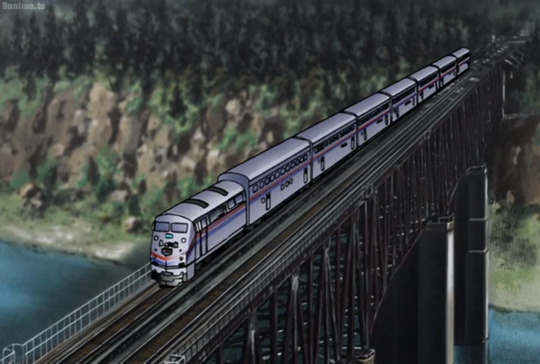
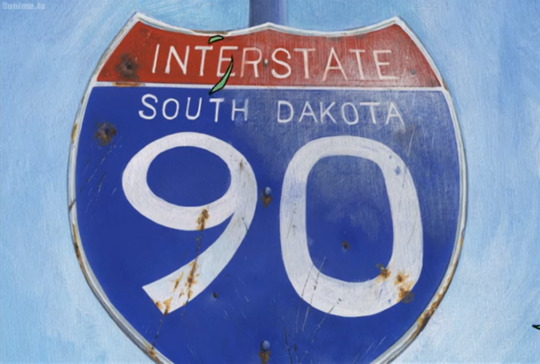

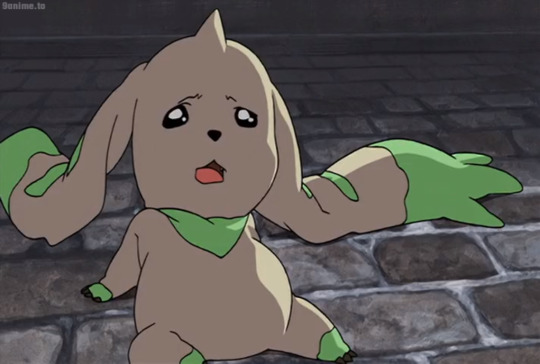
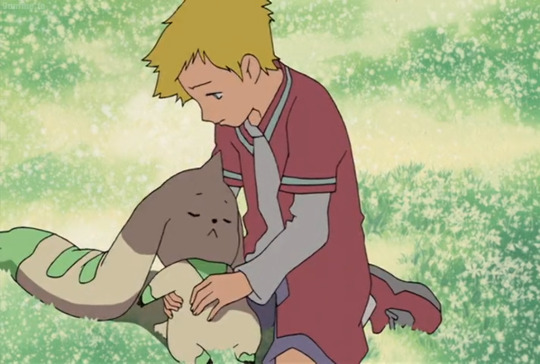
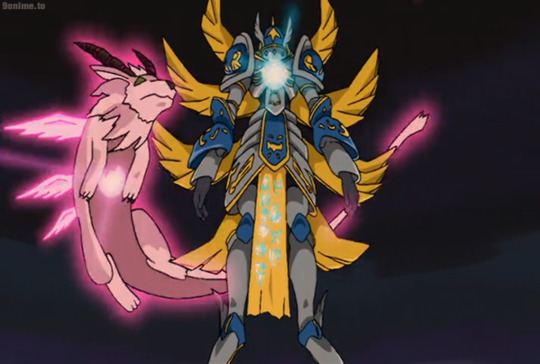


Digimon Hurricane Touchdown / Transcendent Evolution! The Golden Digimentals (2000)

This was weird...I didn't really like it. It was pretty at least?? Okay pretty might be an understatement, some scenes were aesthetic af. It was just the writing, pacing and inconsistencies in the animation that tanked it for me. I got so bored that I took an hour break 30 minutes in lol. I thought I'd be mad that they cut these movies (OVAs?) up for an American release, but now I'm thinking that might have been the right move...
Digimon introduced: Gummymon, Chocomon, Terriermon, Lopmon, Antylamon, Wendigomon, Gargomon, Kerpymon, Seraphimon, Magnadramon, Rapidmon,
Notes:
-Dang those titles are long! I wonder why Digimon has this weird history of having movies that aren't really movies. I read on some wiki that the Ojamajo Doremi movie was sandwiched in between the two parts which is...a choice (kinda reminds me of the Angela Anaconda thing lol).
-I liked Wallace's design, voice and concept (even though he couldn't pronounce his own name lol), but I didn't really like him being so aggressively flirty with the girls? Felt awkward and forced. Also, Western stereotypes strike again!
-How could Wallace possibly not know about the digital world by now?
-The concept of twin digimon is really cool and Terriermon and Chocomon are adorable. I liked Terriermon's voice a lot. I thought he might be voiced by a young child, but I guess his VA was in her 20s...
-I'm kinda confused about who worked on this. There were times when it seemed like there was an attempt to mimic Mamoru Hosoda's style but then it would switch to a style with really heavy line-art that was like almost the opposite style. Also, they would sometimes freeze frame randomly or use shots from the show which was jarring for a theatrical release.
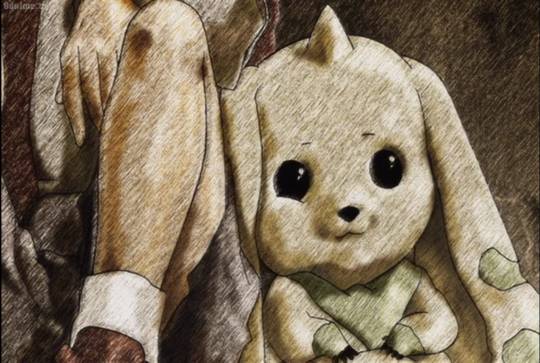

(Look at this cursed Patamon with lips!)
-Some of the best shots in this were close-ups of things (a digivice, a mouse, an airplane, etc.) Like whoever did the background/object artwork really popped off.
-Mimi's star hair looked so good in this style! It looked awkward in the TV series but here they made the stars kind of holographic and dialed back the colors.
-Literally every new digimon introduced in this was great, but I feel they kinda blew the Seraphimon and Magnadramon introduction. They appeared for like two seconds and didn't do much. If you're going to introduce digivolutions that epic, they should probably take the final blow in my opinion (in other words, they should have just been introduced some other time).
-A Wendigo reference!? In MY Japanese cartoons?? I guess they did their North America research...His design is pretty wild, but I like it.
-Not a whole lot of explaining going on this movie. Chocomon "disappeared one day" and then reappears as Wendigomon and is all confused. Where did he go? Why did they treat all of Chocomon's digivolutions as some kind of disease? Usually when digimon digivolve they call them by their new names, but they never used anything but Chocomon. Were the "bad digivolutions" kind of like Skullgreymon?
-Terriermon's ears are spectacular. I love that they drag on the ground and that they puff up when he flies. A+ mon design.
-I kinda wanted to laugh when Wallace was like "there are digimon in Japan!?" But then I remember "digimon" is a portmanteau of two English words so there's that. Why do his digimon mostly speak in Japanese? For convenience I guess, but it's confusing...
-Seeing Hikari and Takeru ride Amtrak was a hoot. Also, I think this is my first time hearing Denver mentioned in an anime (my friend used to live there lol).
-Why did this billboard look so weird?

(It looks like an animation/editing mistake?)
-The whole "random American movie character" thing reminded me of Melissa from the first My Hero Academia movie. I feel like anime has the tendency to go abroad when they want things to feel special.
-Kinda funny how the dub censors guns but then there are characters like Gargomon who literally has funs for hands. Good luck with that!
-Everyone's baby versions were adorable. I especially liked Daisuke's lack of teeth :)
-Did they break a rule at the end there with Chocomon's digiegg reappearing in the real world? Probably.
Yeah this plot was just...weird. And then there there were a bunch of drawn out scenes with no soundtrack and kinda creepy vibes. It just felt like they didn't know what they wanted to do with this one. Nice to look at, but left me kinda hollow.
28 notes
·
View notes
Text
Full review: Girly

What’s Pink, insane, NSFW, hilarious, and somehow heartwarming at points? This comic is a ride and a half, and I’m genuinely surprised more people haven’t heard of this one… I’ve been wanting to talk about this one for a WHILE.
So let’s talk about the elephant in this room… Because I think it just ate someone’s couch.
Slightly NSFW review with spoilers below.
Girly, by Jackie Lesnick was a webcomic that ran between 2003 and 2010, (and really has some of those early webcomic hallmarks). Its monochromatic pink, vertical, with a poppy early cartoon feel. It’s also listed as a romantic comedy, which is… correct, but cuts a whole lot of what makes this comic good, short.
This review was always going to be one of the 4 I really struggled with. And not just because I lost it the first time without a back up in a code glitch, got distracted by a pandemic, then procrastinated my way to finally making a second version in my new backup folder… No, well also yes but no. This was a comic I read when I was younger (and should NOT have read when I was younger), and have always had a soft spot for. I’ll admit as much as this comic has its flaws or weird moments or just weirdness in general, its one of the few comics I’ve found myself rereading in its entirety more than once. And no matter how much I know it's coming, find myself sobbing, uncontrollably, at the final panel. There’s surprisingly a lot of heart in this comic, and a whole lot of honesty in just the direction the author took this weird little thing. But, first let me take of those rose tinted glasses as much as I can… (actually that might not work too well with a pink comic seriously whats with all these early 2000s lesbian comics being PINK?). And give this old comic a look and a bit of a dust. but , first...
Sex.
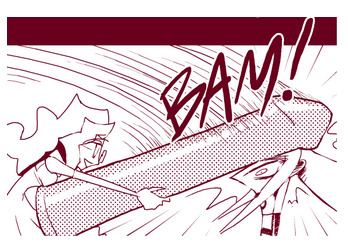
Getting to the point - page 3 of “Girly”
Girly is a NSFW comic. It’s not shy about it either. It hits the audience (and the main character) over the head with it literally in the first pages. It has sex positive characters, a sex positive world, some characters with… sex powers almost, and Dildos, a whole lot of dildos. Some even with smiley faces on them. It’s a pretty unavoidable part of the comic that makes up a large core of it’s humour and is baked into its wacky world. So if that’s not your thing, and it’s not really skippable in this case, you won’t like this comic.
But, if you’re alright with that part of it this might just be a hidden gem. Moving on.
Art
Artwork is always interesting in webcomics. They’re usually one man shows, have a weird niche / strong influences, and or usually go on massive journeys as the art improves. Girly is no different here.
Girly starts out rough. Some poses are wonky and its a bit scratchy. Technically speaking it has a few issues, which is fine. Its a free webcomic, from the 2000s that didn't copy and paste faces. (Won’t name names, you know who you are). You can’t be too harsh on a free comic, though.

However, what the art style does, even early on is set the style and feel of the comic. Anime inspired faces, bold outlines, and blocky silhouettes that were really popular with 90’s and 2000s cartoons. It has a newspaper, manga comedy strip vertical style, too. It fits the style of story well as a poppy wacky story. It's the perfect art style it could take.
Its rough in the beginning, but moves on from its scratchy days, to loose pen brush, to finally a polished free hand poppy style. It gets more technically advanced as it goes along, but it keeps its core style throughout. It’s fun, a little unhinged, and just pares perfectly.
The one issue I have with the art is it comes off as a bit cramped. It certainly matches the energy of the story, but it also feels like it doesn't let the characters have any breathing room in the frame. It comes off as squashed, and can make some character poses hard to read. That’s the only complaint I can find though. The issue even fixes itself later in the story, but just very very close to the end. It looks great there, but the majority of the comic is a little cramped. Still that’s just a small complaint.

Nitpicking here but some panels need a lil more room
This a humour comic foremost. It's the biggest part of what makes Girly specifically Girly.
Humour
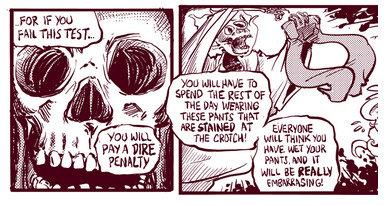
The humour is mostly wacky nonsense, playing off its insane characters, physics defying world, everything being dialed up to 11. It also works a lot like satire, poking at what influences it, and playing with cinematic expectations. The first page has Otra shooting someone into space on a rocket because they annoyed them, the first “adventure” the character’s go on is stealing everyone’s pants because they couldn’t find anything else to do. Then there’s the kidnapping adventures, knight trials, and slice of life shenanigans that happen. All of it as wacky as the last. I haven’t really found any other lesbian comics like it. Its not everyone’s tastes, but it is certainly unique.
If you’re into a willy wonka tunnel of over the top characters and plots, you’ll like Girly.
Characters
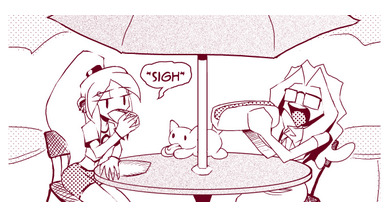
Girl is a LONG comic, it ran for 7 years. The art evolved, the story writing, jokes, and themes along with it. It was originally meant to run for only 50 strips... and it ended up with 764.
so, there’s a lot to unpack.

Firstly, the premise of the story is somewhat simple. It focuses on Otra. The kinda straight man to the entire universe. She starts out almost depressed, out of place, and bored of the wacky inhabitants of her world. Until one of those wacky residents smacks her over the head with a giant dildo and won’t leave her alone for the next 7 years of run time.
What follows is the sullen Otra being pulled around by the always cheery and zany nonsensical Winter as the sidekick for bizarre adventures. Otra’s depressive grounded view keeps the bizarreness funny, while Winter cuts through her negative attitude and causes a lot of the over the top plot. Leaving Otra to warm up to the world, and Winter to get less reckless as they balance eachother out. It’s a fun dynamic, and works as an emotional core of the story. No matter how weird the plot and rules of the world are, their relationship keeps the story somewhat focused and rewarding to see develop.
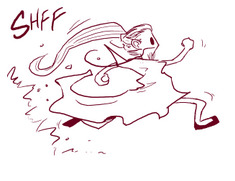
An example of bold wacky character designs from even early on
The comic isn’t just about them, though. As an ensemble comic there's plenty of side characters that go through arcs and beats as well. From el chubacabre, the man that woman find so irresistible that they sleep with him as soon as they see him; detective Clapjaw the street wise detective who is very bad at his job; Officer Hipbone and police guy from the cute P D; captain fist the ever popular bad at his job superhero who gets all the credit; the news reporter obsessed with captain fist; the woman with babies; Steak; the elephants that just… appear and eat buildings; among many many others. A lot of whom also have nicely written character arcs and depth in later chapters. Many of the character however are simple and remain simple, which isn’t a bad thing. For such a large cast, having a diverse range of strange characters with strong identities and looks even if a bit simple stops it from getting bogged down. It strikes a good balance. Plus there’s plenty enough of characters with more depth later on.
All the character’s are insane, and over the top in a way that really sets up the world they live in and how it works... as dysfunctional as it is. There’s something very Cartoon Network about all the characters, but with some wider influences. something about dumb characters, with very specific goals and quirks that work on their own physics to feed into the high energy insanity of the world. Its entertaining to read, and leads to a weirdly charming feel of the comic.
Story and plot
For the bit people actually want to know about. What is it about?

Just a little bit of influences...
For the style itself the comic comes off as a mix between early 2000s slice of life-y anime, 2000s cartoon Network, and a dose of 2000s webcomic sarcastic action/adventure flare. It definitely has one of the most pronounced styles that I’ve seen, and even if it's very much a webcomic of it’s time it also goes a bit beyond that into something that feels personal to the author and honest. Its a batshit comic. But, it wears its influences on it’s sleeve and really plays with tropes and ideas the author found engaging at the time. It somehow comes off as refreshing in just how willing it is to go weird or niche for no other reason but because it wants to. It's what I appreciate most about the comic. It’s honest.
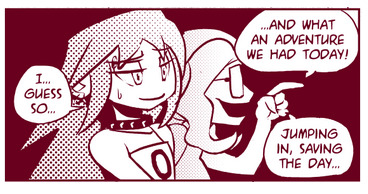
The overarching story of the comic is without a doubt about Otra and winter growing together as people. But with a comic that’s run for 7 years a little bit more happens in the journey, at least you hope it would. Girly runs on chapters, 15 in total (with 15 having sub chapters due to being the story’s climax), and each one of those chapters follows a different plot or adventure with Otra’s and Winter’s developing relationship gluing them together.
The plots themselves are wild and vary a bit in quality. But for a long comic that’s understandable and expected. They go from solving elephant problems, super villains, body swapping, fantasy parodies, and all sorts of strange things. Sometimes a few plots drag and a few character arcs feel a bit bland. It still manages to be entertaining all the way through though. The plots themselves work to get the character’s to play off each other and explore the strange world it takes place in. Exploring evil teddy bears, or an entire town devoted to cheap gags. No matter what, all the plots work in fleshing out the world and pushing character’s out of their comfort zone or forcing them to change. There are some that are less fun than others, but none of them manage to be boring or useless. Which for a long comic such as this, is quite an achievement.
Conclusion
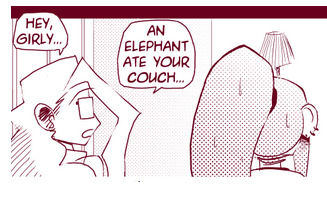
Girly is a hidden gem, Its an insane sex positive comic. A loose style and even looser physics. It’s bold and unabashedly itself. But, at its core it's about the love story of Winter, the wacky insane woman needing to slow down and open up, and Otra, a sullen woman who’s deemed herself only worthy of being on the outskirts of society. It’s two people growing together in a world that’s up to its ears in care bears, sentient dildos, earth shattering cloning, and jabs at 2000’s paste it comics. And somehow it all sticks together.
The characters resonated, at least with me, which may be the nostalgia talking. But by the end of the comic I can’t help but think back on how long it took them to get there. The bits that made me laugh (a lot of them), the stupid parts, and the character’s arcs, as over the top they could be at times. It may not everyone’s cup of tea. But it has a lot of heart at its core. (If you get past all the dildos).
For all it’s flaws and weird bits. I still find myself going back to Girly.
Maybe now, some more people will too.
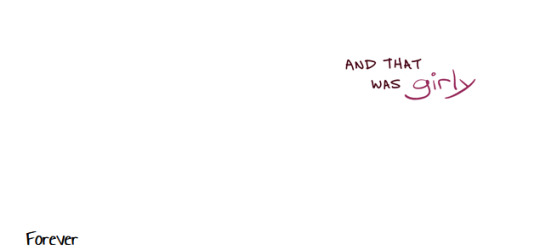
25 notes
·
View notes
Text
FEATURE: How I Got Into Sakuga

Kaiba, Directed by Masaaki Yuasa
If you’re an anime fan, you’re likely an animation fan in general. But how do you know when an animation is “good”? How do you learn to identify an animator by only what you see, or tell when their drawings are better than usual?
English-speaking anime fans have adopted sakuga as a general catch-all term for exceptional animation. While the word sakuga itself means “animation,” in this context, sakuga has come to mean something very specific: Not just animation that looks cool, but the deliberate handiwork of specific animators with specific artistic aspirations. For example, a single-animator project might have a lot of “sakuga shots” because it has a personal, highly-refined style. Meanwhile, a television series might have an entire team of varying specialists for a larger narrative. Some of this might be attributed to specific key animators, while some might be credited to an entire studio — transformation sequences, explosive missiles, robots — that’s all fair game to be called sakuga. But how do you really know if what you’re looking at really is this so-called “sakuga?”
Like most art, it’s almost entirely subjective. Here’s my story.
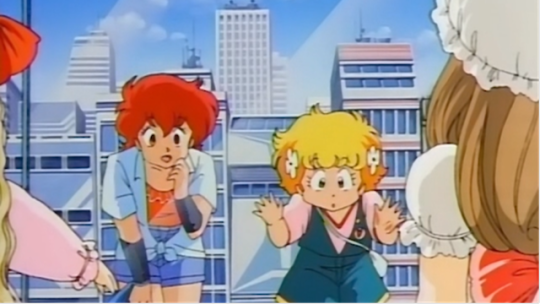
Project A-ko, a high-energy 1986 OVA series best remembered for its exceptional animation staff
(Image via Retrocrush)
All’s Fair in Love and War Games
When I was a kid, I got my hands on the English-dubbed Digimon: The Movie on VHS. This notorious release was a three-part recut of Mamoru Hosoda’s Digimon OVAs released from 1999 to 2000, heavily featuring his second film Digimon Adventure: Our War Game. Of course, I didn’t experience this package as a “Hosoda anime” at the time. Besides the inspired inclusion of Barenaked Ladies’ "One Week" to the soundtrack, I strongly associate these films with Hosoda’s signature interpretation of Katsuyoshi Nakatsuru’s original Digimon Adventure character designs. Compared to the Toei-produced television series, these renditions of the Digi-Destined are charmingly off-model and move with awkward intention, like actual kids up against terrifying monsters.
In a sense, that’s what most people mean by sakuga — animation that makes us lean in and notice traits about the world and characters that can’t be communicated otherwise. Sakuga, in particular, places special emphasis on an individual animator’s keyframes, or the drawings used as a basis for in-between frames during movement. That’s what I mean by the phrase “Hosoda anime.” If you watch Summer Wars or The Girl Who Leapt Through Time enough times, anyone will notice a stylistic palette of idiosyncrasies.
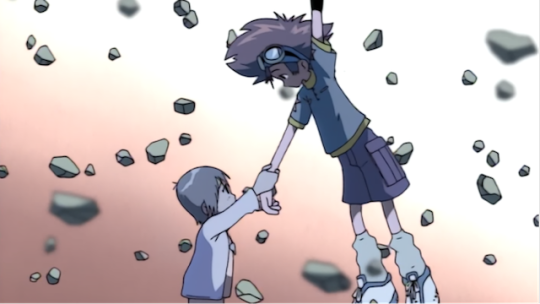
Digimon Adventure “Home Away From Home” directed by Mamoru Hosoda
(Image via Hulu)
An Emerging Style
When I got older and realized there was more anime than what was on cable, I kept returning to “flat” style animation with films like Tatsuo Satō’s 2001 Cat Soup and Shōji Kawamori’s 1996 Spring and Chaos. Around this time, contemporary artist Takashi Murakami also began developing his own “superflat” style (coined in his 2000 book Superflat and later in Little Boy: The Arts of Japan's Exploding Subculture) we’ll return to. Once I got a taste for the experimental, I never turned back.
But back to Hosoda. Less focused on the details of models and more fixated on a “flat” or fluid style of movement, the key animation in Hosoda’s films makes body language a priority. This is perhaps the best thing about good sakuga — its potential to express deep emotion even under production constraints. My favorite example comes from the first Digimon short film Hosoda directed, the simply titled Digimon Adventure from 1999.
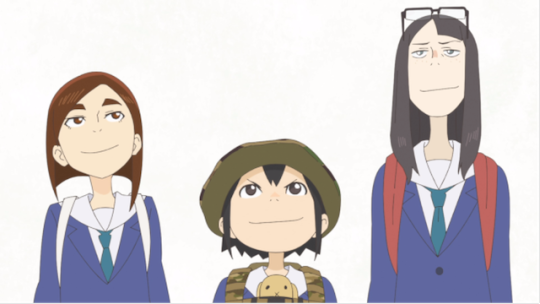
Keep Your Hands Off Eizouken!, Directed by Masaaki Yuasa
Originally conceived as a standalone for Bandai’s then-new Digital Monsters virtual pet toys, this version of Digimon is less loud, more atmospheric — and sincerely preoccupied with the question: “How would little kids actually handle a giant monster of their own?” The result is an unforgettable shot of Kairi, Tai’s little sister desperately blowing her whistle, stopping to catch her breath, then spitting and coughing in an attempt to calm down their newly evolved kaiju Greymon friend.
For the television series, Hosoda directed the episode “Home Away From,” depicting the two siblings clinging to each other as the other slowly drifts back to the Digital World. In both scenes, characters don’t constantly move, but only act when necessary via careful manipulation of the frames. This technique not only makes everything seem more “realistic,” but also acts as a visual cue for the anxiety Tai and Kairi feel. In other words, painstakingly controlled animation serves both form and function, especially when you’re selling an emotional climax of another kid-meets-monster plot.
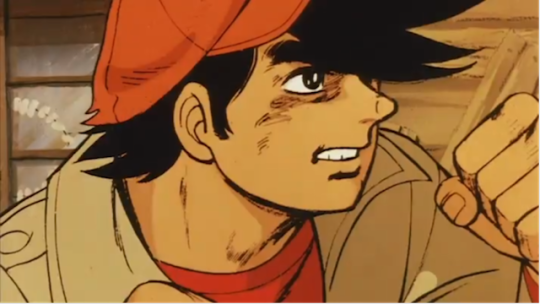
Tomorrow’s Joe, 1980 film adaptation of the 1970 TV anime series directed by Osamu Dezaki
(Image via Retrocrush)
A Little History Lesson
After Digimon, Hosoda and Nakatsuru collaborated on films like Summer Wars and the Takashi Murakami-inspired pop art short Superflat Monogram. Hosoda is no doubt inescapable to sakuga fans today thanks to the ubiquity of his feature films. Still, Hosoda obviously wasn’t the first sakuga animator. Animators like Yasuo Ōtsuka, known for his cinematic work in a pre-Ghibli era of anime film with Toei, documented the growth ‘60s and ‘70s of Japan’s animation industry in his 2013 book Sakuga Asemamire. When the demand for films lowered in favor of anime television during that era, animators took risks. Classics of the era like Tiger Mask and Tomorrow's Joe literally held no punches, and Osamu Tezuka’s own Mushi Productions dove headfirst into experimental adult films. Animators, and especially keyframe animators, had creative control. In this perfect storm, the advent of sakuga was inevitable.
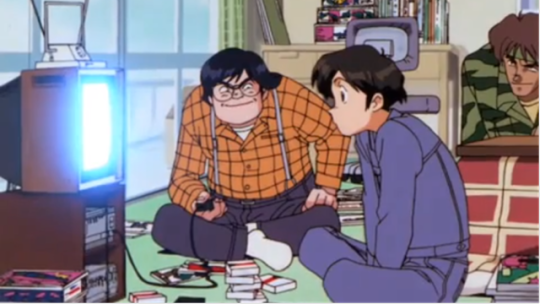
Everyman Ken Kubo is taught the ways of eighties anime in Otaku no Video
(Image via Retrocrush)
Why Bother With Sakuga?
In 2013, animation aficionado Sean Bires and company hosted an informational panel titled “Sakuga: The Animation of Anime” at Anime Central Chicago. Uploaded to YouTube that same year, this panel informed my younger self’s understanding of not just the “how” of sakuga, but the “why” it even needed to exist in anyone’s vocabulary. Accessible, meticulously researched, and full of visual references, Sean’s two-hour panel-lecture does the heavy lifting of contextualizing anime not just through a historical lens, but within the broader project of expanding cinematic techniques. This primer might sound heady, but considering the popularity of Masaaki Yuasa’s series like Keep Your Hands Off Eizouken!, and references to animator Ichirō Itano’s ���Itano circus” missiles in American cartoons like DuckTales, it’s hard to say sakuga isn't relevant. Nowadays, it's practically a trope to parody one of Dezaki's most iconic shots. Supplemented by a rich community of blogs and forums, it couldn’t be easier to learn about animators like Yasuo Ōtsuka or the early days of Toei if you want a bigger picture. Blogs like Ben Ettinger’s Anipages and the aptly named Sakuga Blog are a good place to start, not to mention dozens of dedicated galleries of anime production and art books published by studios themselves. Now couldn’t be a better time to vicariously live your art school dreams through anime masterworks.
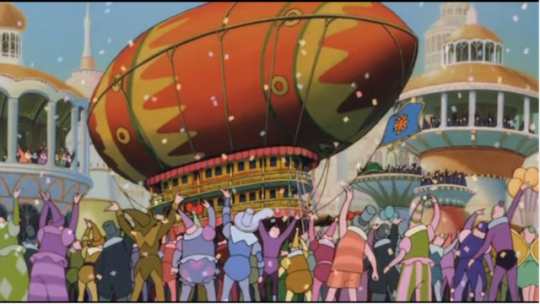
Little Nemo: Adventures in Slumberland, a 1989 film featuring animation by Yasuo Ōtsuka best known for his work on the Lupin III franchise
Sakuga Is For Everyone
Fans have always been obsessed with the technicalities of animation, even if they weren't artists. As early as 2007, uncut dubbed collector box sets for Naruto came with annotated booklets of episode storyboards. More recently, critically-acclaimed series like Shirobako further explicated this love for animation as a team effort — people love attaching other people to art. In contrast, psychological horror series like Satoshi Kon’s Paranoia Agent features an episode about an anime studio’s production going terribly wrong. Not to mention the endlessly self-referential Otaku no Video Gainax OVA and its depiction of zealous sakuga otaku. Anime fans adore watching anime be born over and over. It’s that simple.

Digimon Adventure “Home Away From Home” directed by Mamoru Hosoda
(Image via Hulu)
Today, I’d comfortably call some shots from Hosoda Digimon films great sakuga. But Koromon is still weird. Sorry. The love for sakuga isn’t a contest to one-up fans on production trivia or terminology. It’s about taking the time to appreciate the fact that anime is ultimately a collaborative artistic endeavor. From tracing back the lineage of animators like Yoshinori Kanada to Kill la Kill, to appreciating the visual sugar rush of Project A-Ko alongside slow-paced Ghibli films, “getting into sakuga” isn't a passive effort, nor a waste of time. Besides, wouldn't it be fun understanding how your favorite animator achieved your favorite scene? The phrase "labor of love" is cliché, but maybe that’s a good synonym for what role sakuga inevitably plays for artists and fans alike — work that brings you joy, no matter how you cut it. Who is your favorite animator? When did you get into sakuga? Let us know in the comments below!

Blake P. is a weekly columnist for Crunchyroll Features. His twitter is @_dispossessed. His bylines include Fanbyte, VRV, Unwinnable, and more. He actually doesn't hate Koromon.
Do you love writing? Do you love anime? If you have an idea for a features story, pitch it to Crunchyroll Features!
By: Blake Planty
10 notes
·
View notes
Text
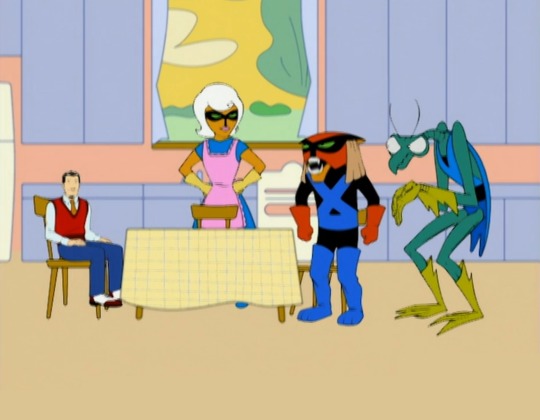
The Brak Show #1: “Leave It To Brak” (AKA “Mr. Bawk Ba Gawk”) December 21, 2000 - 5:15AM | S01E01 regular series version aired October 7, 2001 @ 11:00PM
I’m trying to break the habit of assuming only my friends are reading my various blogs, but I failed in one fundamental way: I didn’t really describe the premise of Sealab 2021, like, at all. Despite digging into it’s roots somewhat by watching it’s various pilots, I failed to include even a paragraph with the basic premise of the show. I’ll try not to make the same mistake with Brak. Instead I'll make a DIFFERENT mistake by writing way too long of a blog entry.
On December 21, 2000, after Sealab 2021, The Brak Show, then titled “Leave It To Brak” debuted. Who the fuck is Brak? Brak began life as a villain on the 1960s iteration of Space Ghost, a fairly garden-variety Saturday morning action kid’s show. He appeared in, I wanna say, a very small handful of episodes. I’ve seen the whole series, and I don’t think he was like, a regular or anything. Without looking it up I'll say he was on it twice. In the show he was a space pirate and had whiskers. He has a very memorable design. I’ve never been sure if we’re actually looking at Brak’s face or if he’s wearing a helmet. His fangs imply that we’re looking at his actual face (or at least his actual jaw), but that little curtain thing that hangs down from his, uh, ears? Is that a naturally occurring part of his head? It suggests that his wardrobe is actually his body, and vice-versa. He just looks absurd, making him perfect fodder for an absurdist revision.
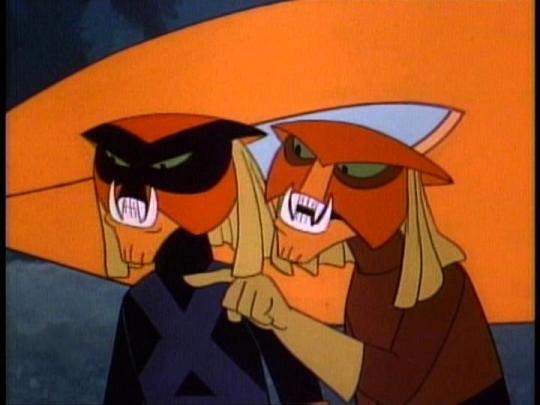
Brak as we know him today was first used (barring some kind of Cartoon Network commercial that I’m unaware of) in Space Ghost Coast to Coast, appearing with Sisto. Sisto is his twin brother who appeared in the 60s show. Why Brak was targeted for comedic revision and not Sisto eludes me. I’m guessing “HI MY NAME IS BRAK” just sounds funnier than “HI MY NAME IS SISTO”. Anyway, in the first Coast to Coast episode they are voiced by C. Martin Croker (RIP) doing a Beavis and Butt-head parody. Eventually Andy Merrill took over the role, basically turning Brak into a, uh, childish adult. Okay, he’s basically doing a retarded guy voice. Sorry, but it’s time to grow up.

Space Ghost Coast to Coast debuted in 1994 and remained a cult hit on the network until it was moved to Adult Swim and eventually canceled in 2004. The concept of Space Ghost Coast to Coast was Space Ghost, a super hero from the 60s, now hosts a modern 90s late night talk show, interviewing live-action celebrities on a monitor that hangs over the set. Random obscure Space Ghost villains would show up with skewed personalities from their original 60s counterpart. Brak was easily the runaway star of the touted rogues gallery. He would come in and cheerfully sing a song about beans or something else equally wacky. He rarely had a definable role on the show, he was just a figure that was around and would wander into the set.
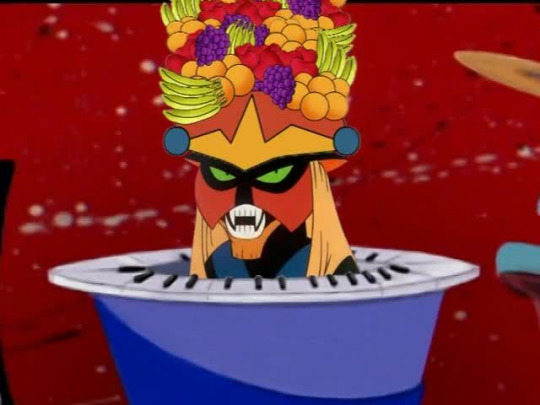
A second 90s Space Ghost spin-off was commissioned called Cartoon Planet. This was an actual kiddy show that aired during the day as opposed to Space Ghost Coast to Coast which was kid-friendly but meant for adults. This time Space Ghost, Zorak (Space Ghost’s bandleader on Coast to Coast), and Brak would host an hour of classic cartoons, with little absurd skits between segments set in a studio SORTA like the Space Ghost Coast to Coast set but different. LOTS of Brak’s fandom is based on these skits, which were a little more silly and lighthearted than the material on Space Ghost Coast to Coast. The skits were popular enough that they repackaged them into their own half-hour show, sans classic cartoons. This was an early point of confusion for me. Beloved Brak songs turned out to be from Cartoon Planet and NOT Space Ghost Coast to Coast, so I'd tune into Space Ghost wondering if they cut out all the Brak segments or what?
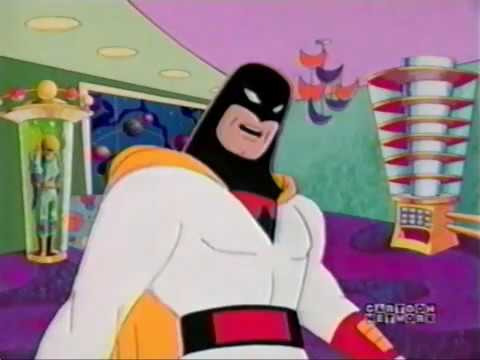
Cartoon Planet would answer viewer letters (conceivably real ones; they DID include various ways to contact “Ghost Planet” at the end of both Space Ghost Coast to Coast and, I’m guessing, Cartoon Planet, which I never did see in it’s original form). They actually answered the reason for Brak’s lack of intelligence (brain-damage caused by Space Ghost, using an actual clip from the 60s show). I bring this up not out of genuine concern for continuity or canon; these aren’t huge concerns for the writers of these shows. The real reason Brak is dumb is because Andy Merrill thought the voice was funny, probably. I bring it up because generally the premise of Space Ghost in the 90s is that even though he IS a super hero with super hero abilities, he’s also an actor who makes cartoons about being a super hero. So, it can be concluded Brak’s brain damage is from a stunt gone wrong and not carried over from the fiction of the show.
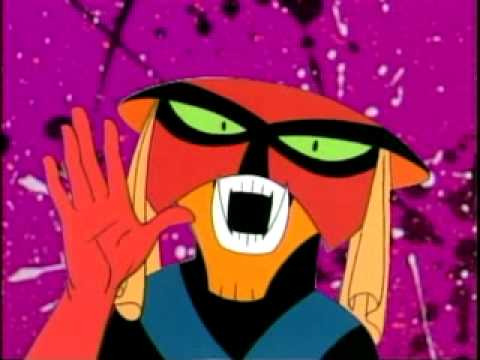
The premise of Space Ghost Coast to Coast is that Space Ghost has captured evil villains Zorak and Moltar and is forcing them to work on the show. But they also freely reference their personal lives outside of the show, breaking character. They are actors who are sticking to a premise only when it’s convenient. Yes, it’s fun for the kids to pretend that Space Ghost has enslaved his enemies to work on his talk show, but the reality is that when the camera turns off they all go home to their apartments or wives or whatever. This concept feeds directly into The Brak Show: we aren’t watching Brak’s real home life; Brak, cartoon character and actor, is playing himself in a sitcom. His mom isn’t his real mom. His Dad isn’t his real dad. Zorak isn’t his real best-friend. They are all actors. This isn’t played up in any significant way on the show itself except for a few moments and certain episodes, but THAT IS WHAT’S HAPPENING and you wouldn’t really understand that just by watching this episode and nothing else. You would have to have been paying attention all this time to Space Ghost Coast to Coast, Cartoon Planet, and also, yes, Brak Presents the Brak Show Starring Brak.
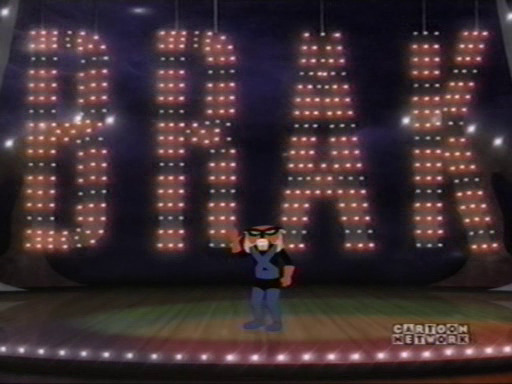
Okay, Brak Presents the Brak Show Starring Brak isn't REALLY required viewing for this series. But guess what? I watched it for the first time ever in preparation for this and now we all have to deal with Brak Presents the Brak Show Starring Brak. Brak Presents the Brak Show Starring Brak (sorry I keep repeating the full title which is Brak Presents the Brak Show Starring Brak) was a two-episode special presentation that aired on Cartoon Network while Space Ghost was on hiatus and before The Brak Show's stealth premiere. It (Brak Presents The Brak Show Starring Brak, that is) was a Sonny and Cher style variety show, featuring Brak and Zorak on stage together performing songs, intentionally corny sketches, and a LITTLE BIT, but NOT A LOT of backstage drama; which could be argued to have been part of the show itself. Variety shows doing sketches fictionalizing the backstage antics of the production is nothing new. There are also live-action integrated celebrities, and the show comes to a screeching halt whenever they show up. Maybe their performances are hampered by having to perform on a green screen, but these segments come off lame and pandering. Space Ghost Coast to Coast would make it's name featuring washed-up, kitschy, or counter-culture celebrities. Here we are treated to Monica, Freddie Prinze Jr. (whose segment in particular really drives me up a wall), some wrestler guy, and a lady who's name I don't remember. Okay, I admit I fast forwarded through the second of the two episodes a LOT. Sitting through one episode in real time was just too much to bear.

Brak Presents the Brak Show Starring Brak is written off by a lot of Brak fans as a substandard product, and they're not wrong. I myself never sought out the whole special until I started writing this blog. But there's one thing I'll give it, the visuals (minus the live-action celebrity parts) are actually pretty fun. There's a lot of weird character designs, and the same playful use of stock footage and kinetic editing from Cartoon Planet carries over into this. Skipping past the celebrity guests and watching the special on mute would be the preferred viewing method here. Honestly, I've never been that charmed by Brak's songs. I never cared much for Cartoon Planet.

Brak Presents the Brak Show Staring Brak eventually became The Brak Show, but with one more step: a scrapped audio-only pilot. This pilot appears as an audio commentary track on The Brak Show Volume 1 DVD set. I discovered it by accident. In preparation for this blog I popped the DVD in, saw there was commentary for Mr. Bawk Ba Gawk, and pressed play. Instead of Andy Merrill and Pete Smith dryly talking about their creative process, I was treated to what would have been the audio for a Brak Show pilot (there are stage directions being read in lieu of visuals), roughly the length of an 11 minute episode. This version plays up the backstage antics of Brak's variety show much more, kinda like Larry Sanders meets Brak Presents the Brak Show Starring Brak. Returning from the show is Brak and Zorak, along with Allen Wrench, a talking Allen wrench that appeared in Brak Presents the Brak Show Starring Brak. On Brak Presents the Brak Show Starring Brak, Allen had a crazy high-pitched voice. In this audio pilot he sounds closer to Meatwad from Aqua Teen Hunger Force. Also present in the audio pilot is Thundercleese, who curiously sounds like the regular series version of Thundercleese. In “Leave it to Brak”, Thundercleese sounds slightly different. Maybe they went back and rerecorded Thundercleese for the DVD?

That FINALY brings us to the actual episode. “Leave it to Brak” was the first episode of “The Brak Show” proper to air (though if I remember correctly from what was reported way back when, they wanted to call the actual show “Leave It To Brak” but couldn't for legal reasons). It feels more like a first episode than Goldfish does, which was the first episode I saw when Adult Swim officially began in 2001. “Leave it to Brak” introduces each character with fake studio audience applause. They even introduce Sisto, who simply walks in front of the camera, farts, and is not seen again. The premise of the show is this: Brak stars in a family sitcom. His mom belongs to the same species as Brak, but his dad is a tiny human voiced by George Lowe doing a Ricky Ricardo voice. According to this episode; Brak is roughly high-school aged, but it's all a pretense to get this cast of weirdos together under one roof. Again, Brak is a cartoon character playing himself here, so we're not meant to actually think these are his real parents; Brak is not half-human, necessarily. It's all just for the sake of this dumb show.
The plot of the episode is this: Zorak, Brak's best friend and worst influence, convinces Brak to help him kidnap the mascot of their rival high school, a chicken named Mr. Bawk Ba Gawk. Having done this, Brak grapples with the morality of his actions, tries to deceive his parents by dressing the chicken up like a little man, is caught, and is taught a lesson. There's a comedic final scene that reverses the lesson Brak supposedly learned, and then it ends. Somewhere in there we are introduced to Brak's giant robot neighbor who blows up Zorak for ripping up his lawn.
The Brak Show was possibly the most anticipated show when Adult Swim was announced. We all quietly ignored how much Brak Presents The Brak Show Starring Brak sucked; mostly because this was touted to be a show for adults. Afterall, Brak Presents the Brak Show Starring Brak's biggest shortcoming was the fact that it was the first Brak-centric product to pander directly to children. Brak was always seen as a uniquely weird creation that just so happened to appeal to kids, kinda like Pee Wee Herman or Joe Camel. Also the idea of parodying the sitcom genre seemed novel, despite the fact that it wasn't really a new idea. Now it just comes off like a shallow observation: boy, old sitcoms sure were corny, right?
I don't know exactly how to pinpoint what was so disappointing about this show. I can see there was a genuine effort to make it funny. Dad was a decently funny character. They weren't just trying to mock sitcoms, they were trying to build a genuinely strange world that resembled our own. Brak lived in the suburbs but there were aliens and robots everywhere. Sci-fi situations casually reared their ugly heads into the lives of these characters. I mean, look at the plot description of Brak stealing a high school mascot; it's an ACTUAL SITCOM PLOT. There's no real subversion to it other than the fact that Brak and Zorak from Space Ghost Coast to Coast are doing it. This could have been decent as a one-off special like Tim & Eric's Bag Boy staring Steve Brule. But they made more.
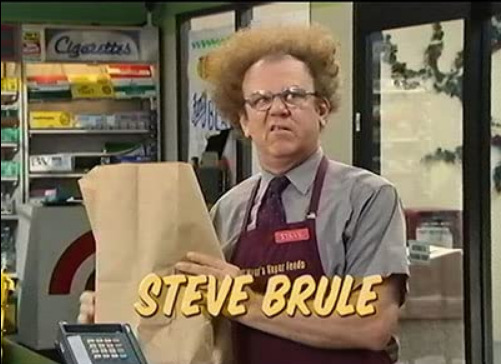
Oh wait, I figured out why The Brak Show sorta sucked. It's the fact that the show was a musical. Fuck, I hated that so much that I blocked it out of my head until this moment. Every episode had musical numbers in it sung by Brak and the family. Ugh. They were supposed to be funny nonsense but I never liked it. In fact if there were ever an edit of the show without the songs I would probably remember it much more fondly.
This version of the pilot had very simplistically drawn backgrounds. When the show went to series they redid the backgrounds with photo-realistic settings and props. It's a much more appealing look. This version of the pilot was briefly featured in an episode of Sealab, where Murphy was flipping through the channels on his monitor. He flips past this and Aqua Teen Hunger Force and maybe Space Ghost? This was back in the early days when every show seemed like it was connected to each other. I miss that. The “regular series” of The Brak Show used to give the show a different parodic on-screen title; “Mr. Bawk Ba Gawk”, which aired fifth on Adult Swim, had the opening title “B.J. And the Brak”. “Goldfish” used “Leave It To Brak”, which causes some episode guides to get confused over which episode is which. In fact, Adult Swim's website features the pilot version of this show and incorrectly uses the plot summary for “Goldfish”. I'm not linking to it because the listing says it expires today. But go look for it if you want.
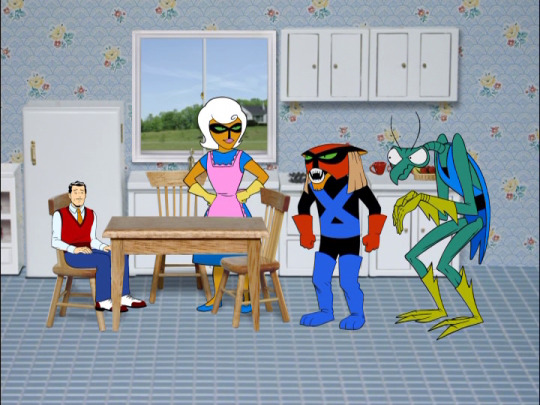
The other big difference between this version and the “regular series” version is there are a few missing bits here and there. For example, the pilot version starts with Dad asking Mom for another biscuit. She sighs and says “maybe later”, to which dad just shrugs off. There's also a cut song I call “Kiss you hot” that dad sings to mom. There's probably other differences here and there. Oh, Brak's clock is the beeflog illustration from Brak Presents the Brak Show Starring Brak. Isn't my life fuller for being able to make that connection? God, I'm so glad I watched Brak Presents the Brak Show Staring Brak last night instead of getting an extra hour of sleep.
So what's good in this? I REALLY like the scene where Bawk Ba Gawk is at the dinner table and everyone keeps stealing his little hat to wear. Mom scolds Dad for wearing the hat, to which he mutters “I'll do what I damn well please”. Mom then plucks the hat from his head. When we cut to the wide shot, she's wearing it. Funny! SOLIDLY VERY FUNNY. But the series generally suffers from them trying to cram in weird pointless bits of absurd comedy. Only sometimes does it work. Not sure why. But that's how it goes, I guess.
#the brak show#brak#space ghost coast to coast#space ghost#brak presents the brak show starring brak#adult swim#adultswim2021
14 notes
·
View notes
Text
Homestuck is My Favorite Sprite Comic
Yes, you read that right.
Homestuck is my favorite sprite comic.
Those of you who remember the earlier days of the internet are probably looking at this post in disbelief right about now. Others of you might be scratching your heads, not knowing what I’m talking about.
But here’s my pitch: Homestuck is the culmination of an entire genre of internet art, and the tools that make it so powerful are the very tools that made that genre once so reviled.
Homestuck is the greatest and most successful sprite comic of all time.
And honestly, I’ve wanted to talk about that for ages, so let’s do it.
WHAT SPRITE COMICS WERE
Many of my readers are probably too young to remember the era of sprite comics. So: what were sprite comics?
Sprite comics were a genre of webcomics made entirely by taking pixel art from video games – especially character art, called “sprites,” but also backgrounds and other images—and placing them into panels to tell a story. They were near-ubiquitous on the internet in the early 2000s, emerging right as webcomics in general were seeking to establish themselves as an art form.
They were not, shall we say, known for their quality. The low bar to access meant that art skill was not an obstacle to starting one. The folks behind the huge swell of them tended to be young people, kids and early teenagers recreating the plots of their favorite video games with new OCs—not the most advanced writers or artists. They were the early 2000s’ quintessential example of ephemeral, childish art. Unfortunately, they look even worse today—blown-up pixels don’t hold up well when displayed on higher-resolution monitors.
Today, they’re mostly forgotten, remembered only as a weird, strange moment in the youth of the internet. Someone who evoked them today, such as a blogger who compared them to one of the most successful webcomics of all time, would be inviting good-natured teasing at the very least.
It would be unfair to dismiss them entirely, though. In this low-stakes environment, comics where the author could bring more skill—engaging writing, legitimately funny jokes, or especially, a real ability to work with pixel art—really stood out. (Unsurprisingly, these authors tended to skew a bit older.)
The obvious one to mention is Bob and George. Bob and George wasn’t the first sprite comic, but it was the most influential. Conceived initially as Mega Man-themed filler for a hand-drawn comic about superheroes, it quickly became a merging of the two concepts, with the original characters made into Mega Man-style sprites, full of running gags, humorous retellings of the Mega Man games, elaborate storylines about time travel, and robots eating ice cream. It was generally agreed, even among sprite comic haters, that Bob and George was a pretty good comic. Worth mentioning also are 8-Bit Theater, which turned the plot of the first Final Fantasy into a spectacular and hilarious farce, and of course Kid Radd, my second favorite sprite comic. (More on that later.)
But even if you weren’t looking for greatness—there was something just damn fun about them. The passion of sprite comic authors was clear, even if their ideas didn’t always cohere. To this day, I think the sprite comic scene has the same appeal pulp art does—it’s crude and rough, full of garbage to sift through, but every so often, something deeply sincere and bizarre shines through, and the culture of its authors is a fascinating object of study in itself.
Okay, full disclosure: I was one of the people who made a sprite comic. I’ve written about my experiences with that in more depth elsewhere, but yeah, I was on the inside of this scene, rather than a disinterested observer, and from the inside, maybe it’s a lot easier to see the appeal.
Still, let me make this claim: even with all their flaws, sprite comics were doing some incredibly interesting things, and Homestuck is heir to their legacy.
TAKE ME DOWN TO RECOLOR CITY
One of the problems people always had with sprite comics was the sprites themselves. They’re the most repetitive thing in the world. You just keep copying and pasting the same images over and over again, maybe with a few tweaks. That’s not really being an artist, is it? It’s so lazy. Re-drawing things from different angles keeps things dynamic, develops your skill, and makes your work better in general. Right?
I’m mostly in agreement. Certainly I think it’s fair to rag on the Control-Alt-Delete guy, along with other early bad webcomics, for copy-pasting their characters while dropping in new expressions and mass-producing tepid strips. And to be fair, digging through bad sprite comics often felt like an exercise in seeing the same slightly-edited recolors of Mega Man characters over and over again. You got really tired of that same body with its blobby feet and hands.
(It should be noted, though, that there were folks in the sprite comic scene who could pixel art the quills off a porcupine. I salute you, brave pixel art masters of 2006. I hope you all got into your chosen art school.)
All this said, I think the repetitive and simplistic nature of sprite comics was often their biggest strength.
THE POWER OF ABSTRACTION
In his classic work Understanding Comics, Scott McCloud makes an observation about cartooning that has stayed with me to this day.
McCloud notes that simple, abstract drawings, like faces that are only few lines and dots on a page, resonate with us more strongly than more detailed drawings. This is because our minds fill in what’s missing on the page. We ascribe human depth to simple gestures and expressions based on our own emotions and experiences – and this makes us feel closer to these characters as readers. Secretly, simple cartoons can be one of the most powerful forms of storytelling. If you want your readers to fall in love with your characters, draw them simply, and let them fill them in.
Video game sprites work very well in this regard. They have that same simplicity that cartoons do. In fact, I’d be willing to bet a huge part of the success of SNES-era RPGs was simple, almost childlike character sprites drawing people in. I think sprites did the same for sprite comics.
Here’s the weird thing: Bob and George worked. Despite four different characters being variations on the same friggin’ Mega Man sprite in different colors, they immediately began to seem like different people with distinct personalities. For me, George’s befuddled, helpless dismay immediately comes to mind whenever I picture his face, while with Mega Man himself it’s usually a wide-eyed, childlike glee. I would never confuse them. This, despite the fact that the only actual difference between their faces is that George is blonde. It’s pretty clear what happened. The personalities the author established for them through dialogue and storytelling shone through, and my brain did the rest.
Sprites, in short, were a canvas upon which the mind could project any story the author wanted to tell. Even the most minute differences in pixel art came to stand, in the best sprite comics, for wide divergences in personality and ideals, once the reader spent enough time with them to adapt to their style of representation.
Wait a minute, haven’t we seen this somewhere before? Character designs that focus on variations on a theme, with subtle differences that nonetheless render them instantly recognizable?
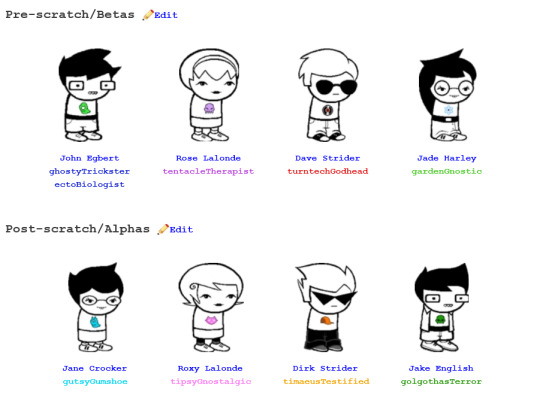
Oh, right.
Look at what greets us on the very first page of Homestuck. An absurdly simple cartoon boy, abstracted to a ridiculous degree—he doesn’t even have arms!—followed a whole bunch of characters that follow suit. Though many other representations of the characters emerge, these little figures never quite go away, do they? Why is that?
Simple: they’re very easy to manipulate. They’re modular—you can give John arms or not, depending on whether it’s useful. You can put him in a whole variety of poses and save them to a template. You can change out his facial expressions with copy and paste. You can give him a new haircut and call him Jake. It’s all very quick and easy.
Sprite comics proliferated because they were very easy to mass-produce. Andrew Hussie’s original conception of Homestuck was very similar: something he could put out very quickly and easily, where even the most elaborate ideas could rely on existing assets to be sped smoothly along. We all know the result: an incredible production machine, churning out unfathomable amounts of content from 2009-2012. I’d say it was a good call.
But it goes way deeper than that. The modular nature of sprites always suggested a kind of modularity to the sprite comic premise. George and Mega Man were different people, true, but also two variations on a theme. Was there something underlying them that they had in common? Perhaps their similarity says something like: We exist in a world which has a certain set of rules? One of my favorite conceits from Bob and George was that when characters visited the past, they were represented by NES-era Mega Man sprites, while in the present, they were SNES sprites, and in the future, the author used elaborate splicing to render them as 32-bit Mega Man 8 sprites or similar.
Suppose there was a skilled cartoonist thinking about his next big project, who wanted to tell a story centered around this kind of modularity, a narrative that was built out of iterative, swappable pieces by its very design. He might very well create a sprite comic named Homestuck.
Homestuck is a story about a game that creates a hyperflexible mythology for its players, where the villains, challenges, and setting change depending upon what players bring to the experience, yet which all share underlying goals and assumptions. What more perfect opportunity to create a modular story as well? Different groups of kids and trolls have motifs that get swapped around to produce new characters, whether that’s through ectobiology, the Scratch, or the eerie parallels between the kids and trolls’ sessions. And yet each character can be analyzed as an individual.
This is an incredible way to build a huge emotional investment from your readers. Not only does this kind of characterization invite analysis, the abstractions draw readers in to generate their own headcanons and interpretations. A deep commitment to pluralism is at the heart of Hussie’s character design. Then, too, it encourages readers to build their own new designs from these models. Kidswaps, bloodswaps, fantrolls—these have long been the heart of Homestuck’s fandom. And what are bloodswaps if not sprite recolors for a new generation? With the added bonus that now a change in color carries narrative weight, evoking new moods and identities for these characters in ways that early sprite comics could only dream of.
In Hussie’s hands, even the dreaded copy-and-paste takes on heroic depth of meaning. Even when Hussie moves away from sprites to his own loose art style, he continues to remix what we’ve previously see. Indeed, Hussie talks about how he would go out of his way to edit his own art into new images even when it would take more time than drawing something new. Why? Because he wanted to evoke that very feeling of having seen this before—the visual callback to go along with the many conceptual and verbal callbacks that echo throughout Homestuck. This is at the heart of what Doc Scratch (speaking for Hussie) called “circumstantial simultaneity:” we are invited to compare two moments or two characters, to see what they have in common, or how they contrast. Everything in Paradox Space is deeply linked with everything else. And Hussie establishes this in our minds using nothing less than the tool sprite comics were so deeply reviled for: the “lazy” repetition of an image.
(It’s fitting that some of the most jaw-droppingly gorgeous images in Homestuck—dream bubble scenery and the like—are the result of Hussie taking things he’s made before and combining them into fantastic dreamscapes.)
But it all started with the hyperflexible, adaptable character images Hussie created at the very beginning of Homestuck.
And if you need more proof that Homestuck is a sprite comic, I think we need look no further than what Hussie, and the rest of the Homestuck community call these images.
We call them sprites.
THE FIRST GENRE-BENDERS
Was Andrew Hussie influenced by sprite comics in the development of Homestuck? It’s hard to say, but as a webcomic artist in the first decade of the 2000s, he was surely aware of them. It’s likely that he quickly realized that his quick, adaptable images served the same purposes as a sprite in a video game or a sprite comic, and chose to call them that.
One purpose I haven’t mentioned up until now: sprites lend themselves very well to animations. In fact, in their original context of video games, that’s exactly what they’re for: frames of art that can be used to show a character running, jumping, posing, moving across a screen. It’s not surprising, then, that sprite comic makers quickly saw the utility in that.
Homestuck was, in fact, not the first webcomic to make Flash animations part of its story. There were experiments with various gifs and such in other comics, but I think sprite comics were among the most successful at becoming the multi-media creations that would come to be known as hypercomics..
Take a look at this animation from Bob and George. It represents a climactic final confrontation against a long-standing villain, using special effects to make everything dramatic, but ultimately, like many a Homestuck animation, leads to kind of a pyscheout. The drama and the humor of the moment are clear, though. This relies in large part on the music—which is taken directly from the game Chrono Trigger. This makes total sense. Interestingly, it also contains voice acting, which is something Homestuck never tried—probably because it would run contrary to its ideals of pluralism. What I find fascinating is that in sprite comics, animations like these served a very similar purpose to Homestuck’s big flashes: elevating a big moment into something larger-than-life. Another good example is this sequence from Crash and Bass. Seriously, it seems like every sprite comic maker wanted to try their hand at Flash animation.
(By the way, it’s a lot harder than it looks!! I envy Hussie his vectorized sprites. Pixel art is a PAIN to work with in the already buggy program that is Flash.)
The result: because of the sprites themselves, sprite comics were among the first works to play around with the border between comics and other media in the way that would come to be thought of as quintessentially Homestuck.
What it also meant was that another genre emerged in parallel with sprite comics: the sprite animation. Frequently these would retell the story of a particular game, offer a spectacular animated battle sequence, parody the source material, or all three. Great examples include this animation for Mega Man Zero, and this frankly preposterous crossover battle sequence. Chris Niosi’s TOME also found its earliest roots as an animation series of this kind. You also found plenty of sprite-based flash games, in which players could manipulate game characters in a way that was totally outside the context of the original works.
The website the vast majority of these games and animations were hosted on?
Newgrounds, best known to Homestuck fans as the website Hussie crashed in 2011 while trying to upload Cascade.
What’s less talked about is that Hussie was friends, or at least on conversational terms with, the owner of the site, hence the idea to host his huge animation there in the first place, and other flashes, like the first Alterniabound, were initially hosted there as well.
It’s hard to believe that Hussie wasn’t at least a little familiar with the Newgrounds scene. I suspect that he largely conceived of Homestuck as part of the world of “Flash animation—” which in 2009 meant the wide variety of things that were hosted on Newgrounds, including sprite animations.
The freedom and fluidity sprite comics had to change into games and animations and back into comics again was one of their most fascinating traits. Homestuck’s commitment to media-bending needs, at this point, no introduction. But what’s less known is that sprite comics were exploring that territory first—that Homestuck, in short, is the kind of thing they wanted to grow up to be.
PUT ME IN THE GAME
I would be a fool not to mention another big thing Homestuck and sprite comics have in common: a character who is literally the author in cartoon form, running around doing goofy things and messing with the story. This was an incredibly common cliché in sprite comics, no doubt because of Bob and George, who did it early on and never looked back. You might have noticed that the animation I linked above concerns a showdown between Bob and George’s author, David Anez—depicted, delightfully, as another Mega Man recolor—and a mysterious alternate author named Helmut—who is like Mega Man plus Sepiroth I think? It’s all very strange. I could ramble for hours about the relationship between Hussie and the alt-author villains of Homestuck and what it all means, but I’m not sure I can nail anything down with certainty for these two. Maybe Bob and George was never quite that metaphysical.
But yes, bringing the author into the story in some form was already a cliché by the time Homestuck started up. Indeed, I think that’s why Hussie’s character refers to it as “a bad idea” to break the fourth wall—he’s recognizing that people will have seen this before, and are already tired of this sort of shit. And then he goes and does it anyway and makes it somehow brilliant, because he’s Andrew Hussie.
Homestuck breathes life into the cliché by taking it in a metaphysical/metafictional direction. I don’t think that was really the motivation for most sprite comic authors, though. Let’s see if we can dig a little deeper.
I think the cliché kept happening because sprite comic authors were writing about a subject that very closely concerned themselves: video games. I’m only kind of joking. The thing about video games is that even though they’re made for everyone, playing through one yourself feels like an intensely personal experience. You develop an emotional relationship to a world, to its characters, that feels distinctly your own. Now, suddenly, thanks to the magic of sprites, you have an opportunity to tell stories about that world for others to read. Of course you’re going to want to put yourself in the story in some form.
When it wasn’t author characters in sprite comics, it was OCs. You know Dr. Wily? Well here’s my own original villain, Dr. Vindictus. You know Mega Man? Here’s my new character, Super Cool Man. He hangs out with Mega Man and they beat the bad guys together. Stuff like that. Most sprite comics retold the story of a game, or multiple games in a big crossover format, with original elements added in. There was quite a lot of “Link and Sonic and Mega Man are all friends with my OC and they hang out at his house.”
What’s interesting, though, is that because these sprite comics were very aware that they were about video games, this was where they sometimes got very meta. It started with humorous observation—hey, isn’t it funny that Link goes around breaking into people’s houses and smashing their pots? But sometimes, it grew into more serious commentary. Is Mega Man trapped in a never-ending cycle, doomed to fight the same fight against the same mad scientist until the end of time? Is it worth it, being a video game hero?
Enter Homestuck. What I’ve been dancing around this whole time is:
Homestuck is a sprite comic…because Homestuck is a video game.
Or more specifically, Homestuck’s a comic about a video game called SBURB, where the lines between the game and the comic about the game blur as characters wrestle with the narratives around them, both those encoded into the game and those encoded into our expectations.
Homestuck presents the fantasy of many a sprite comic maker: I get to go on heroic quests, I get to change the world and become a god. I get to be part of the video game. And then it asks the same question certain sprite comics were beginning to ask:
Is it worth it, to be that hero?
I want to tell you about my second favorite sprite comic, a comic called Kid Radd.
Kid Radd distinguished itself from other sprite comics of the time by being a completely original production. Its sprites looked like they could be from a variety of NES and SNES-era video games, but they were all done from scratch, and the games they purported to represent were all fictional. Kid Radd used animations with original music, and sometimes interactive, clickable games, to tell its story. It also used all sorts of neat programming tricks to make it load faster on the internet of the early 2000s, which was great—unfortunately, these same techniques made it break as web technology evolved, something Homestuck fans in 2019 can definitely relate to. The good news is, fans have maintained a dedicated and reformatted archive where the comics can still be seen and downloaded.
Kid Radd’s premise is that video game characters themselves are conscious and alive—more specifically, their sprites. Sprites developed consciousness as human beings projected personality and identity onto them, remaining aware of their status as video game constructs while also seeking to be something more. The story follows the titular Kid Radd, at first in the context of his own game, commenting on the choices the player controlling him. He must endure every death, every strange decision along the way to save his girlfriend Sheena. Then the story expands into a larger context as Radd, Sheena, and many other video game characters are released onto the internet as data. They try to find their own identities and build a society for themselves, but struggle with the tendency toward violence that games have programmed into them. The story culminates in an honestly moving moment where Radd confronts the all-powerful creators of their reality—human beings.
It’s a very good comic.
The first sprite comic authors wanted to fuse real life with video games. Later sprite comic authors decided to ask: what would that really mean? Would it be painful? Would you suffer? Would you find a way to make your life meaningful all the same? Despite the limitations of sprite comics, these ideas had incredible potential, and in works like Kid Radd, they flourished.
Homestuck is heir to that legacy.
It takes the questions Kid Radd was asking, and asks them in new ways. It tries to understand, on an even deeper level, how the rules of video games shape our own minds and give us ways to understand ourselves.
At its heart, Homestuck is a sprite comic, and it might just be the greatest of them all.
EPILOGUE
I’ve seen a lot of good discussion recently on how Homestuck preserves a certain era of the internet like a time capsule: its culture, its technology, its assumptions, its memes.
I think sprite comics, too, are part of the culture that created Homestuck. Do I think Hussie spent the early 2000s recoloring Mega Man sprites? No, probably not. But what I do know is that sprite comics were part of his world. The first webcomic cartoonists came of age alongside an odd companion, the weird, overly sincere, dorky little sibling that was sprite comics. Like them or hate them, you couldn’t escape them. They were there.
And maybe a certain cartoonist saw a kind of potential in them, in the same way he summoned Sweet Bro and Hella Jeff from the depths of bad gamer culture.
Or maybe he just knew, as some sprite comic authors did, that the time was right for their kind of story.
On a personal level—Homestuck came along right when I needed it.
Around 2009, the bubble that was sprite comics finally burst. People were getting tired of them, or growing out of them, and blown-up sprites no longer looked so good on modern monitors.
I was more than a little heartbroken. I’d enjoyed Bob and George, read my fill of Mega Man generica, and fallen utterly in love with Kid Radd. I’d been working on my own sprite comic for a long time out of a sense that there was huge potential in them that we were only scratching the surface of. I’d dreamed of maybe someday doing something as amazing as the best of them did. But I was watching that world disappear. I had to admit to myself that my work wasn’t going to continue to find an audience. That I could live with. But it was painful to think that the potential I sensed, the feats of storytelling I wanted to see in the world, would never be realized.
And then, in the fall of 2010, a friend linked me to a comic that broke all the rules, that mixed animation, games, music, images and chatlogs. A comic that crafted its own sprites, just as Kid Radd did, and remixed its images into an ever-expanding web of associations and meanings. A comic that took on the idea of living inside a video game with relish and turned it into a gorgeous meditation on escaping the ideas and systems that control us.
That this comic would exist, let alone that it would succeed. That it would become one of the most popular creations of all time, that it would surpass other webcomics and break out into anime conventions and the real world, that it would become such a cultural juggernaut, to the point where it’s impossible to imagine an internet without Homestuck—
I can’t even put into words how happy that makes me. It’s the reason I’m still writing essays about Homestuck nearly eight years after I found it.
And it’s why Homestuck will always be my favorite sprite comic.
-Ari
[Notes: The image of the kids came from the ever-useful MSPA Wiki—please support and aid in their efforts to provide a good source of info about Homestuck! They need more support these days than ever.
For more on Homestuck’s place as a continuation of the zeitgeist of early 2000s experimental webcomics, this article by Sam Keeper at Storming the Ivory Tower is excellent and insightful.
Thanks for reading, y’all.]
#homestuck analysis#homestuck#homestuck's influences#hypercomics#understanding homestuck#sprite comics#internet culture
1K notes
·
View notes
Text
2010s Art: Music, Games, and TV
So I love all forms of art. It may not seem like it since I tend to stick mainly to movies, with the odd cartoon or video game thrown in, but that’s really because movies are more my thing due to not being massive time investments. Like, don’t get me wrong, I gamed, I watched TV, I listened to music, but it was a lot more casual than my deep dive into becoming a major cinephile.
With games and TV, it was mostly issues of money and time respectively. I have a few consoles, mostly Nintendo and Sony ones, and my wife helped me experience Xbox games, but I just don’t have the money needed to experience every good game that comes out. With TV, the time investment is the biggest roadblock, especially when all the best shows have hour-long episodes these days. With movies, I just have to spend 90 minutes to two hours on average; for TV, it’s countless hours I could be watching movies. As for music… well, I listened to a lot, I just don’t feel totally qualified to properly rank and list songs and albums.
So instead of the big decade-spanning list for movies that I’m doing, I’m going to go over some things I enjoyed from the past decade and maybe a few things I didn’t in music, TV, and video games. Here’s a little guide so you know what stuff is something I consider one of my absolute favorites in any given medium - if it’s from this decade, it will be in bold, and if it’s from a previous decade but I experienced it this decade, it will be underlined.
Television
I figured I’d get this out of the way first since it’s the medium I have the least experience with. Let me put it this way: I have seen only one season of Game of Thrones, the first one (and by all accounts I dodged a bullet by dropping that show). I also had the misfortune of jumping in to The Walking Dead right as it was gearing up for its abysmal second season, which turned me off that and led to me only watching an episode here or there.
I had better luck watching live action shows on streaming. I managed to get through almost all of Pretty Little Liars on Netflix, which was a chore in and of itself; it’s a good show, but boy could it ever get arbitrary and frustrating. Speaking of Netflix, I think it goes without saying that Stranger Things is their best effort; from the likable cast of kids to the awesome soundtrack, even though it never really surpasses season one the show always has something cool going on in one of its plots. My other favorite from Netflix would probably be their take on A Series if Unfortunate Events, which is how you do adaptation expansion right; everything they add feels like it’s in service of fleshing out Lemony Snicket’s dismal world, as well as giving Patrick Warburton an incredible dramatic role as the Lemony narrator himself.

Amazon managed to score two hits in my book. The first is the unbelievably fun and charming Good Omens, a miniseries that somehow got me to love David Tennant and Michael Sheen more than I already did. The second was the gory joyride that is The Boys which while not the smartest or most original superhero satire is definitely the most fun.
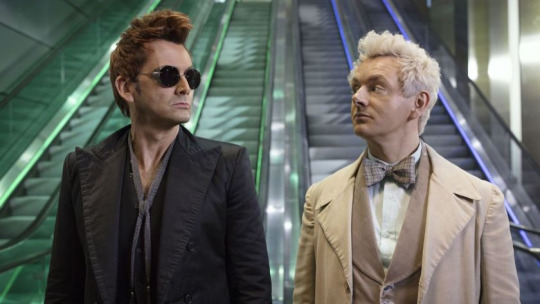
While I didn’t watch the whole show and would not consider it one of my favorites, I do want to give props to Hannibal for introducing me to Mads Mikkelsen. As far as I’m concerned, he’s the only person aside from Hopkins worthy of playing everyone’s favorite cannibal. Another show I DO consider a favorite despite slacking on keeping up with it is Ash vs. Evil Dead; I only needed to see a single season of Bruce back with the boomstick to know this show was a masterpiece.
On the animated side I have much more to talk about. Not since the 90s have we been spoiled with so many genuinely great and varied cartoons. We got Adventure Time, Regular Show, Steven Universe… really, Cartoon Network raised the bar this decade and made up for an awful 2000s. They even finally gave Samurai Jack a conclusion, which despite the mixed results, was still a real exciting phenomenon to experience.

Of course, my favorite CN show came from Adult Swim. I am of course referring to Rick & Morty, a fun sci-fi adventure comedy that attracted the most obnoxious fanbase possible in record time. While certainly not a show you need a high IQ to understand and having an atrocious third season, it still manages to be funny and thought provoking in equal amounts. Seriously though. Fuck season 3.
My Little Pony: Friendship is Magic is another great show that I sadly fell off the wagon of around the fifth or sixth season. It never got bad of course but it never really engaged me like the older episodes, though what I’ve heard of the last season makes me wish I’d kept up with it. It was a great show with a lot of heart and character, and I’m not sure we’ll ever see a show like it again.

Netflix did not slack in the animation department; I didn’t catch their most famous show (it’s the one about a certain Horseman) but I did catch their fantastic take on Castlevania, which as a huge fan of the series was a real treat. Where the fuck is Grant though?
My two favorite shows of the decade, however, are what I see as the pinnacle of East and West: Jojo’s Bizarre Adventure and Gravity Falls.
JJBA is a series I had vague passing knowledge of, only knowing its existence due to seeing Stone Ocean referenced on the Wikipedia page for air rods when I was younger and, of course, the memes that spawned from Heritage for the Future, which were inescapable back in the day. As soon as I got into the series, it became one of my biggest inspirations, teaching me you can be deep, complex, and filled with great character interactions while also being so batshit insane that every new and absurd power is incredibly easy to buy (looking forward to the rainbows that turn people into snails, animators). They managed to get through the first four parts and start up the fifth over the decade; so far my favorite part is four, mainly due to the magnificent bastard that is Yoshikage Kira (played time perfection by D.C. Douglas) and in spite of serial creep Vic Mangina playing the otherwise lovable asshole Rohan Kishibe.
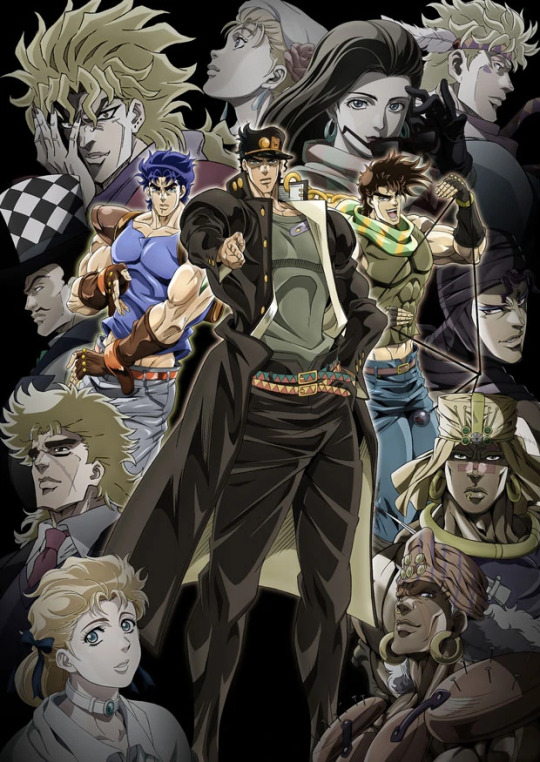
Gravity Falls on the other hand is just a fun and engaging mystery show that manages to excel at being episodic and story-driven all at once. There’s only one or two “bad” episodes across two seasons, and it lasted just as long as it needed to, wrapping things up with a satisfactory ending that still gave fans a few mysteries to chew on. It also gave us Grunkle Stan, perhaps the greatest character in all of animation, the pinnacle of “jerk with a heart of gold” characters who is hilarious, badass, and complex all at once. This is my favorite western animated show…
...but then the last year of the decade threw a curveball and, if I’m being honest, is on par with Gravity Falls: Green Eggs and Ham. Netflix really wanted us to know 2D animation is back in 2019; between this show and Klaus, the future is looking bright for the medium. It’s a fun, funny roadtrip comedy that knows when to be emotional and when to be funny, and it’s all filtered through the wubbulous world of Dr. Seuss. It’s just a wonderfully delightful show.

And on the subject of JoJo, I had a kind of love-hate relationship with anime this decade. The attitudes of anime fans turned me off from anime for a long while. Sure, I checked out stuff like Attack on Titan and Sword Art Online, but neither series really clicked with me. The main anime I loved this decade were ones that started in the 2000s and ended in the 2010s, like Dragon Ball Z Kai and Fullmetal Alchemist: Brotherhood. I suppose I did enjoy My Hero Academia, which is a really fun show with an awesome and varied cast and great voice acting. Love Froppy, best girl for sure.
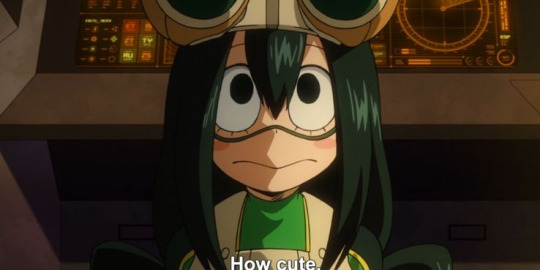
One of the most unfortunate things about this decade was how many great shows got screwed over by their networks. Sym-Bionic Titan, Thundercats, and The Legend of Korra were all great shows in their own right but were treated like shit by their respective networks. It really makes me upset that stuff like that not only happened, but continues to happen to this day.
But let’s not end on a bad note; let’s talk about the astounding returns old shows got. Invader Zim got a movie as did Hey Arnold, with the latter in particular finally wrapping up the dangling plot threads, but those are actual TV movies so they don’t really fit here; what DOES fit is Static Cling, the triumphant return of Rocko’s Modern Life. A forty minute special, it follows Rocko and his friends as they navigate the modern age, trying to bring back Rocko’s favorite cartoon. Rachel Bighead’s arc in this in particular is pretty groundbreaking and awesome.
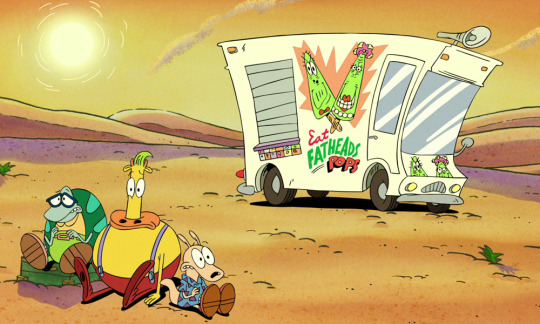
Also awesome was the first few episodes of Samurai Jack’s return, though it did end up petering out halfway through the season and ended on an anticlimactic note. Still, Tom Kenny’s Scaramouche, the sheer amount of continuity, and the awesome final curbstomp battle against Aku are worth giving this a watch. And if nothing else, stuff like this gives me hope for future revivals. What will we see next? Gargoyles comeback? Batman Beyond continuation? KENNY AND THE CHIMP REVIVAL?! Chimpers rise up!
Music
Much like everyone, I listened to a lot of music this decade. There was a lot of shit, and I definitely used to be one of those “wow no one makes good music anymore” morons, but I grew out of that and learned to look in the right places.
Let’s start with the albums I loved the most. Continuing her meteoric rise from the 2000s, Lady Gaga drooped her magnum opus, Born This Way, an album that successfully showcases her skills as she takes on numerous pop styles. No two songs sound the same, and with a couple of exceptions every song slaps. While we’re on the subject of pop stars, Gaga’s contemporary and lesser Katy Perry managed to hit a home run with the fun bit of pop fluff that was Teenage Dream.

Weird Al was sorely missed for most of the decade, but what albums he did drop featured some of his best work. While Alpocalypse doesn’t hold up quite so well, it’s still solid, but even then it is blown out of the water by Mandatory Fun, an album that just refuses to stop being funny from start to finish. And that’s not the only funny albums this decade; aside from artists I’ll get more into later, George Miller AKA Filthy Frank released Pink Season as one of his last great acts as his character of Pink Guy. The album is as raunchy and filthy as you’d expect. And then for unintentional comedy, Corey Feldman dropped Angelic 2 The Core, an album so musically inept that it ends up becoming endearing; it’s The Room of music.

As I gamed a lot this decade I got to experience a lot of great video game soundtracks, but the two I found to be the absolute best were Undertale and Metal Gear Rising’s. I couldn’t tell you which soundtrack is better, and I’ve actually made a playlist on my iPod containing my favorite tracks from both games. Pokemon had solid soundtracks all decade, but they definitely were better in single tracks such as Ultra Necrozma’s theme from USUM and Zinnia’s theme from ORAS.
And speaking of individual songs, there were a lot I really loved. The disco revival in the easel ide half of the decade lead to gems like “Get Lucky,” “Uptown Funk,” and… uh, “Blurred Lines.” The controversy to that one might be overblown, but it sure isn’t anything I really want to revisit.

Corey Feldman may be the king of unintentional comedy, but this decade was seriously ripe with so bad it’s good music. The crown jewel is without a doubt the giddy, goofy “Friday,” but I think the equally stupid but also endlessly more relatable Ark Music production “Chinese Food” is worth some ironic enjoyment as well.
Meme songs in general were pretty enjoyable, though it came at a price. Remember when everyone tried to be funny by ripping off “Gangnam Style?” Remember when people took that Ylvis song at face value? Irony and satire were lost on the masses. I think the best mene song of the decade, though, is “Crab Rave,” a bouncy instrumental dance track with a fun music video and an absurd yet hilarious meme tacked to it. And then we have “The Internet is for Music,” a gargantuan 30 minute mashup featuring every YTMND, 4chan, Newgrounds, and YouTube meme you could think of (at the time of its release anyway),

Then we get into artists. Comedy music was great this decade, with Steel Panther and The Lonely Island putting out great work all decade, but by far my favorite funny band is Ninja Sex Party. Dan “Danny Sexbang” Avidan and Brian “Ninja Brian” Wecht are pretty much my favorite entertainers at this point, with them easily being able to go from doing goofy yet epic songs where they fuck or party to doing serious and awesome cover albums where Dan flexes his impressive vocals. A big plus is how all of their albums are easily some of my favorites ever, with not a single bad CD, and that’s not even getting into their side project Starbomb. These guys are a treasure.

Then we have Ghost, a Swedish metal band who play up the Satanic panic for all it’s worth. These guys captured my interest when I heard the beautiful “Cirice” on the radio, and despite that song rocking the fuck out, Imagine my surprise when it ended up being only middle of the road awesome for this band! With killer original songs like “Rats,” “Mary in the Cross,” and “Square Hammer” to a awesome covers like “Missionary Man” and “I’m a Marionette,” it’s almost enough to get a guy to hail Satan. I think they appeal to me mainly because they have a style very in line with the 80s, most evident on tracks like “Rats.”
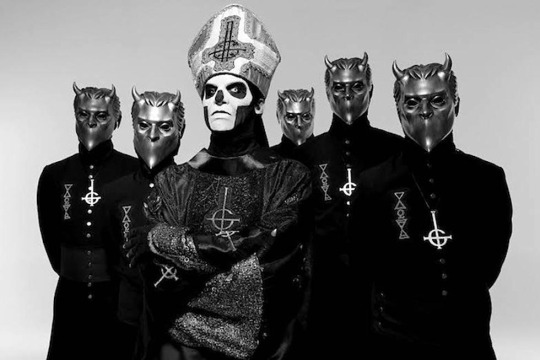
While I’d hesitate to call him one of my favorite musicians yet (he is really good so far though), one of my favorite people in entertainment is Lil Nas X. From his short but sweet songs that crush genre boundaries to his hilarious Twitter feed, this guy is going places and I can’t wait to see what those places are.
And finally, the guy I think may be one of the greatest creative geniuses alive and who has nearly singlehandedly shaped Internet culture with everything he does… Neil Cicierega. While it’s not like I only discovered him in the 2010s - the guy has been an omnipresent force in my life since Potter Pupper Pals debuted - he definitely became the guy I would unflinchingly call the greatest artist of our time over that period. Whether he’s releasing the songs under his own name or as Lemon Demon, you can always be sure that the songs are going to burrow into your brain. His Lemon Demon album Spirit Phone, which features songs about urban legends and the horrors of capitalism, is easily my pick for album of the decade. And then under his own name he released three mashup mixtapes: Mouth Sounds, Mouth Silence, and Mouth Moods. All three are stellar albums, but only Mouth Moods has “Wow Wow,” the bouncing track about homoerotic bee-loving Will Smith and outtakes so good they deserve to be on the next album.
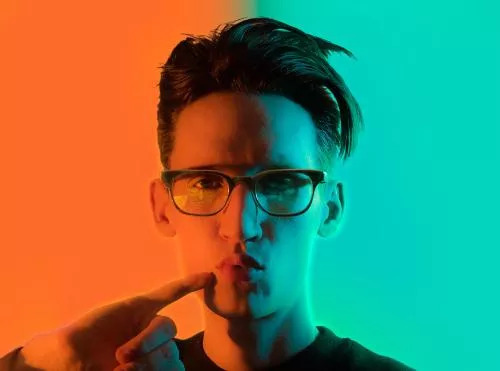
Video Games
Having a PC this decade was great because it let me experience a lot of games I probably wouldn’t have otherwise, like Half-Life, BioShock, Earthnound, Mother 3, and Final Fantasy VI and VII. All of these and more are among my favorite games of all time now, but we’re here to talk about the stuff from this decade I consider great.
It’s hard to talk about this decade in gaming without mentioning Skyrim. Yes, it has flaws and the main storyline is a bit undercooked, but there’s so much fun to be had dicking about in the wilderness it’s hard to be too mad. And if you have mods, there are endless opportunities to expand the game. The same is true for the other game I have sunk countless hours into, The Binding of Isaac: Rebirth. Not only is there a thriving modding community, but it has been supported and encouraged by the creators and some mods have even made the leap into becoming fully canon! It’s always a blast to revisit and see how far I can break the game with item combos.

Surprisingly, Batman managed to get not one, not two, but THREE awesome licensed games this decade! Arkham Asylum, Arkham City, and the unfairly maligned Arkham Origins all kick as much ass as the Dark Knight himself. The former two reunite Mark Hamill and Kevin McConroy as Joker and Batman while the latter features numerous stellar boss battles. The combat in these games is so graceful and fluid, you WILL feel like Batman at some point, be it after flawlessly clobbering two dozen mooks or silently eliminating a room of thugs before they even realize you’re there.
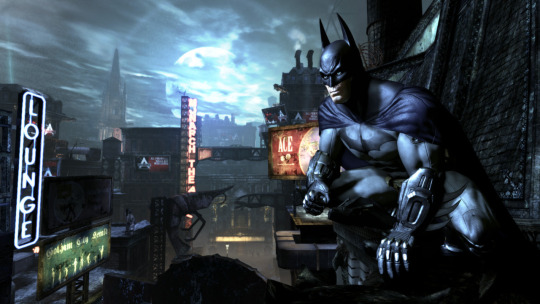
Pokémon had a bit of a rocky decade; it started out strong with the fifth generation, the best games in the series with a great story, region, and sidequests and then just went downhill from there. Not incredibly so, of course - the games were always fun at least - but gens VI through VIII were not the most graceful steps into 3D. Still, every gen managed to produce some of my all-time favorite Pokémon. Gen V had Volcarona, Chandelure, and Meloetta; Gen VI gave us Hoopa, Klefki, the Fairy type in general, and a gorgeous mega evolution for my favorite Pokémon, Absol; Gen VII had the Ultra Beasts and Ultra Necrozma, some of the coolest concepts in the series, as well as Pyukumuku; and Gen VIII gave us Cinderace, Dracovish, Dracozolt, Polteageist, Hatterene, Snom, and Zacian. And those are just samplings mind you, these gens are full of hits.
Bringing back old franchises yielded amazing results. Look no further than the triumphant return of Doom in 2016, which had you ripping and tearing through the forces of Hell with guns, chainsaws, and your bear fucking hands. This game is HARDCORE. Less bloody and gory but no less awesome was the return of not just Crash Bandicoot, but Spyro as well in remakes that are easily the definitive ways to experience the games. And don’t even get me started on the remastered DuckTales!
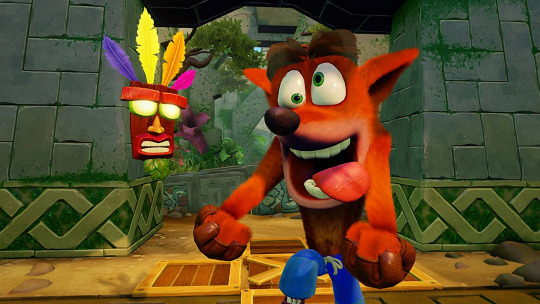
Platinum games did not fuck around this decade, delivering Bayonetta 2 and Metal Gear Rising. The former is a balls-to-the-wall sequel to the amazing original Bayonetta that, while lacking in bosses quite as impressive as the first game’s, is more polished and has a fun story and a better haircut for Bayonetta; the latter is an action game so insane it makes the rest of the Metal Gear franchise look tame in comparison. The latter in particular is in my top ten games ever, with every boss battle feeling epic, all the music kicking ass, and Raiden truly coming into his own as a badass.

Speaking of Metal Gear, the divisive The Phantom Pain easily earns its place here. While much fuss has been made about the game being “unfinished,” it still has a complete and satisfying ending even if it doesn’t totally wrap up the dangling plot threads the young Liquid Snake leaves behind. The overarching themes as well as Venom and his relationship with characters like Kaz, Paz, and ESPECIALLY Quiet make this game, with his and Quiet’s being particularly beautiful and tragic. The Paz quest, Quiet’s exit, and the mission where Snake has to put down his men after they get infested with parasites are all some of the most heartbreaking moments in the franchise. But it’s not all tears; there’s plenty of fun to be had harassing Russians in Afghanistan while blaring 80s synth pop from your Walkman. Oh yeah, and fuck Huey.
The Ace Attorney series also thrived, with both Spirit of Justice and Dual Destinies transitioning the series into 3D a lot more graceful than some other franchises while still maintaining the with and charm the series is known for. And if that wasn’t enough for my point-and-cluck adventure needs, Telltale had me covered with The Wolf Among Us and the first season of The Walking Dead. The stories and characters of those games are so good, it’s enough to make you sad they never got a timely sequel or sequels that weren’t shit respectively.
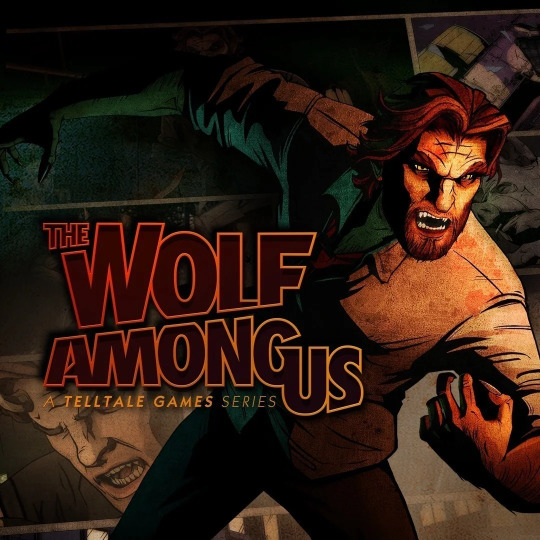
This decade is when I really got into fighting game, though I’m not particularly good. I supported Skullgirls (and am even in the credits!), and got into Ultimate Marvel vs. Capcom 3 and JoJo’s Bizarre Adventure: All-Star Battle (and I also got into its spiritual predecessor, Heritage for the Future). But by and large my favorite fighting game of the decade and the one I’m actually pretty good at is Super Smash Bros. Ultimate, the most ridiculously ambitious crossover in video game history. The fact that the game is STILL getting more characters added is a testament of how insanely great the game is because instead of being mad that there’s so much DLC, people are going rabid waiting for news of more. It’s such an awesome, complete game out the door that the DLC feels earned rather than half a game being held hostage. Other devs, take note!
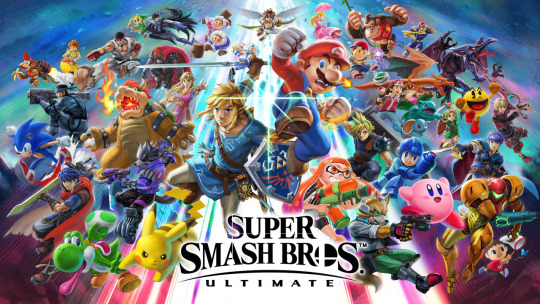
A lot of franchises put their best foot forward for sequels. God of War III was an awesomely bloody finale to the original journey of Kratos, with more epic bosses than ever; now he’s off fighting Norse gods, and I hear that game is even better! Portal 2 is just an absolute blast, and easily surpasses the first game on the merit of having Cave Johnson alone; the fact we get Wheatley and the malfunctioning personality cores honestly feels like overkill. Then we have BioShock… 2. While it’s certainly not as good as the first game, I think it was a lot of fun, and it got way too much flak.
I think it definitely aged better than Infinite which, while still a good game in its own right (it’s hard to hate a game with a character as endearing as Elizabeth), definitely was not warranting the levels of acclaim it got with such a muddled narrative. “Overrated” and “overhyped” are not words I keep in my vocabulary and I certainly would not describe Infinite as such, but I do feel like people got swept up in the gorgeous visuals and the story bits and characters that are effective and so weren’t nearly as critical of its flaws. It’s still a good, fun game with an interesting world, but it pales in comparison to the other two BioShocks. I feel like The Last of Us is in a similar boat. That being said, I couldn’t tell you why; it has a great story, good characters, plenty of replayability, and fascinating enemy design. But despite all that, I appreciate this game more than love it. It’s the Citizen Kane of video game sin that regard at least.
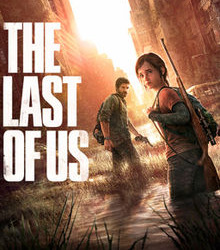
I’d be remiss to not mention the big indie successes of the decade. Shovel Knight is easily one is the greatest platform era ever made, taking everything great about the platformers on the NES and SNES, removing the bullshit, and delivering numerous bonus campaigns with unique playstyles. Then there was Abobo’s Big Adventure, a marvelous mashup of all sorts of games starring the beloved Double Dragon mook as he goes on a bloody quest to save his son. It’s a blast and there is tons of variety but some sections are definitely as hair-pullingly difficult as the games that inspired them. And then there is Doki Doki Literature Club, the free visual novel that brutally subverts your expectations. Sadly, I do feel the game loses some impact on subsequent playthroughs, but it’s still a great, effective story that skillfully utilizes meta elements.
Still, the greatest indie success of them all is Toby Fox’s masterpiece, Undertale. Charming, funny, emotional, and populated by a cast of some of the most fun and lovable characters ever conceived, this game was an instant smash and is still talked about to this day. Sure, things like Sans have been memed to death, but it’s hard to not just love and cherish the beautiful world Toby Fox managed to create. This game may not be the greatest game of all time, but for what it is I wouldn’t hesitate to name it the game of the decade.
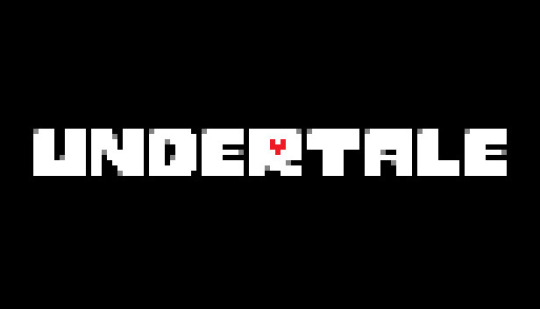
There was a lot of great art in the 2010s, and while I couldn’t get around to all of it, I’m so happy with what I got to experience. Here’s hoping that the 2020s can be just as amazing!
5 notes
·
View notes
Text
ASM Annual 2018 rant
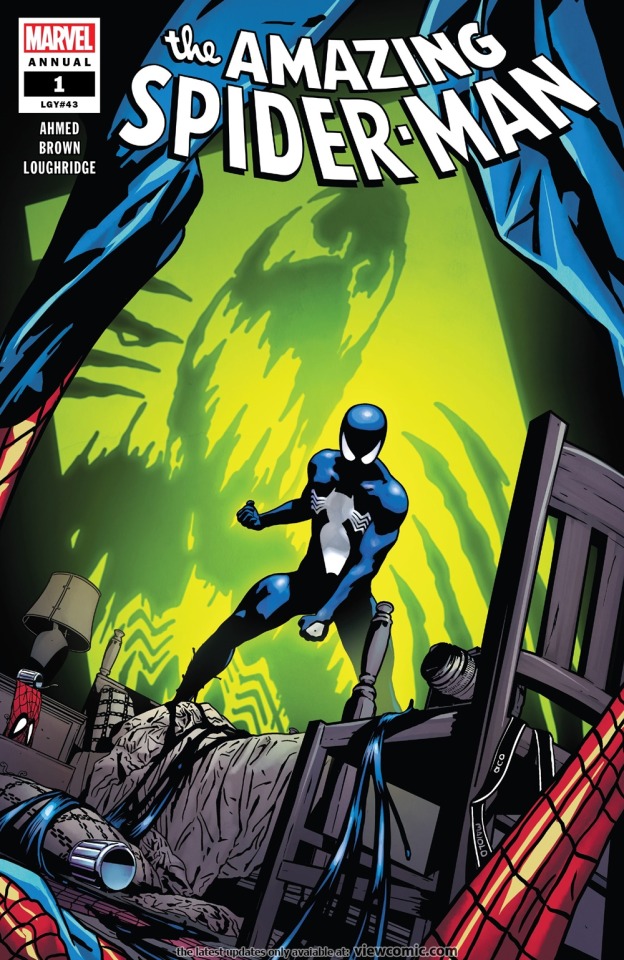
There will be spoilers for this and I’m going to presume you’ve already read it so I’m not going to give you a synopsis.
In short it was at best mediocre and at worst a waste of your money.
First of all maybe this is just me but the art was not that great. Overly sketchy, under detailed and it failed to capture the time period. If you wanna see a throwback story with art that at worst nods towards the style of the time, check out Untold Tales of Spider-Man or even better ASM Annual 1996, with art work by Ron Frenz and Romita Senior himself!
I already complained about how Black Cat was written out of character in regards to her attitude to the black costume and how her costume was inaccurate too.
But miraculously both things come off as WORSE in the full context of the story.
Going back to the art, Garry Brown directly references Marvel Super Heroes Secret Wars #8 where Spidey first got the black costume. So...he is CLEARLY checking the old artwork and using it as reference and yet...he screw up Felicia’s costume.
And despite what I’ve seen some people say, that it was just an art flub on like one panel of one page no, he draws Felicia multiple times and the costume design is the same, Brown genuinely believed her outfit looked that way or else DGAF and drew it how he wanted. He wasn’t even entirely consistent with his own error because he draws her with white books in one panel of the comic.
Then we get to the story itself.
First of all in terms of judging this story purely in isolation (which you shouldn’t do in general, but ESPECIALLY when it bills itself as an untold tale meaning it’s entire premise rests upon how it fits into the history) it’s at best okay.
Honestly my biggest take away was like...what was the point of this story?
Okay, I grant you a story set in the Alien Costume Saga from the symbiote’s point of view diving into its head could maybe be interesting. But you’d have to have something really interesting involved because the symbiote itself was a simplistic animalistic creature back then, it wasn’t the more evolved and twisted entity we saw in the 2000s or in more modern stories. It learned emotions FROM Spider-Man himself.

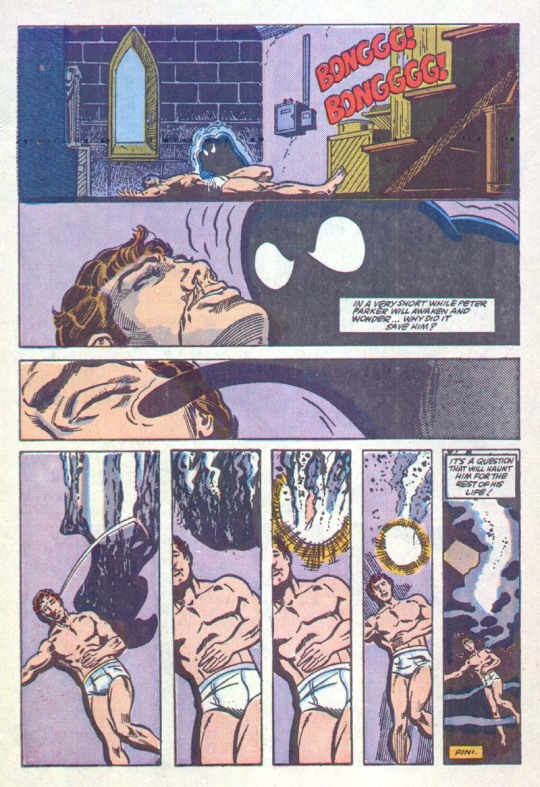
Like what was there really worth exploring from the symbiote’s POV. It didn’t change by the end of the story beyond the ways we already knew about because again, this is a flashback story.
So basically we got an extra length story where we learn that the symbiote briefly befriended some kid.
Wow. That was worth over $4.
Looking at this story in the context of the time it was raising a million questions for me in terms of how the hell it fit.
In the story Peter visits Aunt May, but it was in literally the second issue during the ACS that Aunt May and Peter had a huge falling out over his dropping out of grad school, something not resolved until AFTER the ACS wrapped up.
The impression given by the overall story heavily implies Peter has had the costume for a little while and that the symbiote’s night time joyrides have been draining his energy by the time we get the Aunt May scene. This doesn’t add up because there wouldn’t have been time for that.
Another arguable problem was Felicia referencing Peter taking the costume to Reed Richards. Peter does do this but much later on and I don’t think Reed’s name ever cropped up between Peter and Felicia back then. Granted, I double checked and Reed had offered Peter the chance to check out the suit from the beginning of the ACS, meaning it’s possible for that he mentioned it to her off panel. But again her attitude doesn’t add up.
There are a few other Felicia problems too.
Peter says he was unaware that he and Felicia were on a date, which is weird because they spent MOST of their time together fighting crime and it was made explicit that that was to them what going out to the movies or for dinner was for a normal couple.
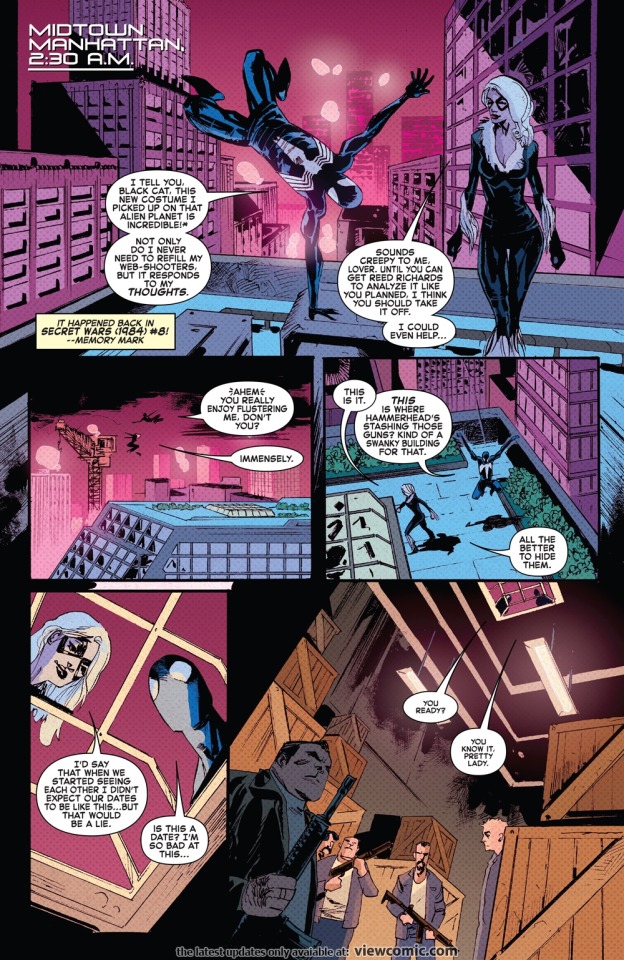
This is literally one of Peter’ problems with their relationship, they spent so much time doing that and not just being a normal couple. Hence he broke up with her!

Later Felicia reprimands Peter for being 2 hours late and tells him he’d have to put in more of an effort if he wanted her to stick around.
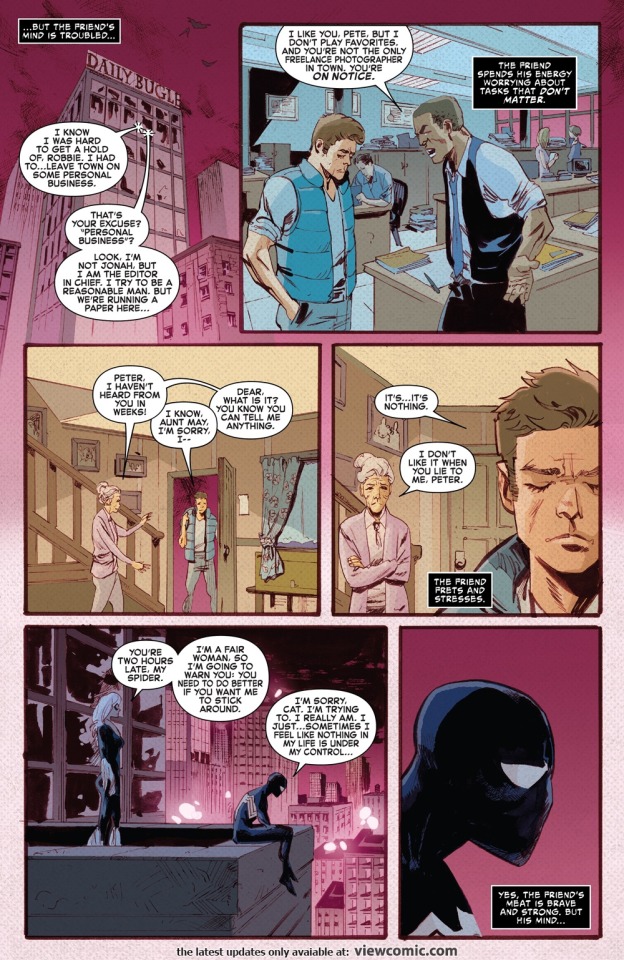
There is no single moment that explicitely calls this out as OOC for her, but in context this is BS. Felicia was so devoted to her relationship with Spider-Man that she not only gave up her criminal ways (twice) and risked her life but went behind his back to get powers from the Kingpin and lied about it afterwards. She is very obviously not going to say something like that unless she was ribbing him and that was not the impression given off by the scene.
Finally there is a scene where she enters Peter’s bedroom via his window to just...watch him in his sleep I guess? Then Peter is slightly weirded out but otherwise chill.
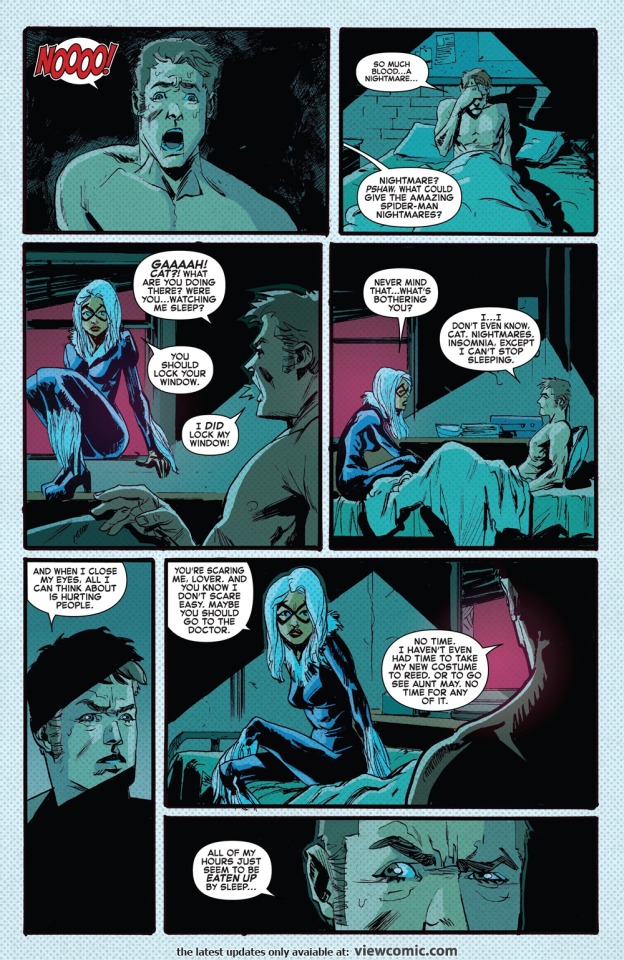
Putting this stalkerish moment aside, it doesn’t jive with either of their characters back then.
On Felicia’s part she had a problem with Peter’s civilian side and preferred to minimize time spent in Peter’s company rather than Spider-Man’s.
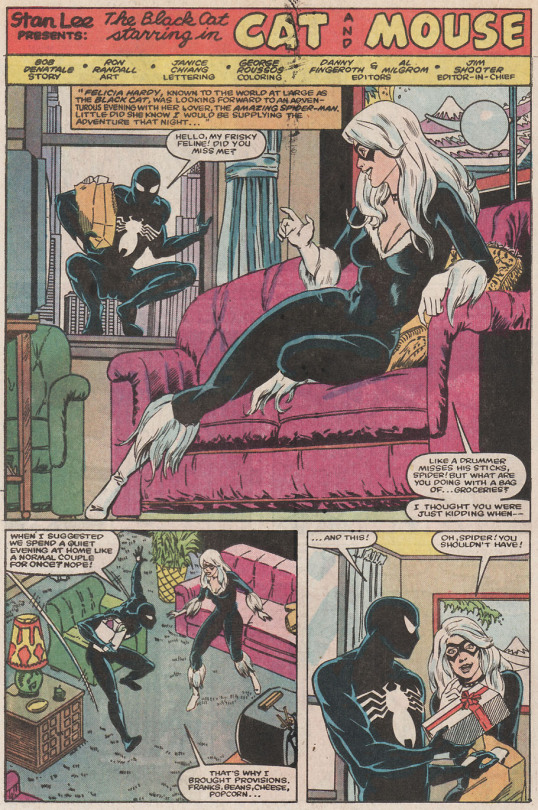
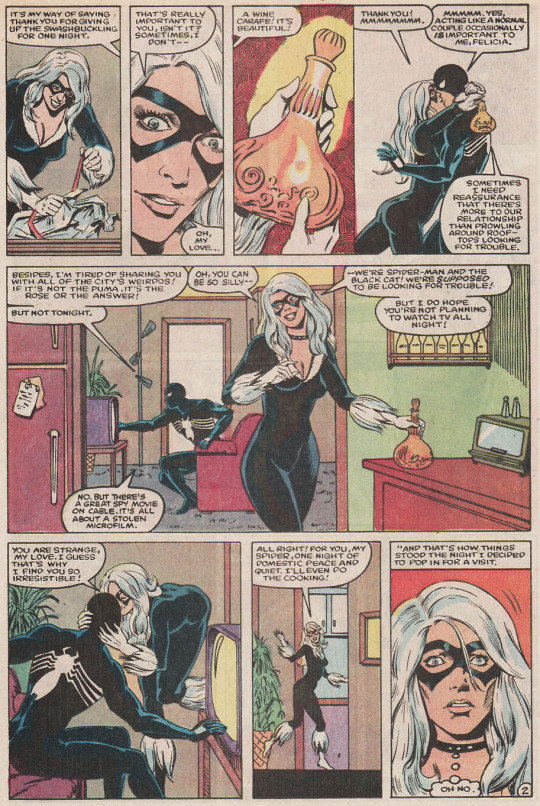
On Peter’s part he had a major problem with Felicia coming into his apartment like this because she was being cavalier with his secret identity. A good example can be found in ASM #258 which just so happens to be the conclusion of THE ACTUAL ALIEN COSTUME SAGA FFS!
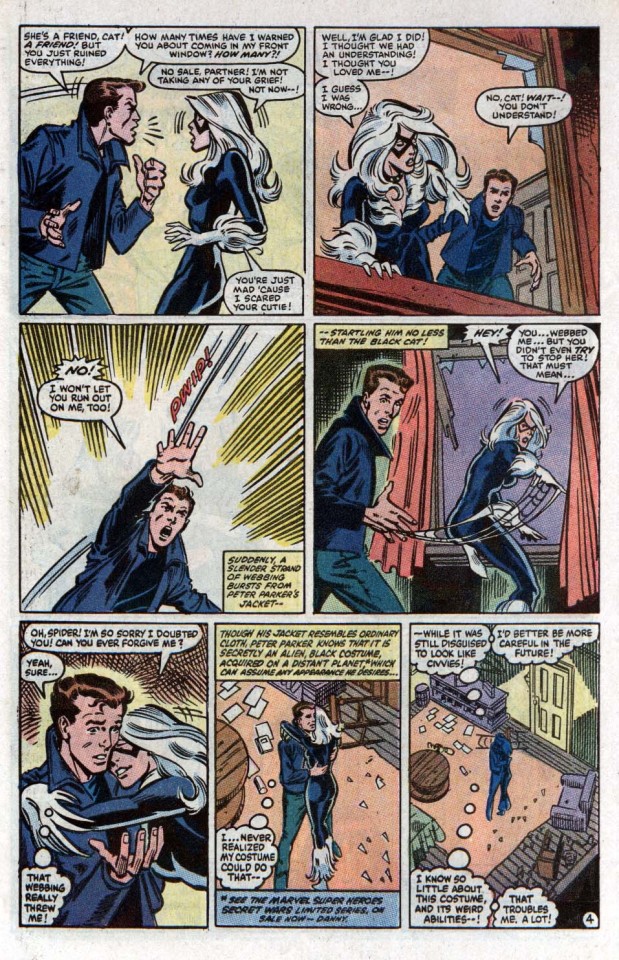
Then we have the main story itself, the symbiote’s night time activities.
This is a tiny thing but the story explains that the symbiote itself is inducing sleep and controlling what Peter feels during it’s joyrides. This makes sense and is fair enough, up until the point where Peter’s body is being physically injured.
Now, as a lover of the Spectacular Spider-Man cartoon, I will admit my second favourite episode is where the symbiote hijacks Spider-Man’s body and defeats the Sinister Six, only for Peter to wake up with some bumps and bruises he was unaware of. So I feel somewhat hypocritical criticising the story from that angle.
I do not however feel bad at all about asking how the Hell did the symbiote manage to keep Peter asleep when it was literally being put through immense pain and partially slivering off Peter’s body!

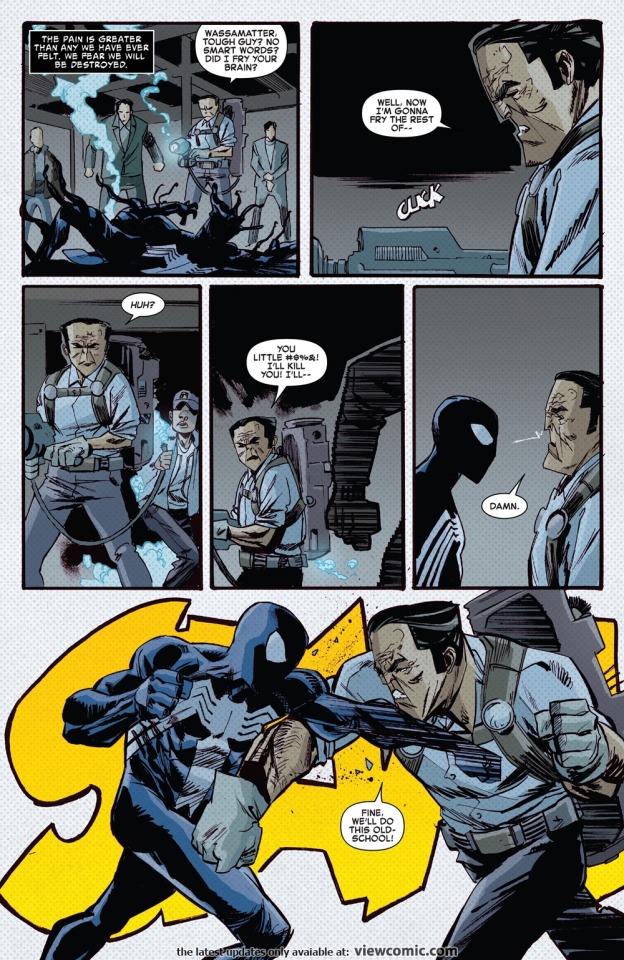
Isn’t the whole POINT of symbiosis that two organisms are one so if the symbiote feels pain shouldn’t Peter as well?
If the symbiote is feeling pain and literally losing it’s grip on Peter’s body, how is it still so in control of what he feels that it’s keeping him asleep?
How does that even make sense from a pure instinctive survival POV?
Moving on the symbiote gets overly aggressive with the criminals it fights to the point where only by taking advice from a kid in it’s immediate company does it help rescue people sans any form of gbh.
I dunno what the point of this was beyond I guess making it more explicit that the symbiote wasn’t JUST swinging around but also fighting crime. Maybe to foreshadow the symbiote when it and Brock went full lethal protector?
Anyway one aspect of the story which is inconsistent is whether anybody even recognizes Spider-Man. Now yeah in the ACS people DIDN’T recognize Spider-Man in his new black costume at first so this lack of recognition could be excused depending upon how early in the timeline this story is supposed to take place. Problem is the story doesn’t occur over like one or two days it’s obviously unfolding across various nights in which the black costume has been joyriding Peter. Peter himself is feeling the fatigue which if this was one or two nights wouldn’t add up.
In the first scene of the costume going out crime fighting a woman recognizes Spider-Man immediately, implying that there HAVE been at least some photos in the papers showing the new suit and confirming this as the same guy.
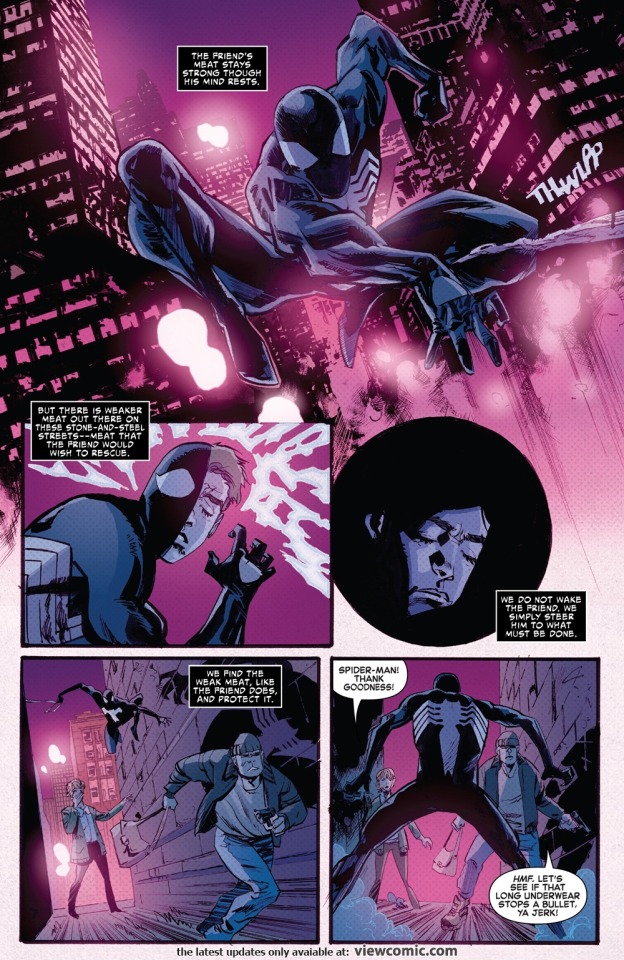
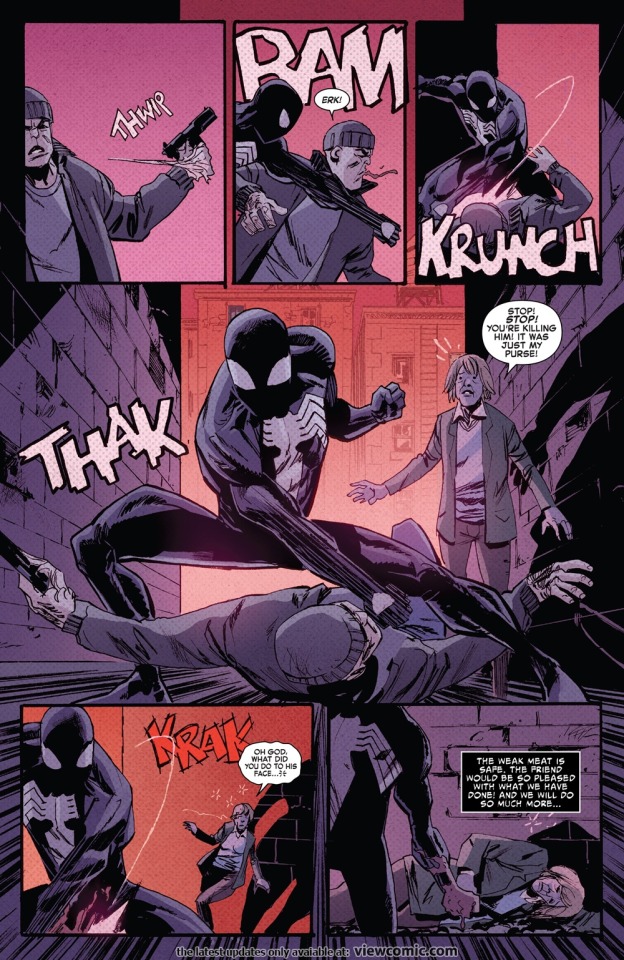
However later when we meet the kid the suit befriends in that scene the kid is seemingly unaware this guy even is Spider-Man referring to him as a new hero.
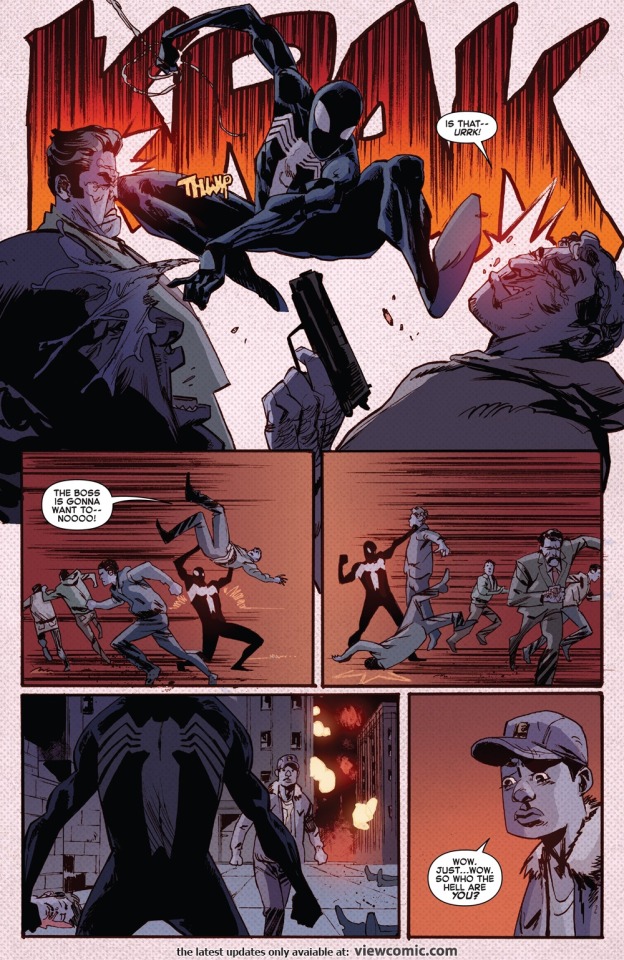
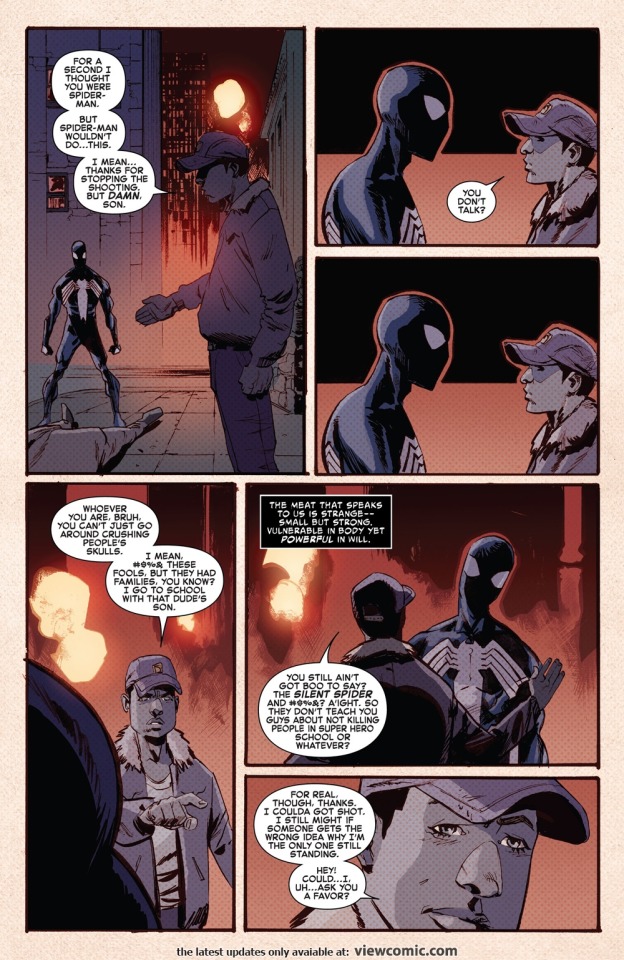
That same night the kid gets abducted by Hammerhead who explicitly calls him Spider-Man. But when the suit rescues the kid he says he doesn’t know who he is but that he could be a good hero someday.
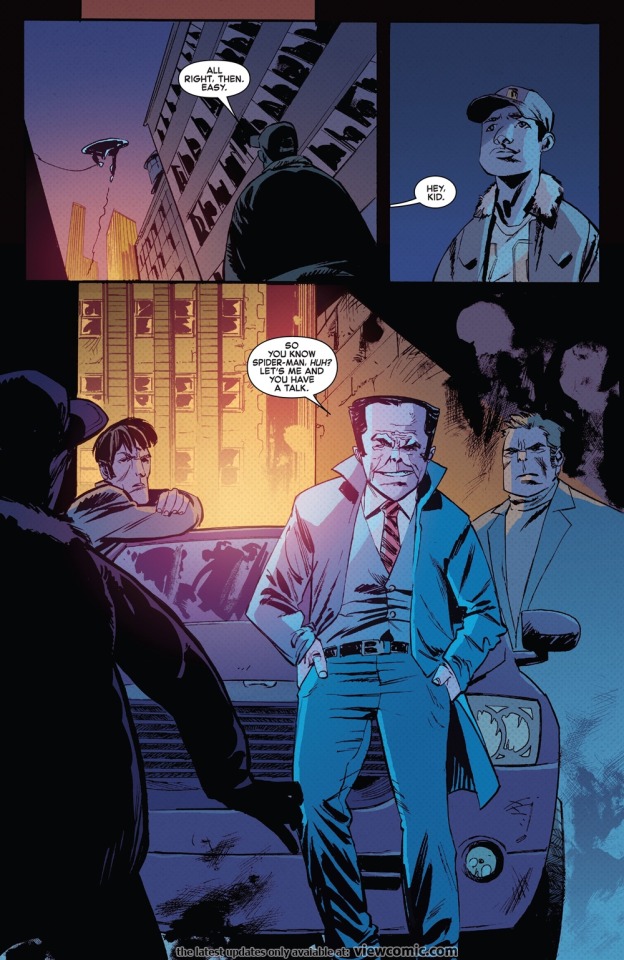
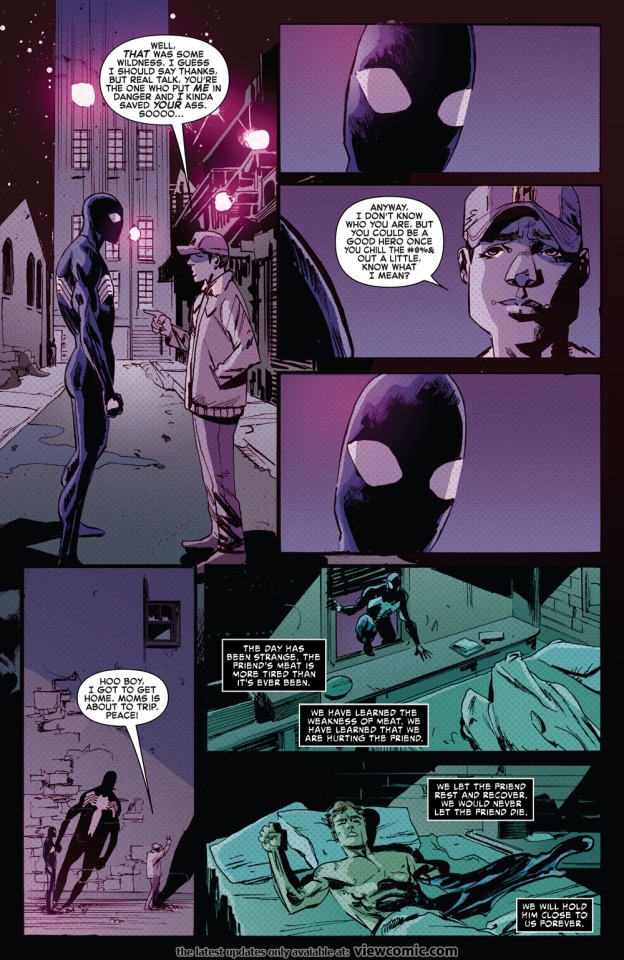
I honestly tried to consider that the kid was referring to Spidey’s civilian identity. But the fact that in their first and last meeting he is talking about how the symbiote could be a good hero someday and told it to be less aggressive and more caring for civilians, implies that the intention was for the kid to STILL not realize this was Spider-Man.
This gets even dumber in the context of Marvel’s timeline. However you slice it if modern Spider-Man stories happen in 2018, then the ASC should’ve happened at the biggest of pushes like 10-12 years ago in 2006, probably even more recently.
How in the Hell does anyone, let alone a kid who’s likely consuming more media than older people, in like 2006 or later NOT hear about how this new dude in black is Spider-Man?
Even if he doesn’t follow the news that’s one of those things you’d pick up via osmosis.
Especially since the media doesn’t shut up about fashion and celebrities and in this case a celebrity bigger than any real life ones has massively changed his costume (and now more closely resembles notorious vigilante the Punisher).
Now let’s talk about the symbiote’s violence.
The story implies the symbiote is trying to help Peter by fighting crime for him as he sleeps. Except the symbiote is violent in a way Spider-Man never is, maiming and killing people.
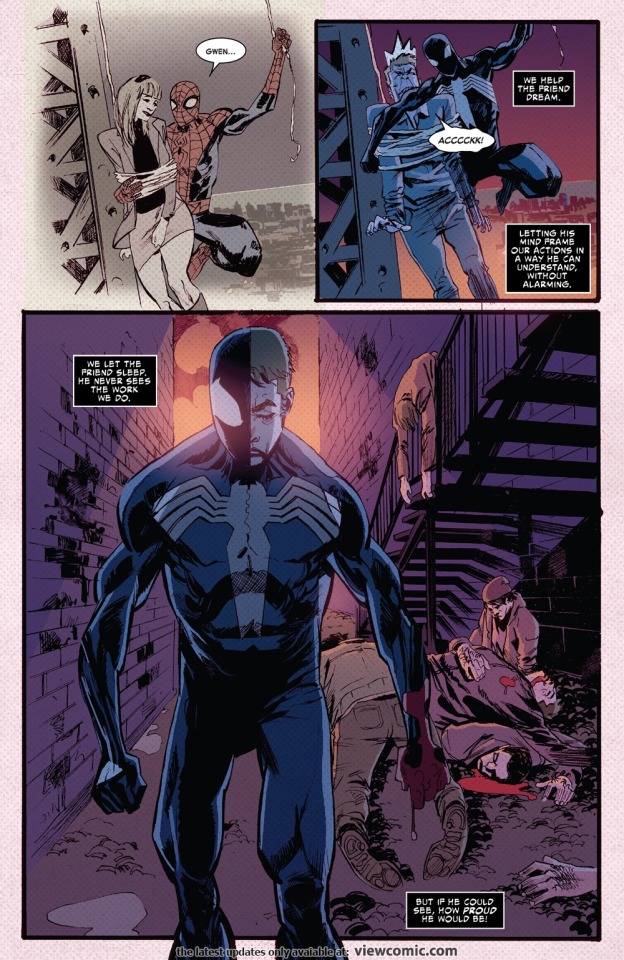
This makes sense...for Venom. But the symbiote itself is not inherently violent beyond bestial instincts. It committed immense violence in the company of Brock because Brock himself was a violent disturbed individual.
If the symbiote wants to serve it’s host, it’s ‘friend’, by doing what he routinely does why does it go so much further than he does?
In fact if it’s bonded to him and knows his inner thoughts enough to induce images of Uncle Ben and Gwen Stacy then surely it is aware that Peter doesn’t act like that?
A far bigger problem is the general public’s reaction to all this.
Again, people obviously know that black costume Spider-Man is the same guy as the dude with the red and blue suit.
So...why is NO ONE reporting that Spider-Man is maiming and killing criminals?
Spider-Man had been demonized for YEARS by Jameson and framed/blamed for various crimes including the murders of George Stacy, Norman Osborn and IIRC Gwen Stacy too!
If Spider-Man was now acting this way it’d be MAJOR news!
In fairness I guess the implication is that the symbiote did this stealthily enough that not too many people found out about it. And every witness that did either forgot about or shut up about it.

Which seems...kind of difficult to believe. It’s difficult to believe, especially if this story took place in the CCTV laden 2000s, that NO ONE saw this happen or else forgot or else kept it quiet. In Hammerhead’s case I do not understand WHY he never spoke about it and why he never ever brought it up to Spider-Man ever again.
Then we get the biggest ‘You really didn’t put much effort into this at all did you’ moment of the story right towards the end.
Okay so the implication is that this whole adventure with Hammerhead and the kid might’ve happened during ASM #258 itself when the symbiote took control of Peter’s body in the middle of that issue. I say this because the page immediately after the symbiote tucks peter back into bed is Peter taking the costume to Reed Richards.
I do not know why but for some reason the idea that the climax of this annual transpired specifically during ASM #258 just bothers me for some reason even though I can’t seem to find any explicit contradiction or problem with it doing so.
The same cannot be said of the actual scene involving Reed.
The scene plays out differently in various small but noticeable ways and one big egregious ‘This is the laziest lack of editing and research ever’ kind of way.
I’ll list them out in a second but it’s easier to just to a side by side comparison of ASM #258 and this annual.
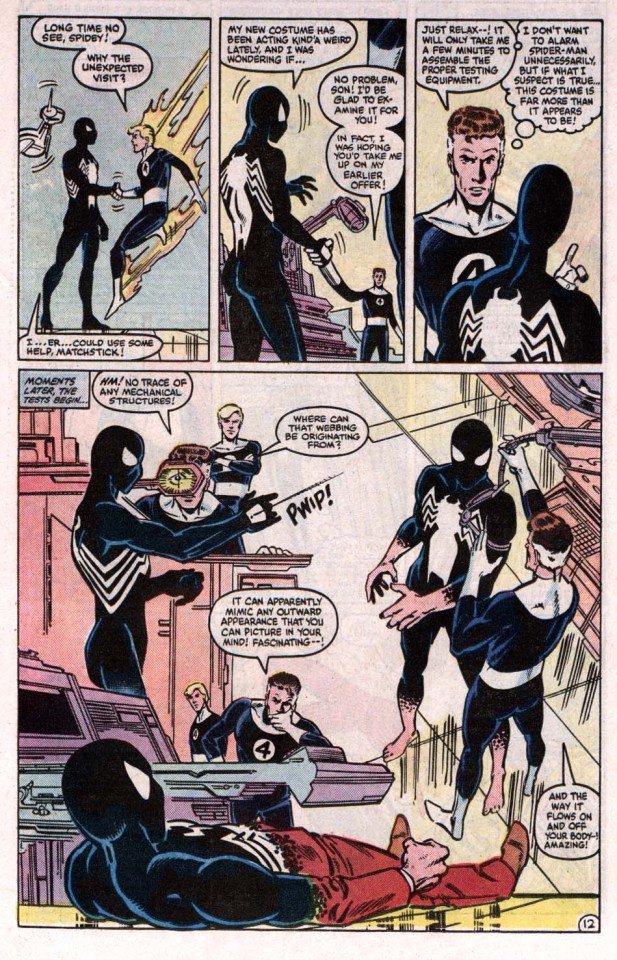
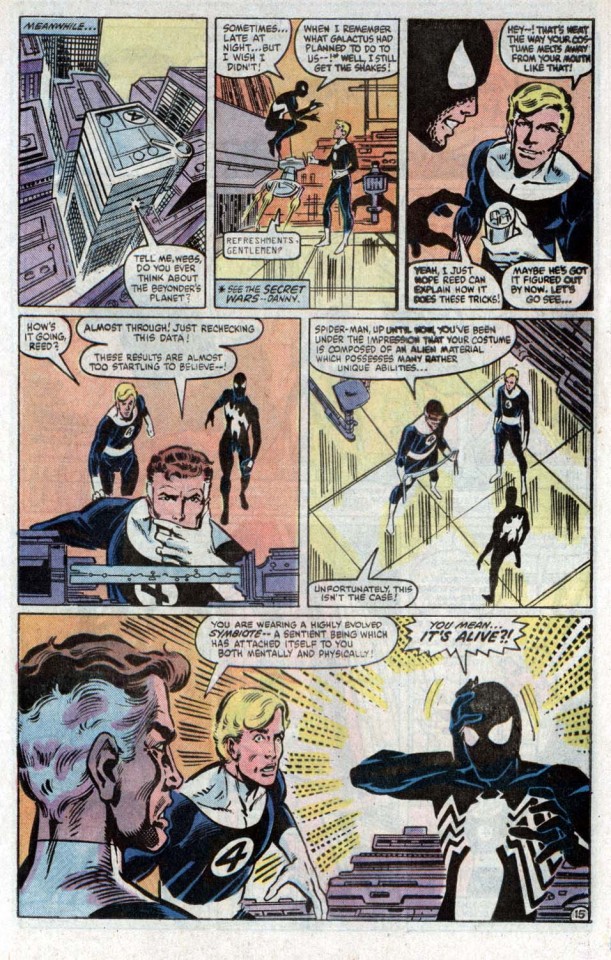
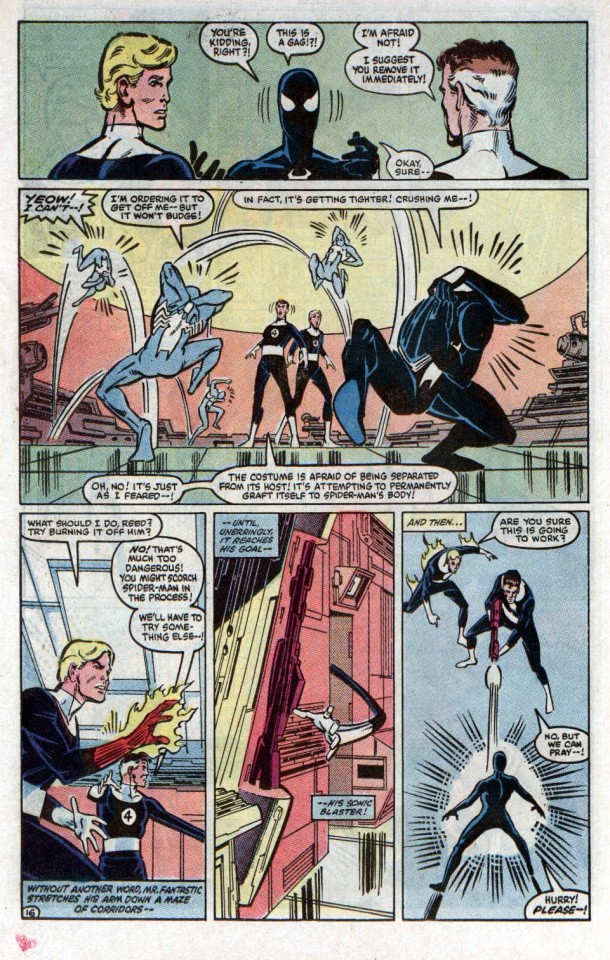
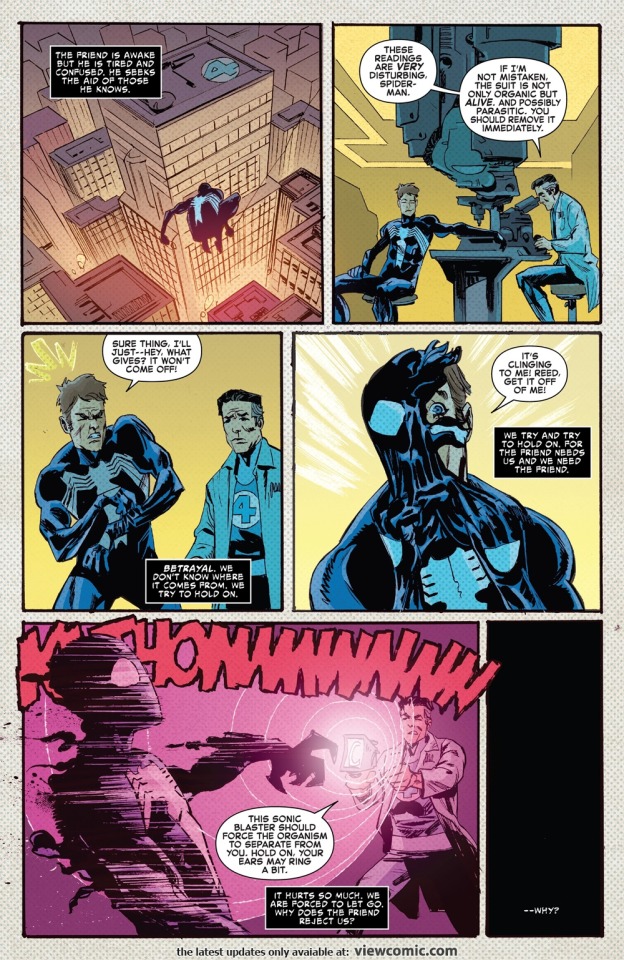
· The ‘choreography’ (for lack of a better term) of the scene is different. In the annual Reed and Spidey are sitting down and in the middle of examining Spider-Man’s suit when Reed delivers the news that it is alive. In the original story Reed had already conducted all his tests and Spidey was waiting around to hear the news which Reed delivered to him and Johnny whilst all three of them were standing upright.
· Reed’s dialogue explaining the symbiote is alive is totally different and far more blasé, whereas originally it was longer and ended with the reveal as a shock, Peter reacting accordingly
· Peter is casual about learning his suit is alive and about removing it only getting distressed when it starts clinging to him.
· Reed wasn’t wearing a lab coat in the original annual
· Reed was accompanied by Johnny
· The Sonic Blaster is totally different, resembling a gun you could hold in one hand whereas in the original issue it was shaped more like a rifle
· The annual implies Reed busted out the Sonic Blaster almost immediately after the symbiote tightened it’s grip on Peter when there was several panels depicting Peter’s struggle and Johnny and Reed’s attempts to help him and retrieving the Sonic Blaster
· Oh yeah and there is the teeny weeny fact that in the original story, unlike this annual, PETER DIDN’T HAVE HIS MASK OFF!
I’m sure there are some who will be like “Oh get over it it’s a tiny little mistake from a comic over 30 years old”.
NO!
This is not a tiny mistake.
When your series is about a superhero with a secret identity who knows that identity and when is a HUGE deal innate to the narrative.
But what makes this mistake so transcendentally lazy on the part of the writer and/or artist and definitely the editor(s) is that Reed NOT knowing Spider-Man’s identity is a plot point for the rest of the story!
You ever see a video game, info book or collage of Spider-Man’s costumes and see that one funny looking outfit where he was wearing what looked like a lame blue Fantastic Four outfit and a paper bag over his head?
Yeah, this is where that came from!
Spider-Man didn’t want Reed or Johnny to know who he was so he covered up his face, necessitating Johnny provided him with an old suit and lieu of a mask gave him a paper bag.
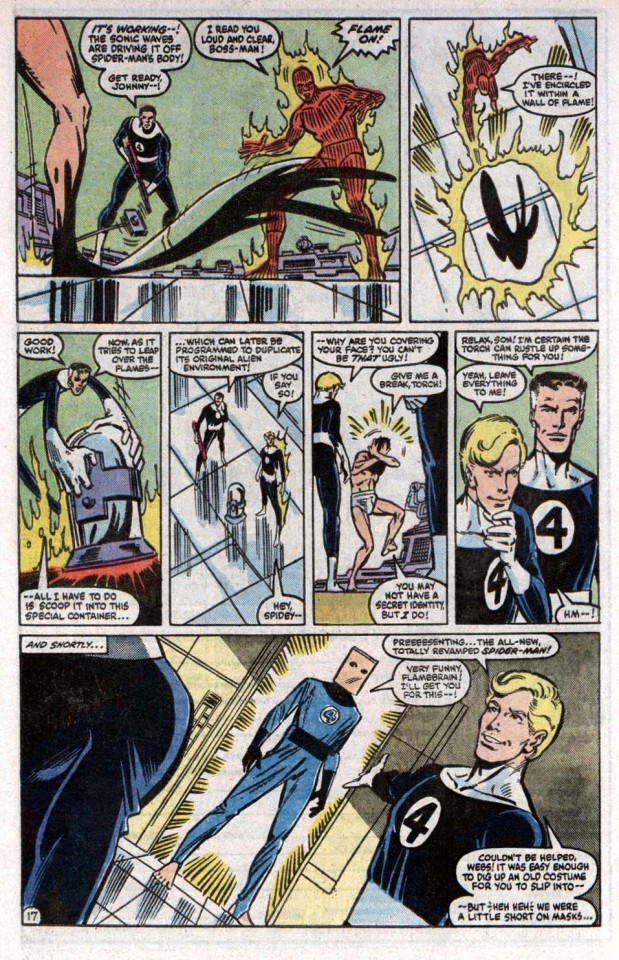
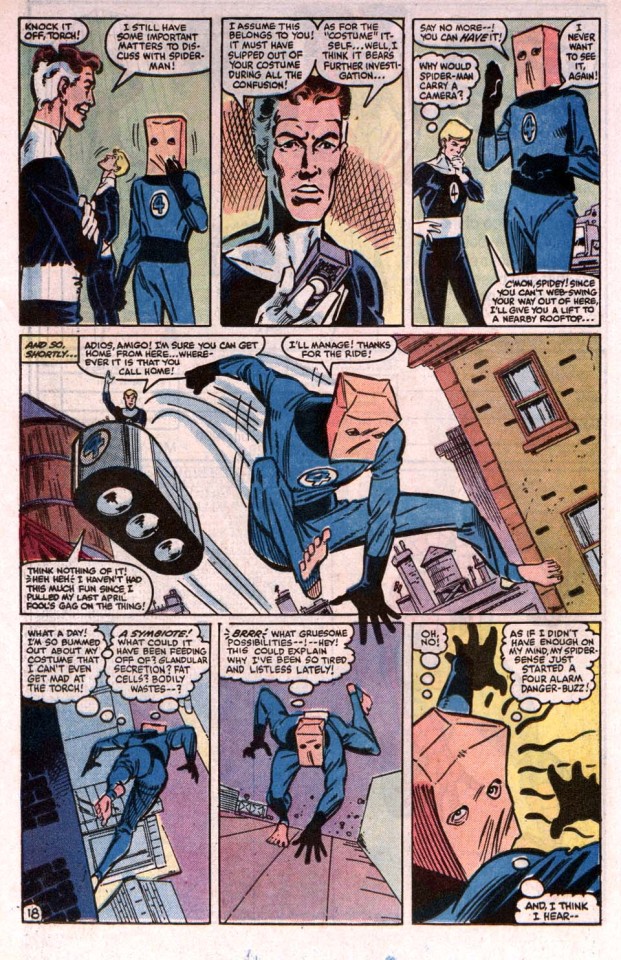
Spider-Man is the Amazing Bag-Man for 6/22 pages of the conclusion to the story this annual is directly referencing!
It���s a fairly well known piece of Spider-Man history, being one of the more famously funny moments of Spider-Man lore and one of the great examples of the Parker Luck.
And it was all part of a historically VITAL story. Not just for Spider-Man but think how much of Marvel history has involved one symbiote or another, there were three EVENTS built around them across the last few years alone FFS!
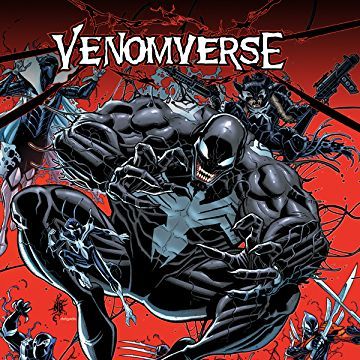
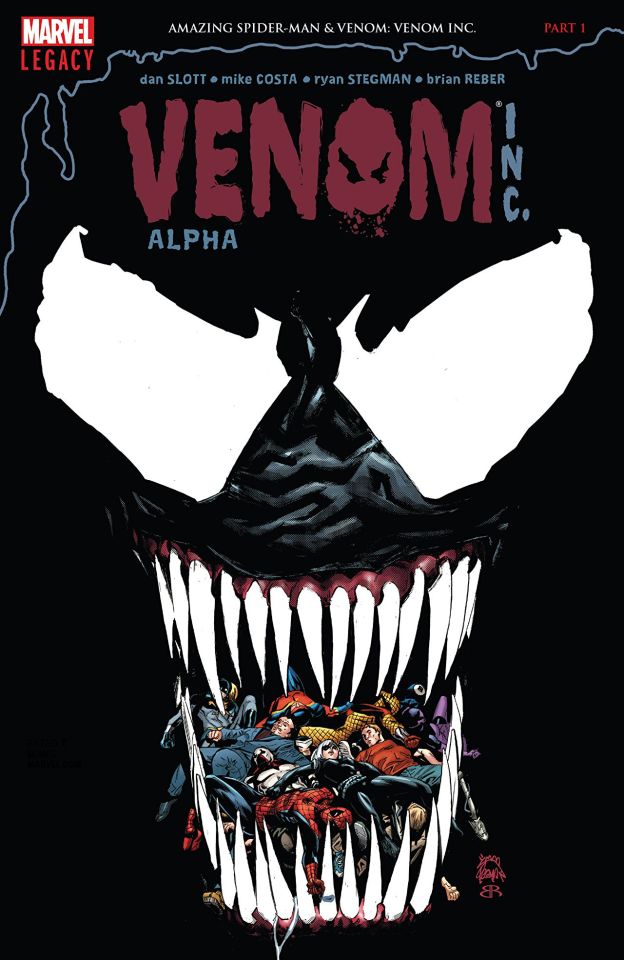

And the people behind this comic book blatantly didn’t bother to re-read the damn issue, let alone the over all arc!
And the most ironic part about that?
The very last page of the annual includes a message from the editor talking about how interested he was in this era of Spider-Man, how it was one of his favourites and he even recommends trades collecting the story arc!
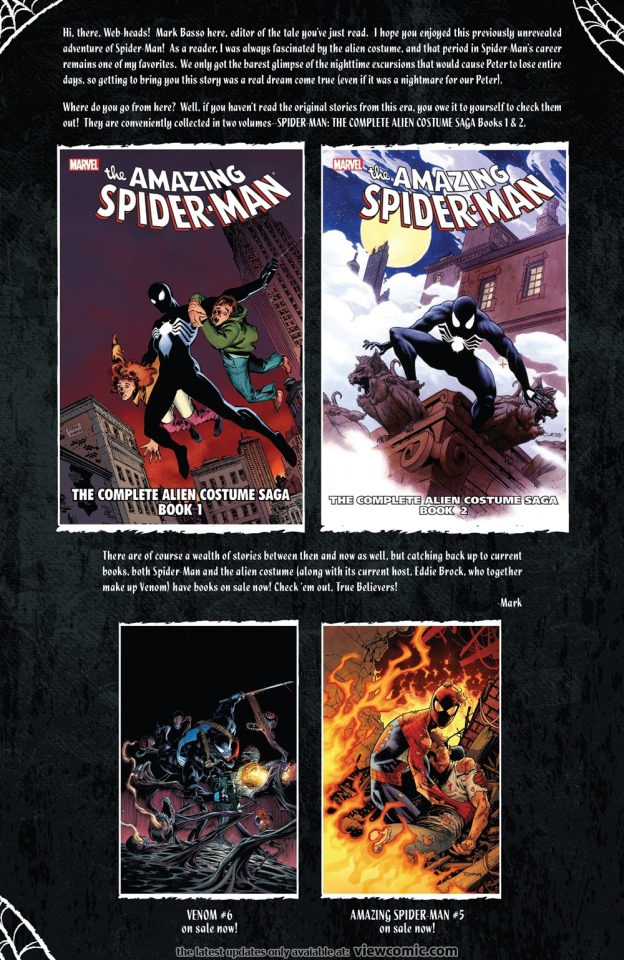
Like fucking take your own advice maybe?
Two final points to end this rant on.
The impression given by the editor’s message and the over all story was that they seemed to think that they were the first or only people to do a flashback tale about what the symbiote was doing whilst joyriding Peter’s body.
They were not.
In fact it seems like every damn decade someone decides to tell that story.
In 1995 as part of the ‘Planet of the Symbiotes’ Super Specials Dan Slott, in his very first canon Spider-Man story ever, used that idea. And whilst it didn’t shit on the ACS in general it did shit on the character of Jean DeWolff by pretending she never had romantic feelings for Spider-Man.

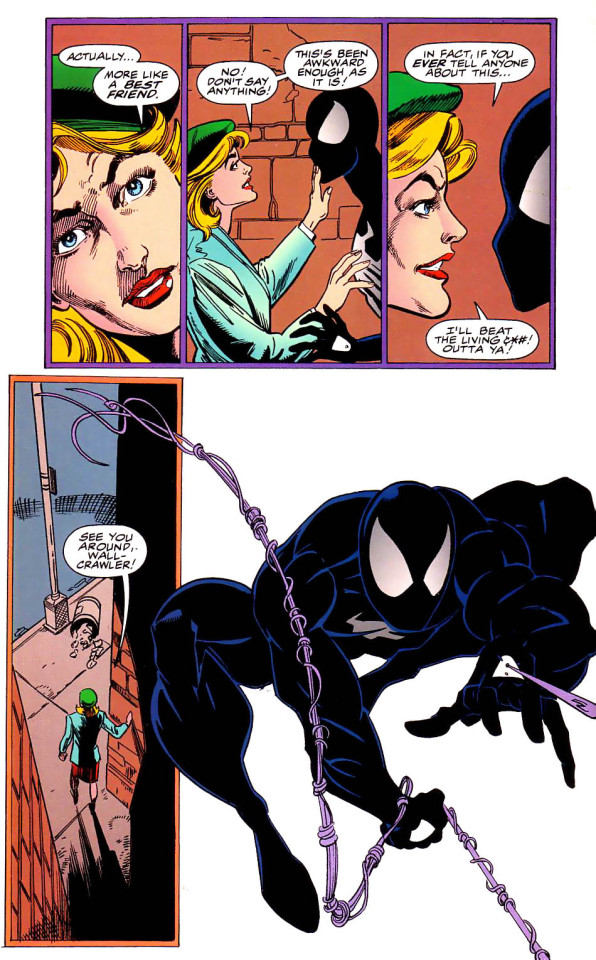
Because even in his formative days as a young intern cheating his way through Marvel’s door Slott had to fuck up characterization I guess.
In the 2007 as part of ‘Back in Black’ Sean McKeever (he of ‘Spider-Man Loves Mary Jane’ fame) did another storyset during the ACS. It wasn’t wholly about the symbiote’s night time activities but it did more subtly with just a few moments get into the symbiote’s head, depicting it’s loneliness and homesickness. Whilst that story also screwed up Black Cat’s costume there were no other egregious continuity errors, the story fits pretty neatly into the histories of Spider-Man and also the Sandman.
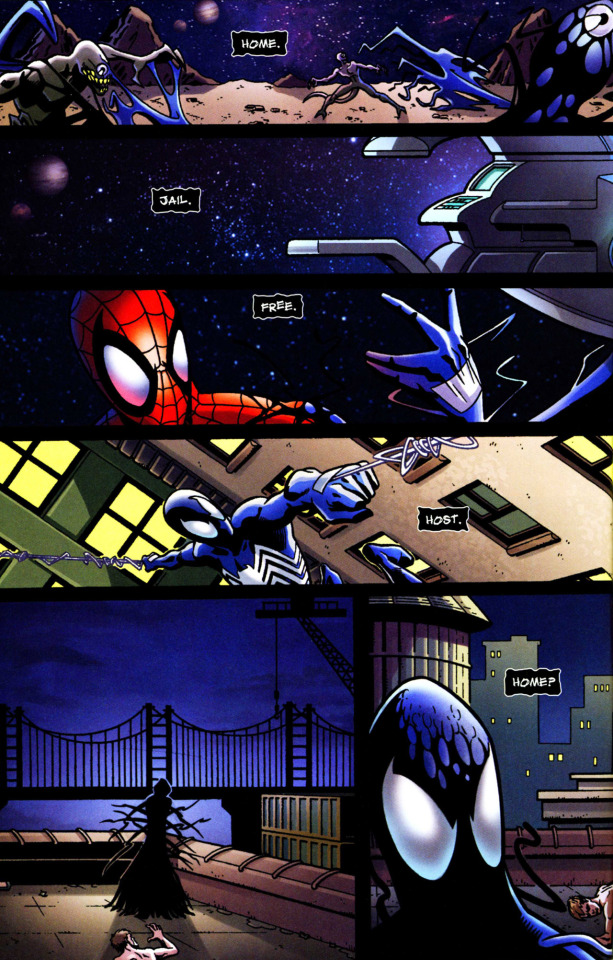
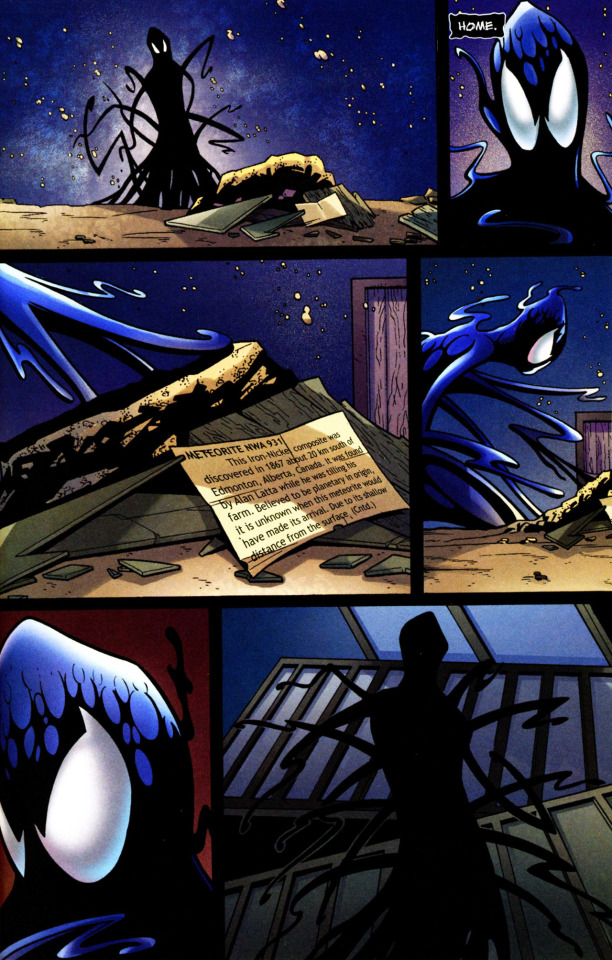
It was infinitely better than this story which I don’t think anyone should ever regard as canon going forward.
P.S. How poorly produced was this annual?
So poorly produced that no one considered that despite it going against the literal meaning of the word this comic is the second Amazing Spider-Man annual for 2018!
#Spider-Man#Amazing SPider-Man#saladin ahmed#Garry Brown#Peter Parker#alien costume saga#venom#Venom symbiote#black cat#The Black Cat#Felicia Hardy#Aunt May#May Parker#Tom DeFalco#Ron Frenz#Sean McKeever#Dan Slott
47 notes
·
View notes
Note
Hello I am back again, mostly because I'm curious and you seem to have more infomation about the newer series of transformers while I am in the dark ages. By dark ages, I mean I got through Gen 1 and beast wars and then never finished. What are recommendations about the newer Transformer series, as a place to start?
Hello again :3 Now I haven’t seen every modern TF cartoon but i’ve seen a handful, and I’m definitely not biased in recommending Transformers Animated to start xD The characters are cute and charming and all get some awesome development through the show, the style might take some getting used to for some but you grow to love it, the writing is amazing, the world building is absolutely nuts and so in-depth and all its stories are really interesting and entertaining. it spins a lot of TF concepts on their heads (prime is a rookie rather than some well-known leader, cybertron’s fine and under autobot control rather than Dead Completely, the war is long over but threatening to start up again…) It’s also got LOADS of characters (so you’ll probably have at least one favorite, or end up like me wiTH SEVERAL–) and throwbacks to earlier series that don’t feel forced or out of place. The only problems I have with the series is the fact that it got cancelled (not its fault) so when you finish it you’re left with a whole lotta salt at hasbro and cartoon network, and the human villains are kinda annoying but IMO they’re not the worst thing ever xD They don’t even appear that often. It can be really lighthearted and silly but it has its darker moments and episodes, and it gets more serious in season three. It’s got lots of what i think is called “fridge horror” too so that’s fun. It’s also neat because of how it doesn’t just blatantly paint the bots as Good Guys and the cons as Bad Guys, I mean the cons are definitely still horrible but they’re not just Evil For The Hell Of It, and the autobots do a lot of… really questionable things. Things are more gray than usual. If you watch and like it pls go email hasbro asking for season four lsjkdfjkldf
Then there’s Transformers Prime, which came after Animated - It was made for older audiences (teens iirc) and def gets pretty… dark. But the animation is really nice and the characters are too, especially the decepticons. Actually, the cons are more entertaining than the autobots half the time xD the human characters start out annoying (… okay, mainly Miko) but get some nice development over the course of the show (ironically again Miko gets the most development, she’s awesome by the end). Its my second favorite series I’ve seen and it does have a few boring episodes (there are literally… TWO recap episodes in the second season. because i guess the budget was dead or they were just too lazy to put effort into writing to progress the plot idfk, worst part is you can’t even skip them (unless you’d rather go read what happens Up To You) because the 5% that isn’t recap is necessary plot progression aaAAA) and the characters aren’t as fleshed out as they are in animated but it’s still absolutely worth a watch.
there’s a few more cartoons that have come out that i haven’t seen fully or at all. rescue bots lost me cuz its aimed at toddlers, i don’t like the direction they took with prime’s continuation Robots In Disguise but I wont tell you not to watch it just because i personally dont like it, research it on your own if you like Prime and maybe watch some episodes, come to your own conclusion, aaand i’ve seen the first ten episodes or so of Cyberverse which is the newest one? It’s not bad, but the voice acting is my biggest problem which is mediocre at best (not the voice talents, the voices are good for the most part!! but the way everyone delivers their lines just sounds,,, so bad. most of the time. its like it was fan-made, folks are trying their best but still not quite hitting the mark. and that’s fine if it WERE fan-made, but it’s… official… .. i heard it got better but i haven’t picked it back up yet to find out) and since the episodes are only 11 minutes long each it’s a good show to watch idly when you feel like it. it’s also,,, really silly. like almost G1 levels of silly at some points. and the character designs are nice, not my faves but they’re solid. IMO Bee is the best thing in the whole series, he’s just… such a good bean. If silly, simple, and a little throwback-y with a side of kinda-crap voicework that you can overlook is your thing I’d check it out, like I said for me it’s a good idle watch - something you can just, checkout whenever you have the time.
I also forgot to mention there’s the Unicron trilogy from the early to mid 2000s, I didn’t see the first two shows (Armada and Energon) but I did see Cybertron as a kid. It’s okay from what I remember¯\_(ツ)_/¯Been meaning to rewatch it and see if it’s still any good. From what I hear the first two are Trash and Cybertron is the only good show among them, and I remember enjoying Cybertron, so do with that info what you will.
This got reeeeally long and I’m not the best at reviewing shows so TLDR, in order of “PLEASE WATCH” to “meh”:
Animated is Cute and Very Well-Written, a Must Watch
Prime is Dark but More Or Less Solid, good for if you want a more serious tone for your giant robots. Highly Recommended.
Cyberverse is fun but the voiceacting is kinda weird, but still can be fun to watch every now and then if you can ignore it. I say watch a few episodes and see how you feel after that.
RiD2015 I didn’t care for but you should research it on your own and see if it’s up your alley.
#liz blogs#transformers#maccadam#dragalialostimagines#ask#ive been into transformers for 12 years but i haven't been active in the fandom the last three years or so#so i might be forgetting some shows? im rusty lmao#ultimate tldr: GO WATCH ANIMATED LOL
4 notes
·
View notes
Text
It’s done! I’ve read every single issue with Harley and Joker in it. Now, an article: Comics: Harley, Joker and abuse 2.0 *improved*
Friend: T_T Everybody on internet says I’m sick because I ship JxHQ
me: Let me explain the mess : ) book by book >.<
what’s mainstream and continuity? click here
If you want to know what N52 is click here
Friend: Why are people always talking about Snyder’s Joker or Morrison’s, etc?
Me: DC made it sure that the sacred continuity of the mainstream was kept, each writer had to work based on what his predecessors wrote but writers had different interpretations of the character so the characterization was different.
So sometimes we have an absolutely violent Joker, sometimes He’s a smart guy who tries to seem dumb or a man so crazy that couldn’t avoid the police.
Why Am I explaining this? because you have to understand that Joker at the time Harley was introduced in comic world was extremely violent and sadist. He spent the half of his time killing his own men. He wasn’t the character we knew in the tv show. Comic world is more raw, crude and bloody. Of course Harley changes her personality many times it depends on who wrote it.
Harley was written like Joker’s girlfriend in the series, now if you’re not familiar with batman comics that’s the most logic development but otherwise you understand that was a bold move cause Joker existed during 50 years before someone gave him a girlfriend but even more, he didn’t have a brother, a father, sons or a sidekick, nothing at all* and today someway we have big pictures of him kissing a girl and people pay for them LOL.
Harley was a new phase for Joker as a character cause she gives to him humanity what is good or bad, good if you want a more complete character, bad if you’re trying to use the cruelest, the grosser and the most important batman’s enemy to be creepy.
Batman - Harley Quinn (august, 1999. by Paul Dini): The canon origin for Harley in the mainstream (Mad love is from tv/ Batman the animated series continuity). They didn’t use the thing of abuse, no, they had an idea to keep it weird and dysfunctional: He tries to kill her and they had a twisted reason, It’s cause he loves her alike but different entirely to abuse. This was the strategy of the comics and was reflected everywhere
Comic Harley Quinn (2000-2004), comic Batman adventures (Tv continuity), comic batman, etc at least until 2007 BUT we have a couple of exceptions.
This picture by Guillen March (many batman comics) is a good brief of that tendency:
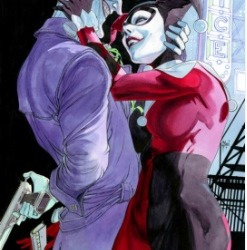
Mainstream:
-The code: Batman #570 (oct, 1999. part 1), Detective comics #737 (oct, 1999. part 2). This is what I was talking about batman and detective comics are combined though the numbers aren’t corresponding. It’s because the magazine detective comics began first. The story called “the code” was one of the most tender, funny stories. No trace of abuse.
Joker: It’s ok to call me Puddin’.
Some pages here
-Legends of the dark knight #126, detective comics #740 (both feb. 2000) by Gregg Rucka: you have to read them combined. I think this was the most abusive you can find in comics and the next one of course. There isn’t anything implied you can see it and its very bad. Please notice the date, it was written almost at the same time that the fluffy “the code”
-Batman #573, shadow of the bat #93 (both jan, 2000) by Gregg Rucka: The majority of the images really showing abuse are from this one and the former.
Why the difference? The writers, whenever Gregg Rucka is the author Joker is abusive cause Rucka uses Harley like a sidekick no really his girlfriend and this writer’s Joker is every second shooting someone. BTW Rucka has said he didn’t like Joker and he wanted to kill him but DC didn’t let him.
Wait…what about “suicide squad”? Just now we aren’t talking about N52 universe (since 2011). Maybe you don’t know what’s that so we’ll cover it later.
-Harley Quinn (2000-2004 and Linked to Mainstream): They used the matter or Joker trying to kill her, no real abuse here and she tries to kill him too as revenge. This comic is important because after many of its ideas were applied in other comics (specially N52). In fact they created a development of character where she reached a kind of equality with Joker, maybe the first time they used a development of the subject in the world of comics but there wasn’t abuse.
well…in the episode 1 he hit her and kicked her but a)- This Harley is so strong could carry him in arms :S and she did so :D b)- She threw him into a big neon sign for doing so.
After a second writer in HQ made up one of my favorite JokerHarley stories, and very funny. pages here.
-Batman adventures/Gotham adventures (1992-2004): The comic is directly linked to the cartoon, there’s not abuse at all they usually show their relationship as something funny and cute but they made some references after 1999 that I want to explain.
Gotham adventures #10 (march, 1999) and #14: One of my favorites stories because it was hilarious but shows a twisted but sweet relationship. They fight each other but writers tried to make it in both ways =_= yes, that was their solution
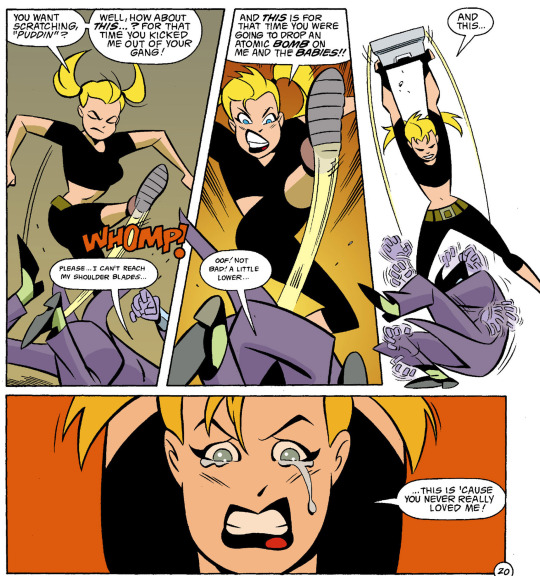
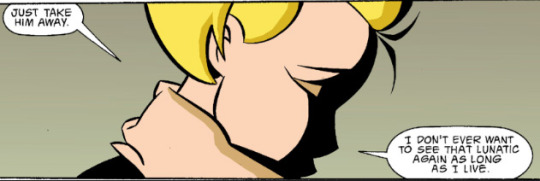
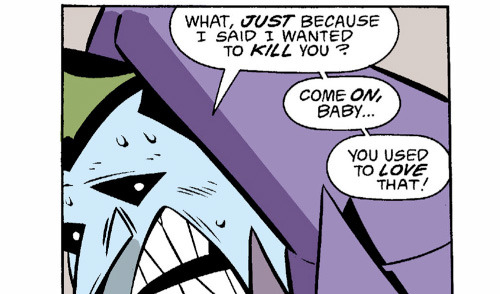
Curiously she didn’t mention that time he threw her through a window so no reference to mad love but the strange answer of Joker is a reference to the origin in the mainstream because if he wanted to kill her that was a sign he loved her O_O Whatever, at the end she forgave him, just the reader could see he missed her but he wrote this on a photo.
“Harley baby, love you forever.” Link to see the picture
As result “Batman Adventures” is a continuity with the storyline of the TV show but without Mad Love.
A proof supports this opinion is “Harley Quinn and Batman #1″ (July, 2017) by Templeton, main writer in Adventures, the comic is new but with this panel here the writer was reminding us the state of the things in Adventures.
-The Joker - last laugh (oct, 2001): special, limited series. Joker thought he was going to die. Very cute story in that regard. here The last laugh
-Gotham Girls (dec. 2002): Special limited series 5 issues, really good but coming to business, at first glance it seems (because of the design and story) it happened in the continuity of Batman Adventures but there’s a trick. Gotham Girls wasn’t created as another chapter in Batman Adventures, but it is a comic sequel/adaptation of a series of animated shorts written by Paul Dini with the same name.
The series by Dini didn’t have references to Mad Love but the adaptation by Paul Storrie did have them.
The vol 3. shows harley’s story as in Mad Love, abuse included, they used some panels extracted from there.

-Harley and Ivy (2004): No real references. Limited series by Paul Dini
-Batman confidential (2007): Madmen and Lovers: Confidential has its own continuity and my favorite origin story, just fluff here.
https://timespacehigurashi.tumblr.com/post/126947551376/batman-confidential-episode-7-joker-and-harley
Mainstream:
-batman 663 (mar, 2007) by Grant Morrison: his style is absolutely different and he did a strange mess but his Joker wasn’t abusive, he was totally crazy and murderous, I meant MORE, and Harley worshipped him almost literally o.O but here they said clearly “he cared about her” and at the same time harley shot him down xD.
If you want to know more about Batman #663 here. It’s a comparison with its variant in N52 but just read the 663 part to get what happened.
-Detective comics 831 “kind of like family” (Dini, jun, 2007): Good story, no real mention of abuse, no exactly…but here Harley had made her mind about don’t be involved with him again and was reformed. A new character, the second ventriloquist, appeared and she is supposed to have a bad relationship with scarface that is her other personality…It doesn’t make sense…forget it. It’s a long talk and Dini himself ���erased” it with his next work.
If you don’t read comics skip this (About Dini, Morrison and logic):
In first place this episode is dated jun, 2007 and 663 (Morrison’s) was in march, it’s confusing because the last time we saw Harley (2004 ending of “Harley Quinn”) she was in arkham and paul dini began from there writing a story about her getting out of Arkham and reformed (”kind of family” in June) BUT Morrison used the character BEFORE, in March and in Morrison’s she’s far away from sanity just a couple months of difference :-/ (*cough* continuity staggering *cough*)
It’s more or less that Dini ignored Morrison xD Well, in the continuity after a while when we saw Joker again he was his normal himself like nothing occurred (his face wasn’t damaged like It was in batman # 663) so everybody ignored Morrison and then DC tried to explain it saying what was writen after #663 corresponds to BEFORE in the time xDD (If somebody thinks I’m wrong expose it to me please.) and BTW It’s impossible since a reference was made about this chapter (663) in Gotham sirens (2009), in other words Batman #663 by Morrison can’t be the future cause Gotham Sirens calles it the past.
-Detective comic 837 (Dini. oct. 2007): she’s living adventures, no comments
Then the order in the general story for Harley according to the mainstream is this:
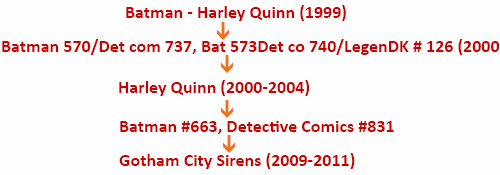
-Gotham sirens (2009-2011) by Paul Dini (just first 11 issues minus the #8): In sirens this is a weird topic and long to explain. There’s one reference, a comment of P.I and selina, chapter 1.
selina :“he’ll be calling for your money the second he hears about it”
Ivy: “then you’ll be skipping out the door for another round of abuse, humiliation and regret”
This is a reference to the dynamic in “Harley and Ivy” the episode in the tv show where joker took adventage of her for her money, one could think when they said abuse, they were talking about brutality like mad love but it results that Dini likes to use “abuse” meaning distinct things in distinct works. o.O
In Sirens by Dini “abuse” is not what appeared in Mad Love but something slighter… more like He’s a jerk kind of thing.
Understanding this is a little difficult if you don’t follow Dini’s work but Sirens itself helps you providing some context
The ending of the chapter 6 is a second reference to “Harley and Ivy”. Both, the ending of the episode and the comic handled the matter lightly, treating it with humor,
In the original episode Harley isn’t an beaten wife but the object of her love is inconsiderate and he wanted to steal her money too. Ivy called her a doormat.
So Selina and Ivy meant he takes advantage of her, however Sirens established Joker does care about her at the same time, in the chapter 5 Ivy said this:
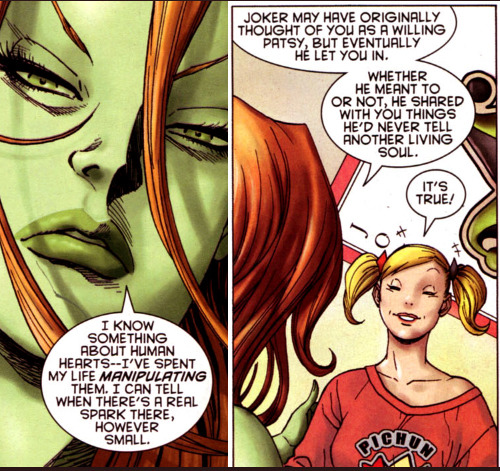
Chapter 2 showed this one here.
More context: Dini made up a background for Harley’s family was never written before. While Mad Love was tragic and the story of the downfall of a girl who would have been somebody Sirens is optimistic. Her family was so a disaster that she’s happy with her new life and identity. It isn’t dark, they’re just disagreeable people.
Harley has daddy issues, no, seriously! Her father is …Joker.
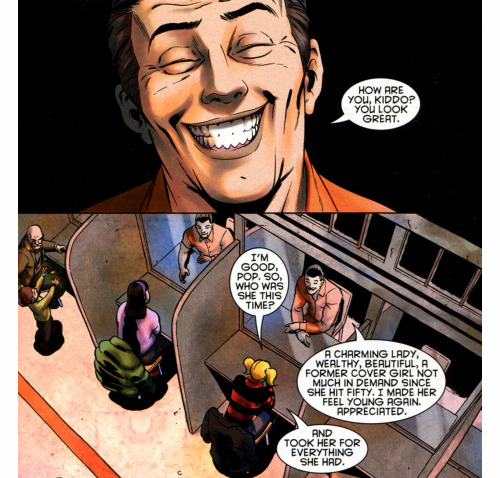
Her father is a swindler who takes advantage of women and get their money :O So Harley is used to deal with liers on a daily basis and her family’s used to have relatives in jail. here
The writer is trying to compare her father with Joker, and her old life with her new criminal identity, saying “It isn’t so bad”. From Harley’s point of view at least Joker is a man of one woman and he doesn’t have kids from several mothers like Harley’s brother. For Dini usually the little domestic sins like infidelity are the worst.
Again another writer that is very different wrote the last arc of Sirens though sometimes wrongly attribuited to Dini. His story it’s darker and ignored the previous chapters, this time Ivy changed lines and said “he doesn’t love you” (chapter 24). Harley said “after all the abuse, betrayal and dirty tricks” (chapter 19) but they keep comparing harley/joker to Selina/batman and being kind of romantic. So what was that? : / What we saw after wasn’t an abusive relationship (He even called her Ms. Q once), they were a team but they were together doing horrible things, I mean, the guy was very nice and all but he was stabbing orderlies. Here the reason Harley must not be with him is simpler, cause he does evil things :O
Some pages here here
And then again the weirdest twist in the final 2 chapters (2011) Ivy explained how Harley is very sick and they carried her obsession to proportions weren’t seen since her origin in 1999…ok, maybe Morrison’s Harley in 2007 maybe not.
Extra but canon too :-/
-Countdown to Final crisis (Dini, 2007-2008): Ultra crossover and a temporary event that stopped the normal progress of the continuity for a long while, maybe my least favorite story by Paul Dini (he was the main writer, like a director). Here…well…Harley became an amazon (you know, like wonderwoman. XP -_- ) because…she was reformed…no abuse here or signs of it are mentioned. (If you know of something just say it).
-Crossovers/several universes: Usually just fluffy things I haven’t found some abusive story in them but yes, there’re a one or two really creepy. Interestingly I don’t know about any universe where Harley is a boy but Joker was a girl 2 or 3 times O.o and always in love with another version of Harley…I guess AUs are fanservice XP.
-Batman Strikes! (2005): Linked to the cartoon “The Batman”, fluffy and cartoonish.
Well, that was PRE-N52…
Game based comic weren’t included cause those have their own continuity that isn’t accurate in regard to the games and the relationship is different between one and another
conclusion
Because of the amount of writers the relationship is never exactly the same and in the majority of the cases isn’t abusive besides being realistic one writer could have written the characters and their relationship different in different occasions (that’s why you can find interviews where they say it’s abusive and he doesn’t care for her and then another where they say how much he loves her) and It’s not really possible put together all what was written and saying it’s the same character always (Joker changes and Harley too) sooo that’s why you don’t hate women if you ship it, thanks. :D
My God, I think I’ve read every single issue with harley and Joker but who knows there’re so many. @_.@
Perhaps I’ll write another article for N52, We’ll see.
If you have a question, just ask.
Although this is an article about Harley’s origin in N52 comparing it with Mad Love.
https://timespacehigurashi.tumblr.com/post/136218691876/harley-quinns-origin-in-n52
#Harley Quinn#the joker#joker#joker x harley#harleyxjoker#Harley x Joker#jokerharley#Mad Love#DC comics#comics#batman
110 notes
·
View notes
Text
Planned Streams
Since the last stream went so well I plan on streaming some more movies and shows if I have time! I’ve got a lot of social and adult things on my plate these winter months, but I really do want to share some of these shows with everyone!
Sectaurs
A 5 episode super weird scifi cartoon from the 80s about bug people riding giant bugs they’re psychically linked to in a post-apocalyptic feudal society. Cheesy as hell but super creative and ridiculous. @estranged-fossil and I have OCs and we’re looking to rope somebody else into some light RP shenanigans possibly HWUR
Vampire Hunter D & Vampire Hunter D: Bloodlust
Two movies. Per a conversation with @theworstbear, I somehow haven’t seen any of the Vampire Hunter D movies. I OWN ONE OF THEM ON DVD. A travesty. Vampire Hunter D is an anime adaptation of a novel series about D, a mysterious otherworldly vampire hunter in a... Scifi/High Fantasy/Post-Apocalyptic world. Weird and good, the original movie is old 80s anime and the new one, despite being from 2000 follow suite style wise.
Cybersix
A 13 episode urban fantasy cartoon from my childhood about a mysterious woman with ties to illegal science experiments who disguises herself as a male teacher at a local school during the day. Kind of dark and sad but very good. One of those shows that was kind of burned into my memory at the tender age of eight.
Hellsing Ultimate
The 10 episode anime adaptation of one of my favorite manga ever, the ultra violent, super profane, downright blasphemous story of Alucard, servant of Integra Hellsing, literally the most powerful vampire ever, and newly fledged vampire Seras “Police Girl” Victoria as they fight Nazis in a global conspiracy to continue the second world war. REALLY REALLY VIOLENTLY FIGHT NAZIS. I cannot describe to you how awful this anime is it’s unreal. Tons of fun but of all the things to stream this is the worst and you should proceed with caution if violence of any sort is not your jam.
Other shit maybe IDK
Blue Submarine No. 6 (anime series), Deep Blue Sea (movie), Kagewani (anime AGAIN), Berserk (old anime series), Doom (movie), Princess Mononoke (anime movie), Dungeons & Dragons: Books of Vile Darkness (live action movie), all the bad movies I own because I love them.
6 notes
·
View notes
Text
Classic Reviews: Storm Hawks
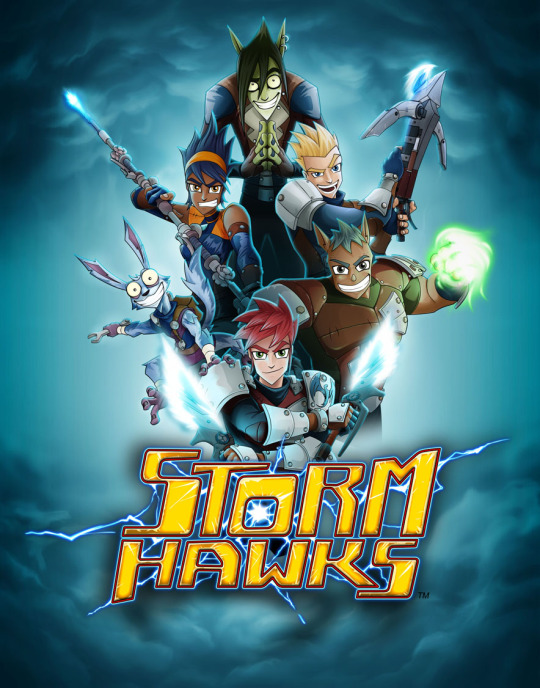
Since it celebrated it’s 10th anniversary this year, I’m counting it as a Classic Review. Gosh darn I feel old....
Anyway, here is my review of Storm Hawks! Does it take to the sky as high as their airships or does it fall down like a fat wallop? Let’s find out!
During the late 2000s (least before the 2010s), kids media entertainment went through another “extreme phase” in which shows with lots of action and “coolness” came out like hotcakes. This is how Storm Hawks came to be. It was released May of 2007 on Cartoon Network and ended it’s first season at the end of that year. (Though, in some regions, it did show up earlier on Kids WB.) Then in September of 2008 a second season was released that ended in April 2009. I was actually able to watch it on Jetix sometime then.
Setting: Storm Hawks takes place in Atmos, a series of lands called “Terras” are scattered around. The Terras are kinda like other countries, each having their own culture. Each culture is very different in terms of even species, as there are anthropomorphic creatures such as Wallops, which resemble anthro rhinos and Blizzarians, which resemble dog like people. (with Canadian accents for whatever reason...) Below the Terras are the dangerous Wastelands, so called because there are fiery pits, nothing grows there, it’s miserable and the only creatures that manage to live there aremonsters. (so literal hell pretty much)
The Terras are scattered around up high on mountainous regions, so the only way to get around is by flying, thus people fly motorcycles that can also double as flying machines and of course, large airships. The energy that powers the machinery and even weapons are crystals, which have stranger kinda magical energies. It’s not exactly magic but they just somehow possess the energies and each do different things, depending on the crystal.
Each Terra is also guarded by a Squadron with the leader of each squadron called a Sky Knight.

Story: An evil ruler named Master Cyclonis and her servants, the Cyclonians, threatened Atmos. The original Storm Hawks led the Squadrons in a war against them, but were betrayed and defeated by one of their own (later known as The Dark Ace). Ten years later, a boy name Aerrow and his friends Piper, Radar and Finn live together as orphans, until a Cyclonian Youth Squad threatened them. One of the members was a wallop name Junko. Three men approach Aerrow and give him a key and map to the Condor, stating that he is the last descendant of Lightning Strike, leader of the Storm Hawks, and thus inherits leadership. However, because of them Aerrow and his friends are captured.
The leader of the Youth Squad radios Snipe and is told to throw them into the Wastelands. Junko volunteers to do it, but lets them go when the others are not looking, as he does not want to be a bad guy. They manage to find the Condor in the Wastelands, and it has already been repaired by Stork, who has lived there for years trying to find the key. Stork had escape from Terra Merbia after the Cyclonians attacked. They give Stork the key and eventually agrees to be their carrier pilot. Eventually Junko joins them and all of them become an unofficial Storm Hawks.
They try to join in as a official squadron but fail because they’re too young to be according to the books. However, as their adventures and helping to fight the Cyclonians continues on, they are at least recognized as a squadron by the other terra squadrons.
So how does this series hold up? Well, it actually is a fairly decent series. Yes, it does try to be “extreme” here and there, but in some ways, it kinda also makes fun of it, mainly through Finn. They do have the “cool music” that sounds more like James Bond music and the tricks with the skimmers (the flying motorcycles) and shoot, even the hair styles say “I’m extreme!”. However, as far as that goes, it doesn’t always smack you in the face with it, least not all the time. There is some charm to the series as well as the characters and the world they live in.
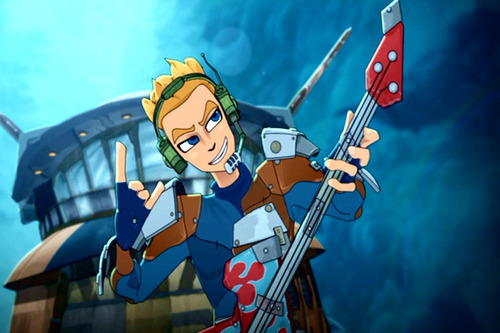
The characters themselves in someways, are kinda stereotypical but are fleshed out and will feel like real characters than just types more often than not. They do develop and they do act out of their usual tropes. Aerrow (lead guy) acts like a kind hearted character. There really isn’t that much to him, he’s just nice, adventurous and yet cautious at the same time. Compared to his friends, he may seem bland at times but I think he kinda brings a little bit more balance. He’s the average joe of the group, that keeps everyone grounded.
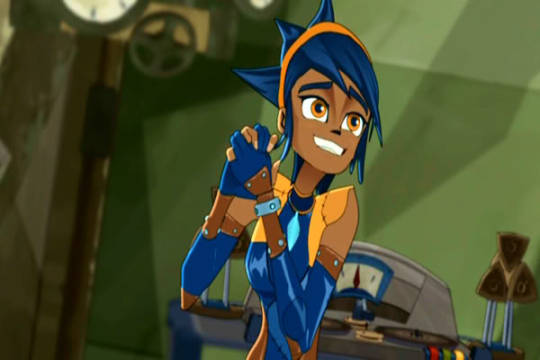
Piper is very smart and is the one that comes up with all the plans and strategies, as well as gathering crystals, studying them and building them into anything that can be of use. She’s also very tough though again, has her own insecurities that make her feel balance and real. She does take pride of herself but does get scorn and when this happens it does hurt her, though she never stays sad for too long. She actually is my favorite character with Stork coming in as second. Speaking of which there is a thing in the fandom where some people will pair her up with Aerrow and some will pair her up with Stork. I’ll get to that in the moment.
Then you have Finn, who is the “cool kid” of the group. However, he is funny to watch and I never found him annoying surprisingly. He does get over the top and sometimes endangers the crew but he does realize his mistakes and does show he cares for others.
Junko is the big guy with a big heart. Much like Toru from Jackie Chan Adventures, he’s small for a wallop. I would say I would hug him because of how sweet he can be, but I would get crushed as all wallops are very strong and even for being smaller than most, is still pretty capable of doing damage. Junko gets his name probably because he has a stomach that can withstand anything, including things that may not be edible to most people. Though, this maybe a thing with wallops as a whole.
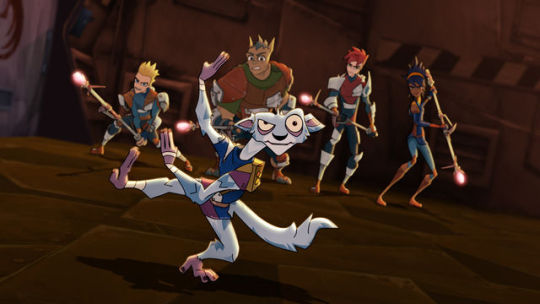
Radarr is well...a monkey rat thing. I dunno. He’s like a cross between a Merb and a Blizzarian. He basically is what Abu is to Aladdin in the Disney movie for Aerrow. He’s usually with him on his shoulder or beside him. Radarr is not exactly a pet but acts like a character despite not being able to speak. I don’t think too much of him. Again with Aerrow, there’s not much to him, though he is intelligent and is able to actually fix things with Piper and fight, so there’s that.
Than you have Stork. Stork was the first emo before emo was a thing. He’s got the hair, the attitude and everything. He’s paranoid of everything (according to the creators it’s because his home Merbia is constantly attacked by storms and natural disasters every given second) and thinks of every horrible way that could happen to him and the crew. However, this is rather funny and he does calm down as the series progresses. He’s also very smart and knows anything about engineering and surprisingly useful facts about animals and the world around them. A running gag is that his inventions are never used the way he intends for them to use, but are surprisingly useful in that way.
His design is also very interesting. He’s kinda mix between cute, creepy weird and slightly handsome at the same time. I know that’s kinda weird to say but that’s the best way I can describe him. He’s definitely original looking, kinda.

Now the thing with PiperXStork and AerrowXPiper. The latter is obvious because there are moments where it seems they do care about each other, especially towards the end of the series.
The PiperXStork thing I can see where people may get the idea. There are times where Piper outright expresses concern for Stork verbally or just by facial expression. Though I honestly think what’s going on with the expressions is that she questions where Stork’s loyalty lies. There’s times, mainly earlier in the first series where he acts like he doesn’t like them at all. In first episode, he wanted to leave with the Condor while his friends were in the Wastelands battling Cyclonians. It kinda made me wonder if he would betray them. However, he does show acts of selflessness and comes to their aid right away on his own.
Put it short, Stork’s a coward but not a big jerk. He does have a heart and even tries to be comforting or show concern when he thinks his friends are hurt or endanger. Piper just questioned where his friendship stood at first. After that, her concern is understandable as Stork does stress himself to the point of being crazy, on some occasions.This is why I like him and just see the two as good friends. Besides, it’s revealed that he’s actually in his 20s. O.O Yeah, no thanks.
As for AerrowXPiper I don’t ship em. Like I don’t hate the ship but I don’t hold strong feelings for em. They’re cute at times, but I think it was just best left hinted and not a real thing.
That’s not what this series is about. It’s about heroes forming and connecting a bond with others and defeating evil for the greater good. It’s an adventure with great characters in a world that is amazing actually. As well as a mix of slapstick and dry humor that matches my tastes. The animation can be choppy with the characters at times and the anatomy can be distracting sometimes, but the backgrounds and the world they live in is really interesting to look at.
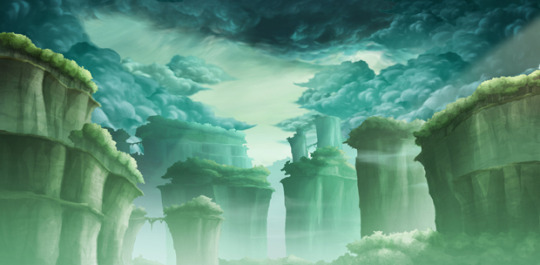
Some of the backgrounds and effects are really nice and the details they are willing to put in the series is fascinating at times. This series does have a bit more passion than a lot of action shows out at the time
As for the villains, they’re also pretty good and memorable. The only one I don’t like is Ace, mainly because he’s just not interesting to me and the rival between Aerrow and Ace gets old fast.
Overall, Storm Hawks is a great action series with charm, adventure, good humor including some slapstick and fun loving characters. The series can get a little too much with the extreme thing, but does tone it down when it’s time to focus on the story and characters.
I rate Storm Hawks an 8 out of 10 stars. Form your own squadron, park your skimmers somewhere and give it a watch!
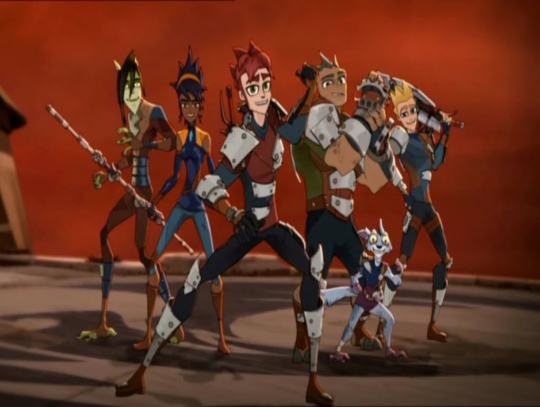
8 Stars
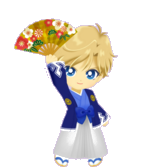
Level: Great!
16 notes
·
View notes
Photo
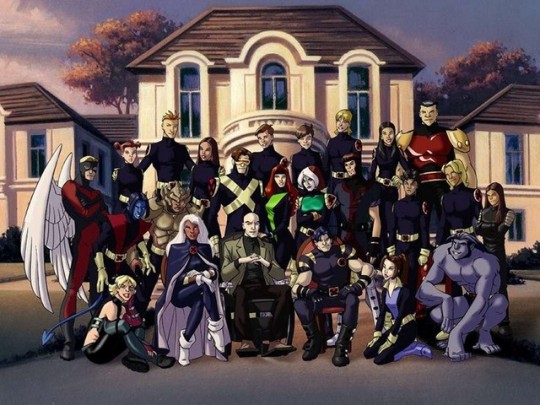
X-Men Evolution Review - 3.5/5
This is a series that came out from 2000 to 2003 (gosh we're getting old now, huh?) on Kids' WB. It had four seasons - which might hint at it having been a success (seriously that's remarkable for a kids cartoon on this sort of subject matter). If you told me the premise - taking the X-Men and making them younger - I would have groaned aloud. On paper (to me) it seems like a bad idea. After all, the fact the X-Men were college-aged was kind of the perfect balance that made the comic series so great to begin with. But they managed to pull it off in this show quite well.
That's not to say it's all great stuff here.. not all of it was. While I really liked the introduction of X-23 and Gambit later on, there were other X-Men staples (is X-23 a staple now?) that just didn't seem to click for me. Even though I'm complaining (or about to) about the treatment - I think all in all the creators did a great job balancing things for their target audience. Seriously, this show tried to do a lot and, while it didn’t really accomplish all goals, it does a decent job (more on that later).
While we're discussing characters, It was a little weird having Logan and a handful of others be the adults while Jean and Cyclops were basically kids. This completely changed the dynamics of their interactions (and it would have been really awkward for Logan to have a love-triangle with Jean for example). But the show had to have some adults for dramatic tension I suppose (such as Storm's now-nephew Spyke running away and joining the Morlocks).
The show was really geared towards the teen audience, so the Mystique/Rogue and Magneto/Scarlet Witch story-lines were really hammed up for mommy/daddy issues (which got a little old, but I was 20 when this came out so it probably didn’t resonate with me as much as the younger crowd).
I mean parent/child issues happen to some extent in the comics so it's not out of place really, but it got a little old. I guess the part the series jumped the shark a little was how Rogue interacted with Kurt and their mother in the later seasons (I’d discuss it more but don’t want a spoiler). Some of it was canon and some of it was a little bizarre. The Rogue story-line was saved for me by that awesome Gambit episode.
There were certainly various character treatments I liked. Scarlet Witch really benefited from the dark/goth look and teen angst (I mean it was really done perfectly in my opinion). Toad, while mostly comic-relief, was a lot cooler in the cartoon than on the comic pages (at least what I've read of him). I also really liked how Blob was more useful as a big strongman and Avalanche was almost a respectable super-hero/villain (although the episodes seemed to have been skewed situation-wise to make that happen). Mystique was damned cool as ever - as was some of the guest villains (like Omega Red). Boom Boom was adorable and I was really happy whenever she showed up.
The Brotherhood were written to be kind of petty without Magneto. That was kind of their deal and I get that. But did Quicksilver have to be such a mindless jerk? Most of the other characters had pretty believable motivations. When it comes to Quicksilver and Toad, it seemed like their motivation was that they were petty criminals. And I just never though Quicksilver was slow-witted (see what I did there?). Compare to Avalanche - who actually was a pretty believable character.
First season gets a pass because I was riding that nostalgia train the whole time. And usually series like these have to play catch-up to get to the good stories anyways.
Second and third seasons were decent, but not very memorable (we did get Jubilee finally). I guess this is where the show really existed for me mentally. It was a slice-of-life style show with the mutants as kids.. maybe a life-lesson here and there for the kids to be tossed in with guest appearances from X-Men characters. Rinse and repeat. I could have enjoyed the show without some big story arc (and it seems like they had to try and hit the highlights - like the Trask/Sentinel program - but never really committed to actually giving it time). But they had to go there with the Apocalypse story-line (why not Mr Sinister or something smaller-scale?). Honestly I was kind of glad that the Trask stuff ended - as I really felt that bogged down the 90′s Fox show too much.
I can't say I was really happy with the fourth season - as they started by bringing in Apocalypse toward the end of season 3 (which was exciting but it would have been better as a tease rather than them going for it in a half-assed way). The writers tried to resolve the very ambitious story-line with about a third of the episodes (way too few). First of all, that story-line deserves more than this send-up and the way they wrote it was that basically everyone just left Apocalypse alone for half the season and all of a sudden resumed the story. It was a little ridiculous. I'd have preferred that they just focused on Bayville for the last season and left that one alone. I guess it gave a good excuse for everyone to join forces (which I’m sure was the point), but it just came off as weak - especially the season finale.
So, in the end, could I recommend this to anyone? Sure. It’s a very-entertaining series - especially if you’re an X-Men fan. And it’s not overly for kids, but it is geared toward them more than the 90′s show was. But here’s the thing that most of the creators of these shows don’t realize: the 90′s show was just fine for 12-14-year-old me. I got the concepts. It felt relevant.. as just good old sci-fi instead of teen-specific sci-fi.
8 notes
·
View notes
Text
Muppets Now Episode 3 Review: Getting Testy
https://ift.tt/2PSK8zL
Muppets Now continues to roll on with their third episode. In what’s supposed to be a modernized update of a beloved variety show is starting to fail when it comes to actual variety. The whole setup for Muppets Now hasn’t been perfect, but it’s been fairly sound. Four segments in the form of online shows are framed together thanks to quick bits of Scooter tossing them up online with his “Rainbow Connector.” Considering it’s the variety of characters, talents, and behaviors that make the Muppets work, this channel surfing style can definitely succeed if done correctly.
The problem is that after three episodes, they haven’t done too well in terms of mixing things up. For instance, the second episode brought back two segments from the first episode (the ones starring Miss Piggy and Swedish Chef) and that’s fine. It’s just that episode three brought back all four segments from episode two. These episodes aren’t even themed, so it’s not like they’re bound by what order and batch to release these in. The only reason they probably couldn’t shake things up is if we’re really getting six segments of Okey Dokey Kookin’ and Lifestyle with Miss Piggy throughout six episodes.
And man, I really hope we’re not.
This time around, the framing device is so perfect a concept that I’m surprised it took three episodes to get there. Scooter is told that he needs to show each segment to a test audience and said test audience is none other than Statler and Waldorf. It’s an awesome idea that’s only hindered by how quick these in-between segments are and how one of them is just the two sleeping instead of giving us an easy zinger.
Our first segment is Okey Dokey Kookin’, where this time Swedish Chef is up against Chef Roy Choi. Outside of host Beverly Plume undressing Chef Choi with her eyes, there’s nothing especially new about this bit. The idea of a celebrity chef making a competent dish while Swedish Chef is off on the side being incompetent has been run into the ground and there’s no fresh take on it here. At least last week had the novelty of Danny Trejo bringing his charisma to the table.
The next segment is Muppet Labs. Like last week, Beaker and Bunsen are outside doing something that’s supposed to be genuinely silly but just slightly educational. Their idea is to use a catapult to fire pizza and pizza-related foods at a target wall. They’re joined by pizza delivery guy and celebrity guest Al Madrigal whose main task is extorting money from Beaker. It’s weird how we’re so used to seeing Beaker get brutalized by experiments, but something seems kind of over-the-line about Bunsen forcing him to pay hundreds of dollars for pizza and over-tip.
They’re trying to go Gallagher on this bit, but it never really works. It looks like they filmed the footage, didn’t get the messes that they wanted, but pushed it forward anyway due to deadline.
Miss Piggy’s Lifesty/Lifestyle bit is next, where once again, Linda Cardellini pops in and does absolutely nothing. It’s getting rather impressive. This time, the topic is about relationships, which gives it a shot in the arm, because we get to see some prime Piggy/Kermit dynamic. Kermit is brought into Piggy’s Zoom call and comically goes through different lengths to distance himself from the conversation, including pretending he’s going through a tunnel despite the fact that he’s on camera.
Read more
TV
Muppets Now Episode 1 Review: Due Date
By Gavin Jasper
TV
Muppets Now Episode 2 Review: Fever Pitch
By Gavin Jasper
Now, for an episode that does the same sketches as the previous week, the biggest improvement is the order. Starting weak and ending strong is a better structure and we end strong with Pepe’s Unbelievable Game Show. Once again, Pepe the King Prawn takes a game show setting and pushes it into his own brand of chaos while being charming as all get-out. You know you’re in for a good time when Pepe immediately starts the show with the lightning round because of his whims.
This also gives us the only truly great improv gag this week when Pepe gets one of the contestants to talk about his dead dog, much to Scooter’s horror. The Muppets on Disney+, everyone!
I really wish the show had more of the energy of the Pepe game show stuff. It’s so fast and frenetic that only way after the episode do I realize, “Of course Pepe abruptly excuses himself before Big Mean Carl shows up. They’re played by the same performer!”
We’re halfway through the season and it’s just okay. It’s kind of funny to me that a show that’s constantly joking about how reluctant it is to get constructive feedback really does need that feedback to move forward. At this point, I’m more interested in a potential second season when they know what works and what doesn’t.
I don’t know. Muppets Now is making me think of that crappy Avengers cartoon from 2000 where they went out of their way not to include Captain America, Thor, and Iron Man for the most part despite identifying them as the “big three.” Just replace them with Kermit, Fozzie, and Gonzo, who have done so little through the last three episodes.
The post Muppets Now Episode 3 Review: Getting Testy appeared first on Den of Geek.
from Den of Geek https://ift.tt/30XhEeB
0 notes
Text
Here’s How the Cartoon Design Trend Caught Fire and Why Every SaaS Is Rebranding
I’m sure you’ve noticed this ubiquitous illustration style by now. Depending on who you ask, these cartoons are either fun and whimsical, or strange and faceless. Maybe you see them as friendly-looking doodles … or maybe you see them as just plain weird.
Whatever your opinion, one thing is for sure: these little buddies are everywhere right now. For better or worse, they have completely taken over the visual identities of many high-profile SaaS brands.
Now, many marketers are wondering—how did this happen? Why are there so many similar-looking illustrations on so many different websites? How did all of these brands decide to use this style at the exact same time? And doesn’t this go against the very idea of positioning your brand as something different?
For example, Jimmy Daly, Marketing Director at Animalz, recently called out this design trend on Twitter. And while he says he doesn’t dislike the style, he also isn’t sure how it got to be everywhere at once.
i genuinely respect all of these companies and use these tools but saas websites are perpetually homogenous. what gives?
— Jimmy Daly (@jimmy_daly) June 4, 2019
Here at Unbounce, we recently went through a rebrand of our own. And while we considered illustrations, our design team ultimately decided to go in a different direction. Instead of flat, geometric shapes, we chose to use custom photography to help us put our customers in the spotlight. (Although we’re not alone—custom photography seems to be another growing design trend for SaaS brands.)
But going through the long, long, very long process of a rebrand got us thinking. As marketers trying to stand out in an increasingly competitive industry—is it bad for us to follow design trends? What inherent value is wrapped up in visual branding? Is it worth a heavy investment in design to look different? And how vastly different can we all truly be?
Let’s dust off our old-timey magnifying glass and investigate…
Image courtesy of the Stubborn Free Illustrations Generator.
Why Marketers Are Obsessed with Visual Branding
In our heart of hearts, I think every marketer is a “creative” type. We were the kids in school doodling on our notebooks, coming up with ideas for the next great Goosebumps novel, or filming half-baked comedy skits using our one friend’s video camera. (Thanks, Brad!)
So really, it makes sense that we care so friggin’ much about the way our brands look. The logos, fonts, photos, illustrations, and other visuals we use are all opportunities for us to show off just how creative and different we can be. We want you to be impressed when you look at our website—or any other part of our brand’s visual identity, for that matter. It’s in our DNA.
According to Sabrina Chan, Interactive Designer at Unbounce (and huge contributor to how the Unbounce brand looks today), this is part of the reason why companies seem to rebrand so often.
Coming up with a new visual brand is absolutely exciting, whether you do it by yourself or with the help of an agency. It’s a great creative challenge because—unlike most other marketing projects—you aren’t forced to play within a sandbox, or follow a specific set of rules. When you create a new visual brand … you actually get to shape the sandbox itself.
Marketers also obsess over visual branding because we’re under constant pressure to keep up with the times. (And the web changes fast, yo.) One second we’re all using gradients on our buttons and adding drop shadows to our form boxes, and the next we’re making every page element as flat as a Kansas-style pancake. If you’re still using styles that have fallen out of public favor a few years after the fact, it can raise a few eyebrows.
Sabrina says the goal is for your brand to either fit in or stand out—but never fall behind.
Nobody wants their brand to look like it hasn’t been updated in years. You only get one chance to make a first impression … and most marketers and designers will do anything to make a good first impression. Especially if your competitors are all out there looking fresh and up-to-date.
At the same time, this obsession with visual branding can come with a heavy price tag. Whether you hire an agency to rebrand for you or work with a team internally like we did at Unbounce—the process can take many, many months. It’s never as simple as making “just a few quick updates to the company logo.” You almost always need to scope out a big chunk of your marketing team’s time, budget, and brainpower.
According to Andy Crestodina over at Orbit Media, a “fancy site from a big web development firm” can easily run you up a bill of more than $100,000.
A graph created by Orbit Media shows how costly a new website or rebrand can be.
Here at Unbounce, we spent over half a year doing research, running impression tests, creating mockups, and iterating on our new brand before we launched. And while we have gotten (mostly) great feedback on the finished results—it can still be really tricky to connect the design’s impact of a new visual brand to actual ROI.
Sure, there are lots of ways to calculate how well your website is converting. But can you attribute that to the branding itself? It’s not so simple to draw a straight line between your looks and your bottom line.
But Your Brand Does Matter—Maybe Now More Than Ever
Even if you can’t easily attribute direct revenue to your visual branding, at least you can take comfort in the fact that almost every marketer agrees it’s still pretty dang important. Potential customers take one look at your brand and form an instant impression—long before they explore your products or check out your pricing.
Here’s what Vicky Bullen and James Ramsden of the design agency Coley Porter Bell said about the benefits of visual branding earlier this year.
Over the last few years we’ve seen many brands and their identities evolve into a state of homogenization … [But] many categories are having their traditional ‘design codes’ turned on their head as new or artisanal, challenger brands come along and create a completely new way to interpret a tired category.
They were speaking specifically about food brands, but the same line of thinking can apply to many software companies as well.
Because in the world of SaaS, branding is particularly valuable. The space is so saturated with competition (there are over 7,040 marketing technology companies alone), that most companies are eager to stand out from the competition. A unique and authentic brand is a great way to elevate your software over everybody else.
On the The Re:Growth Podcast, Dave Gearhardt, VP of Marketing at Drift, even went so far as to say that branding was a key differentiator that helped their team to succeed.
We knew in order to win, we needed to do things the opposite of how everybody else was doing it. We needed a different way to stand out. And for us, that was brand.
Chris Savage, CEO of Wistia, has also been exploring the importance of branding in a new original series called Brandwagon. According to Chris, branding is more important today because traditional marketing tactics are breaking down.
A more fragmented and less measurable customer journey means that if customers aren’t positively disposed to you before they begin their product search, you’ll never make it to the consideration set. Consumers now have access to all the information they could want on your product/service at their fingertips, including how it stacks up against competing offerings … [so] we need to move beyond solution-based value propositions.
But design trends in branding aren’t anything new, either. As part of our research for this piece, we dug into some of the many different styles that have flared up over the years.
Timeline Sources:
Business Insider, AIGA Design Conference, Codeburst, Web Design Museum, Instani, Line25.
Image Sources:
Bass Brewery’s original logo. Digital image. Zythophile.com. 28 June 2013, http://zythophile.co.uk.
A vintage ad for Coca Cola from around the late 19th or early 20th century. Digital image. Smithsonian.com. 29 March 2017, https://www.smithsonianmag.com.
Michelin Man educational advertising, circa 1907. Digital image.
LogoDesignLove.com. 21 December 2012, https://www.logodesignlove.com.
Betty Crocker, 1955. Digital image. PBS.org. 15 February 2013, http://www.pbs.org.
Apple.com screenshot from 1996. Digital image. The Telegraph. 2 September 2009, https://www.telegraph.co.uk.
Website design from the early 2000s. Digital image. UX-App.com. 23 July 2018, https://www.ux-app.com.
Airtable custom SaaS illustration. Digital image. InternetFolks.com. 22 October 2018, https://internetfolks.com.
So Where Did This Cartoon Design Trend Come From?
Travel in time with me all the way back to January 2017. Barack Obama was serving his last few weeks as President of the United States. Serena Williams was busy winning the Australian Open (while pregnant, no less). And a movie about sentient vehicles called Monster Trucks somehow made $33 million at the box office.
It was around this time that Alice Lee, an independent illustrator and designer, started working with Slack to help them create a new illustration voice and library. She partnered with their team to create over 40 separate illustrations that they could use in a variety of different places on their website and platform.
An example of an illustration on the Slack website.
Many designers point to these 40 original illustrations as the possible beginning of this current visual branding trend. And in a blog post on her website, Alice details where her original inspiration for these designs came from.
I wanted to look outside the tech industry for inspiration … I referenced much of Mary Blair’s legendary body of visual development at Disney for designing warm, whimsical characters. And it was hard not to fall in love with the ‘minimal realist’ compositional balance that Charley Harper strikes.
Another possible origin of this trend is Facebook. In 2017, the social media platform was also going through a rebrand of their own. Their team worked with a design firm named Buck to come up with a new style. And in a recent post on the AIGA Eye on Design blog, illustrator Xoana Herrera described her inspiration for the project.
I started to draw characters that were defined by their actions … Dancing with their open arms, bending their bodies to play the trumpet, for example … I wanted to portray that sense of joy we feel when we’re sharing things together in community, like celebrating a goal in a bar or singing a song with a crowd at a concert.
An example of the illustrations used by Facebook, featured on the Buck website portfolio.
We saw this trend continue to evolve over the following year. When Mailchimp pulled off their rebrand in September 2018, it created shockwaves that influenced the entire marketing community. The typeface! That yellow! The illustrations! It was like a breath of fresh air for an industry that was drowning in a sea of stock photos.
An example of a more abstract illustration on the Mailchimp website.
Here’s what Gene Lee, VP of Design at Mailchimp, said they hoped to inspire with their new brand.
With this redesign, we set out to retain all the weird, lovable elements that endeared our earliest customers to Mailchimp…We champion authenticity, originality, and expressiveness because it’s what helps us—and our customers—stand out. We hope to inspire them to be more bold and creative in their own branding efforts.
This is when the butterfly effect really started to take shape. Since September 2018, hundreds of SaaS websites have rebranded using a similar—albeit, less abstract—illustrative style.
Now, there are thousands of these flat illustrations turning up on stock photo websites, entire Twitter accounts dedicated to calling out this trend, and even mix-and-match design libraries that make it easy to create your own unique cartoon scenes.
Image courtesy of the Stubborn Free Illustrations Generator.
Why These Cartoon Humans Started #Trending
At this point, you’re probably wondering why so many companies decided to go with this Nickelodeon-esque style. And actually, there are a number of very practical reasons why these illustrations became popular…
They’re representative – With illustrations, the humans you show can come in all shapes, colors, and sizes. This can be an important distinction for socially conscious brands who want to make sure they’re being inclusive for all types of people and communities.
They’re flexible – A lot of SaaS companies struggle to show off their software using stock photos. (Let’s say you’re selling accounting software, for example. I hope you like messy desks with calculators.) Illustrations can help you represent complex or abstract ideas in a much more clean and simple way.
They’re scalable – You don’t have to have a pricey photoshoot for every new hero image. With illustrations, you can just iterate on a style or framework that you’ve already created. What’s more—you can use them to execute fast, which is a huge win for startups in growth mode who don’t have a ton of money to invest in branding.
They’re unique – I know a lot of the illustrations we’re featuring in this blog post look similar, but you can still see some wildly different approaches out there. For example, check out the style of a company like Officevibe and compare it to what Intercom is doing. Nobody is going to confuse those two companies based on their visual brands.
They’re full of personality – For SaaS companies in particular, this trend is appealing because of how much personality each image can contain. The illustrative approach harkens back to children’s storybooks, making the software seem more friendly and approachable. (Take a look at the Mailchimp website, for example, and tell me it doesn’t remind you of Curious George.)
At the Same Time, There Can Be Trouble with Being Trendy
When it comes to design trends, there are always potential dangers if you jump in without doing your research first. It’s almost never a good idea to change your entire brand overnight just because “everyone else is doing it.”
This is why Alice Lee, one of the originators of this trend, warns other companies to think things through before adopting a similar illustrative style.
I am often approached by companies who simply want me to reproduce work I’ve already created for past clients’ specific brands … But I do believe that to create an illustration identity that’s distinctive, new, and powerful, it’s important to take an intentional, process-driven approach.
There are other potential challenges with this trend as well…
These illustrations might not match your brand personality – Well, unless your brand personality is ‘Playful’ with a capital ‘P’. If that ain’t you, then these quirky cartoons might come across as inauthentic or off-brand to your target audience.
They might not be as scalable as you think – While they might be less expensive than custom photo shoots, unique illustrations also don’t come cheap. If you want non-generic doodles for your brand, you’re going to have to pay an artist to create them and have a plan in place for when you need more.
This style isn’t as unique anymore – If you jumped on this trend a year or two ago, you might have been ahead of the curve. Now, you run the risk of just looking like everybody else.
And while illustration can help make your brand appear more friendly, real photos of real people can be powerful in their own way. Alex Kracov, Head of Marketing at Lattice, explained in a Tweet why they moved away from illustrations.
Tried to buck this trend w/ the redesign that we launched today at https://t.co/gPtdvXY4wV We used to have the same illustration style, but as a People product, we felt the need to switch to photos of real humans. The CGI backdrop helps maintain the playful, approachable vibe. pic.twitter.com/F1tLaD7pCE
— Alex Kracov (@kracov) June 7, 2019
The bottom line is this: as marketers, it’s our responsibility to do our due diligence and discover what resonates best for our particular brand, industry, and customers. This is something Dan Cederholm, Co-Founder of Dribbble, talks about in a recent blog post.
My advice was to not worry about trends, but rather use the style best applied for the task at hand and stick to it. Go with what feels right for the problem you’re solving.
Image courtesy of the Stubborn Free Illustrations Generator.
Design Trends Are a Flat Circle
This illustrative trend caught on fire so fast that many marketers were caught off guard. But this is the type of thing that happens all the time in the fashion industry. Bell-bottom jeans, choker necklaces, lumberjack plaid—they all became massively popular, died down, and then came back around to being “cool” again. It’s the circle of life, folks. (Cue The Lion King soundtrack.)
Matthew Strom, Senior Product Design Lead at Bitly, noticed that more and more websites were starting to trend in a similar way, and he linked this idea to the economic principle of minimum differentiation. In short, most marketers and designers are going to put in the minimum effort and risk in order to succeed—and that means we’re going to end up making a lot of the same choices.
Here’s how Matthew describes the inevitable “same-ification” of the internet.
The convergence of competition to nearly-identical products is not just a coincidence: it is inevitable. It seems irrational, but the math is sound. This is an emergent phenomenon … even if they try to differentiate themselves, all websites will eventually flock together.
So hey, maybe there’s nothing inherently wrong with following a design trend if we’re all gonna end up looking the same anyway. Marketers use up a lot of collective brainpower trying to create unique visual identities that set them apart—but perhaps we’re all just fighting a losing battle.
Because in the end, there’s no real evidence that any design trend—whether it’s illustrations, custom photography, or even 3D images—is good or bad for your brand.
You just need to make sure that whatever decision you make, you make it deliberately.
from Marketing https://unbounce.com/design/branding-cartoon-illustration-design-trend/ via http://www.rssmix.com/
0 notes